All publications

newsletter
·
10 min read
The changing drivers of LLM adoption
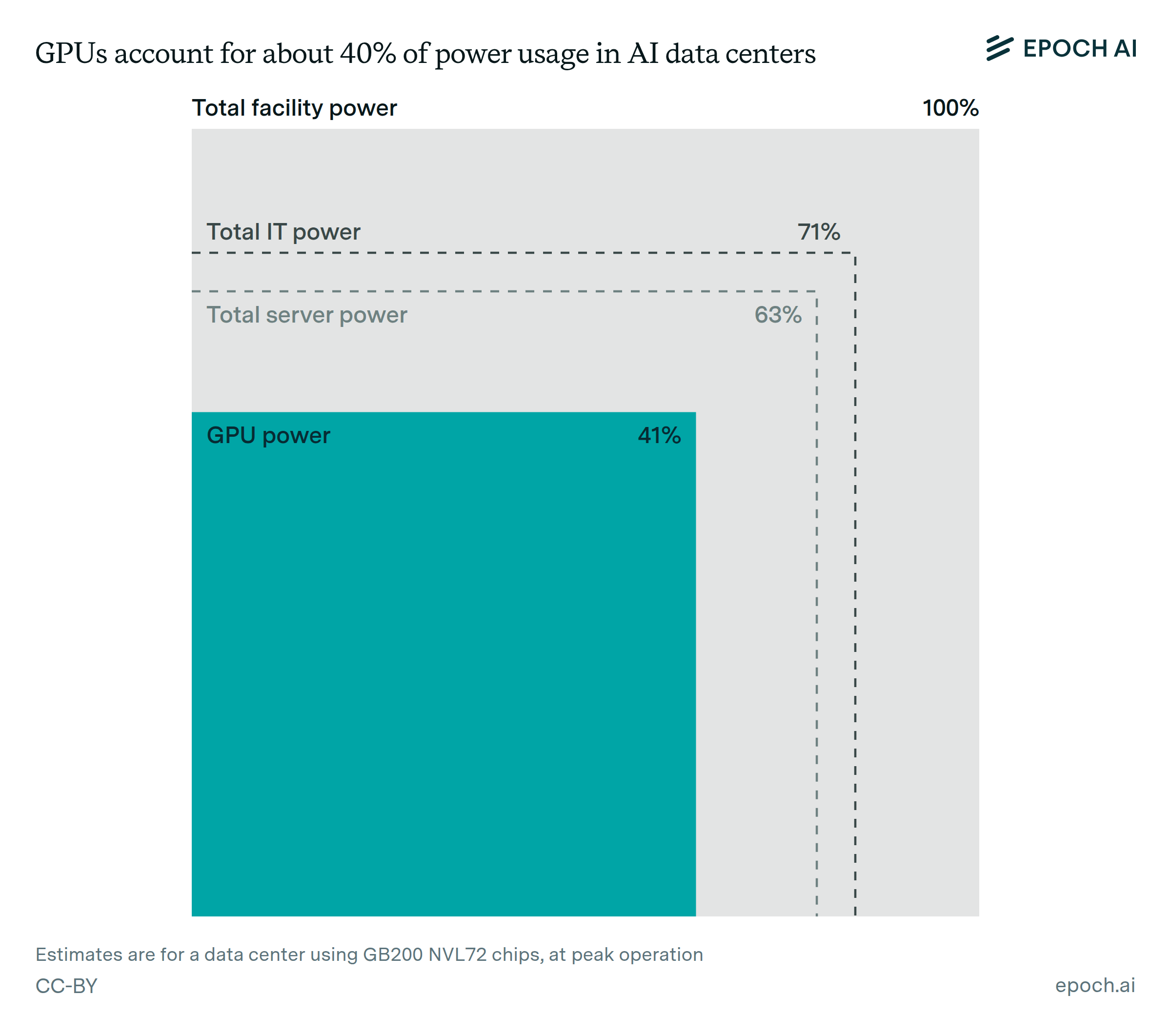
data insight
·
1 min read
GPUs account for about 40% of power usage in AI data centers

newsletter
·
16 min read
Is almost everyone wrong about America’s AI power problem?
Follow us on X

 @EpochAIResearch
@EpochAIResearch

 @EpochAIResearch
@EpochAIResearch

 @EpochAIResearch
@EpochAIResearch

 @EpochAIResearch
@EpochAIResearch

 @EpochAIResearch
@EpochAIResearch

 @EpochAIResearch
@EpochAIResearch

 @EpochAIResearch
@EpochAIResearch

 @EpochAIResearch
@EpochAIResearch

What if AI capabilities suddenly accelerated in 2027? How would the world know?
We developed a statistical framework that lets us detect capability accelerations from benchmark scores.
In simulations with synthetic benchmark data, we spot a 2× acceleration within 2-3 months.
We developed a statistical framework that lets us detect capability accelerations from benchmark scores.
In simulations with synthetic benchmark data, we spot a 2× acceleration within 2-3 months.
We’ve added ECI scores for Gemini 3 Pro, Opus 4.5, and GPT-5.2. ECI is computed from many benchmarks, but it correlates with other benchmarks too. So, we can use it to make predictions!
Here’s what we get for METR’s Time Horizons.
Gemini 3 Pro: 4.9h
GPT-5.2: 3.5h
Opus 4.5: 2.6h
Here’s what we get for METR’s Time Horizons.
Gemini 3 Pro: 4.9h
GPT-5.2: 3.5h
Opus 4.5: 2.6h
We just opened applications for two new roles—a part time design contractor, and full-time software engineer for our benchmarking team! Designer applications are rolling, but apply by Jan. 11 to be considered for our benchmarking team. As always, both roles are fully remote! 📈
GPT-5.2 scores 152 on the Epoch Capabilities Index (ECI), our tool for aggregating benchmark scores. This puts it second only to Gemini 3 Pro.
🧵 with individual scores.
🧵 with individual scores.
We upgraded our ECI methodology!
Our initial release treated different model settings separately—e.g. Claude Sonnet 4.5 16k and 32k thinking each got separate scores.
Starting today we will use the best score for each benchmark across a model's evaluation settings.
Our initial release treated different model settings separately—e.g. Claude Sonnet 4.5 16k and 32k thinking each got separate scores.
Starting today we will use the best score for each benchmark across a model's evaluation settings.
We’ve made two additions to the suite of benchmarks we run ourselves: SimpleQA Verified and a new benchmark of chess puzzles! We will use these easy-to-run benchmarks to get quick estimates of our Epoch Capabilities Index (ECI) for newly-released models.
Details and examples in 🧵
Details and examples in 🧵
Individual AI benchmarks saturate too quickly to give us a long-run trend of AI progress.
We can solve this by "stitching" them together. As @ansonwhho explains, this lets us forecast AI capabilities, quantify algorithmic improvements, and detect accelerations in AI progress.
We can solve this by "stitching" them together. As @ansonwhho explains, this lets us forecast AI capabilities, quantify algorithmic improvements, and detect accelerations in AI progress.
How much does it cost NVIDIA to make a B200 GPU?
By our estimate, around $6,400, implying chip-level gross margins of ~80%.
The counterintuitive part: the logic die, the core component of the GPU, is one of the cheaper parts, accounting for less than 15% of the total cost. 🧵
By our estimate, around $6,400, implying chip-level gross margins of ~80%.
The counterintuitive part: the logic die, the core component of the GPU, is one of the cheaper parts, accounting for less than 15% of the total cost. 🧵

data insight
·
3 min read
NVIDIA’s B200 costs around $6,400 to produce, with memory accounting for half
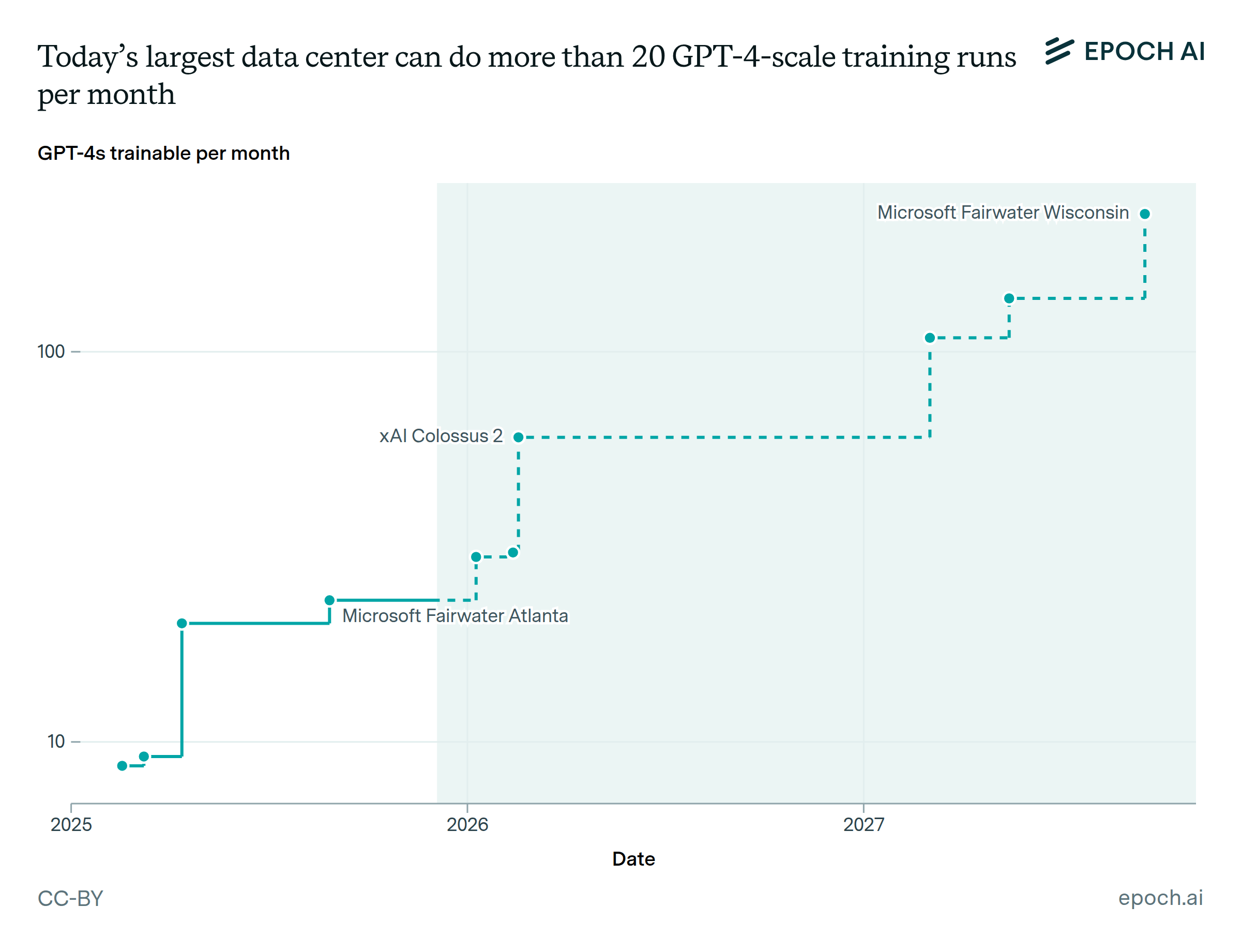
data insight
·
1 min read
Today’s largest data center can do more than 20 GPT-4-scale training runs each month
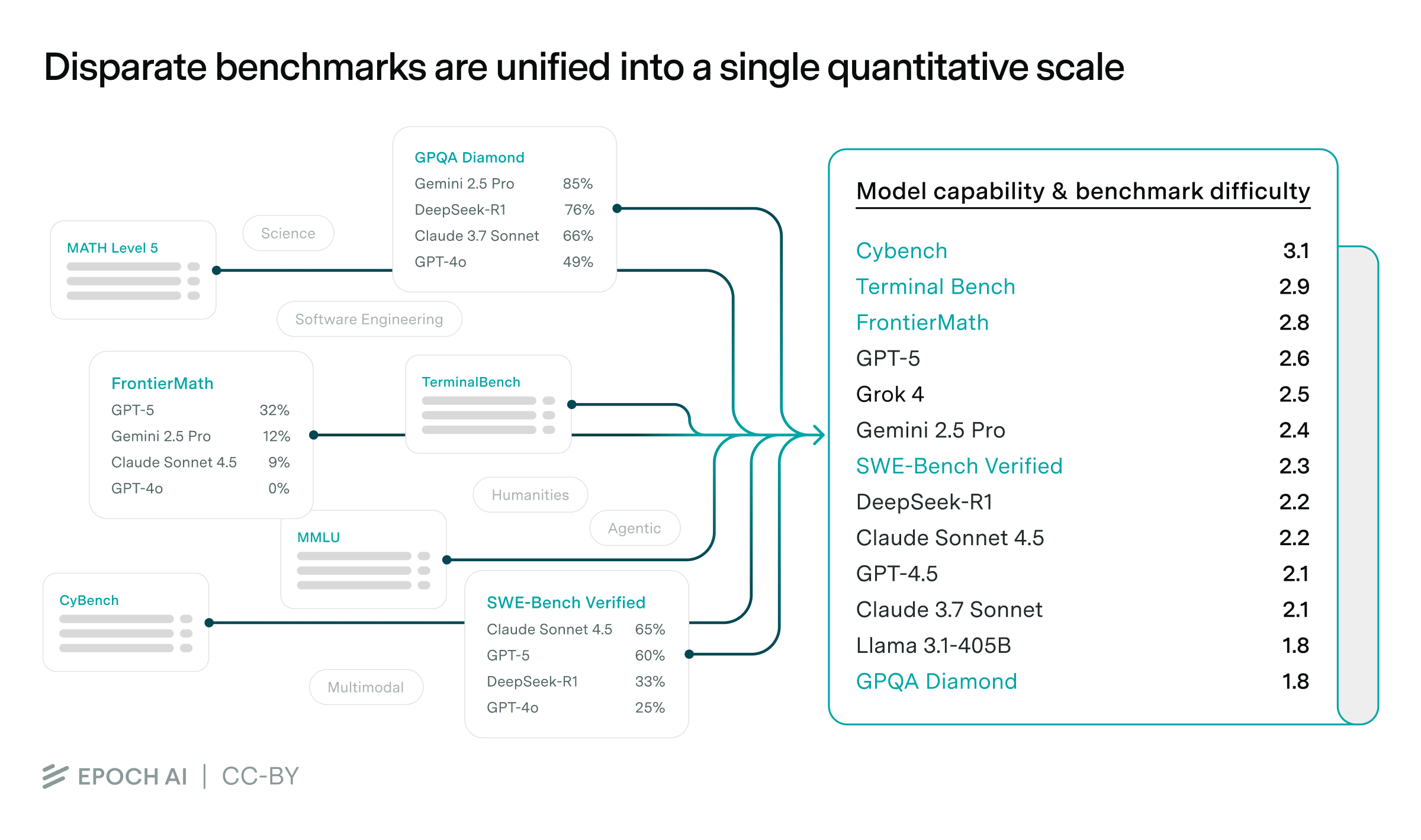
paper
·
4 min read
A Rosetta Stone for AI benchmarks
Most benchmarks saturate too quickly to study long-run AI trends. We solve this using a statistical framework that stitches benchmarks together, with big implications for algorithmic progress and AI forecasting.
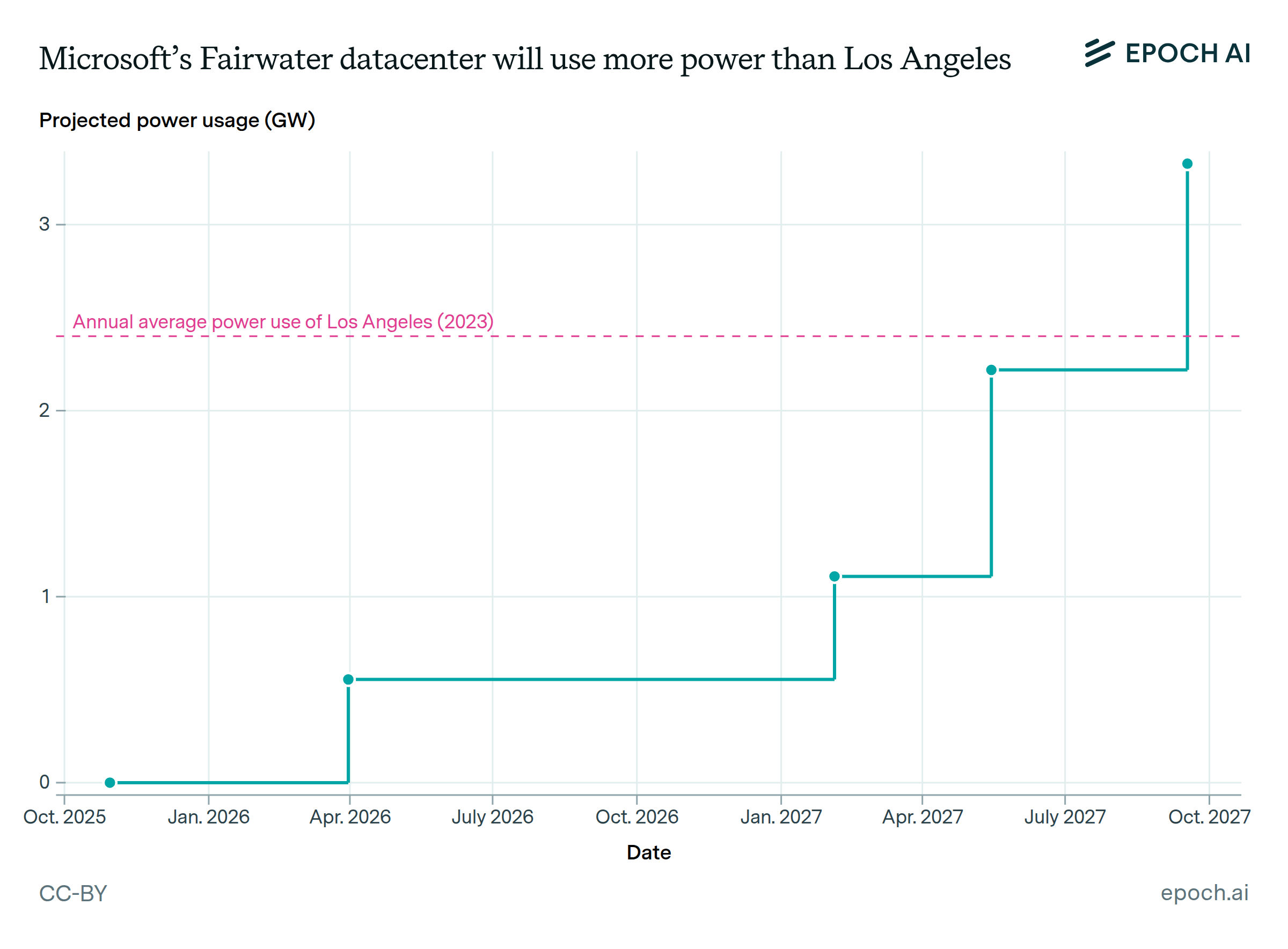
data insight
·
1 min read
Microsoft’s Fairwater datacenter will use more power than Los Angeles

newsletter
·
5 min read
Benchmark Scores = General Capability + Claudiness

data insight
·
2 min read
The largest AI data center campuses will soon be a fifth the size of Manhattan

newsletter
·
16 min read
The software intelligence explosion debate needs experiments

data insight
·
3 min read
Build times for gigawatt-scale data centers can be 2 years or less

data insight
·
1 min read
Epoch’s Capabilities Index stitches together benchmarks across a wide range of difficulties

report
·
14 min read
What you need to know about AI data centers
AI companies are planning a buildout of data centers that will rank among the largest infrastructure projects in history. We examine their power demands, what makes AI data centers special, and what all this means for AI policy and the future of AI.

update
·
4 min read
Introducing the Frontier Data Centers Hub
Our new Frontier Data Centers Hub tracks large AI data centers using satellite and permit data to show compute, power use, and construction timelines.
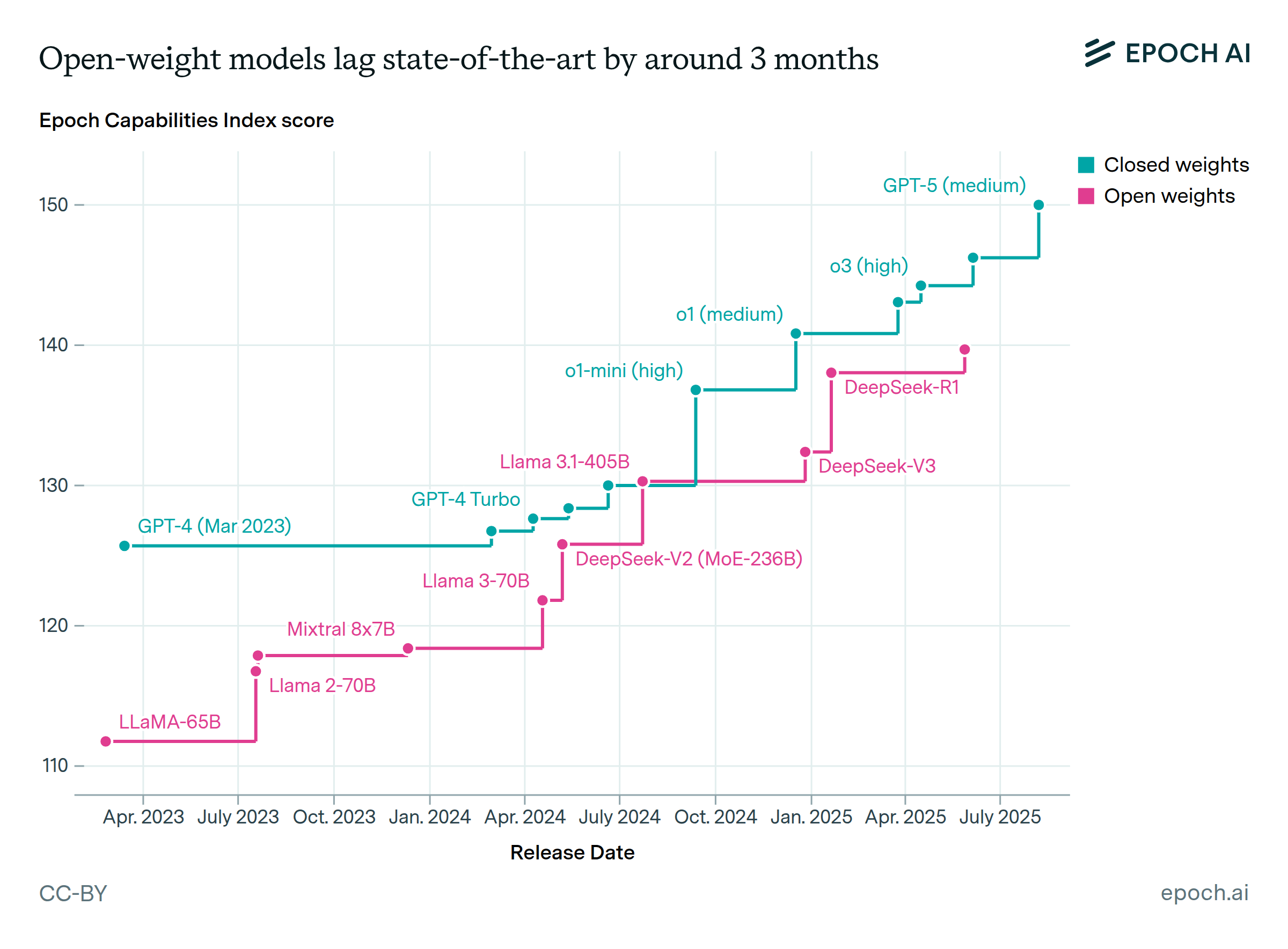
data insight
·
1 min read
Open-weight models lag state-of-the-art by around 3 months on average
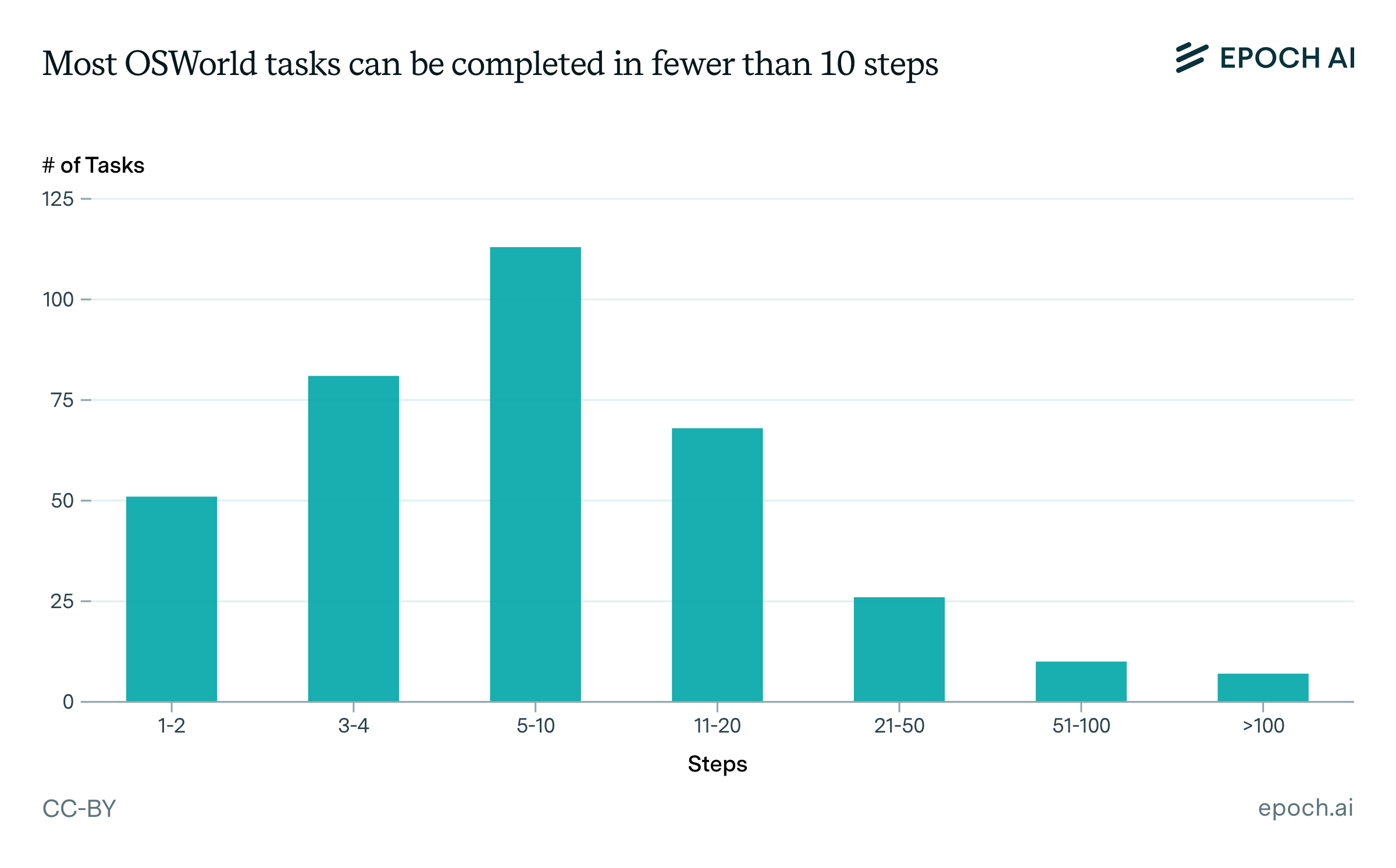
report
·
14 min read
What does OSWorld tell us about AI’s ability to use computers?
We review OSWorld, a prominent computer use benchmark. Tasks are relatively simple, many don’t require GUIs, and success often hinges on interpreting ambiguous instructions. The benchmark is also not stable over time.
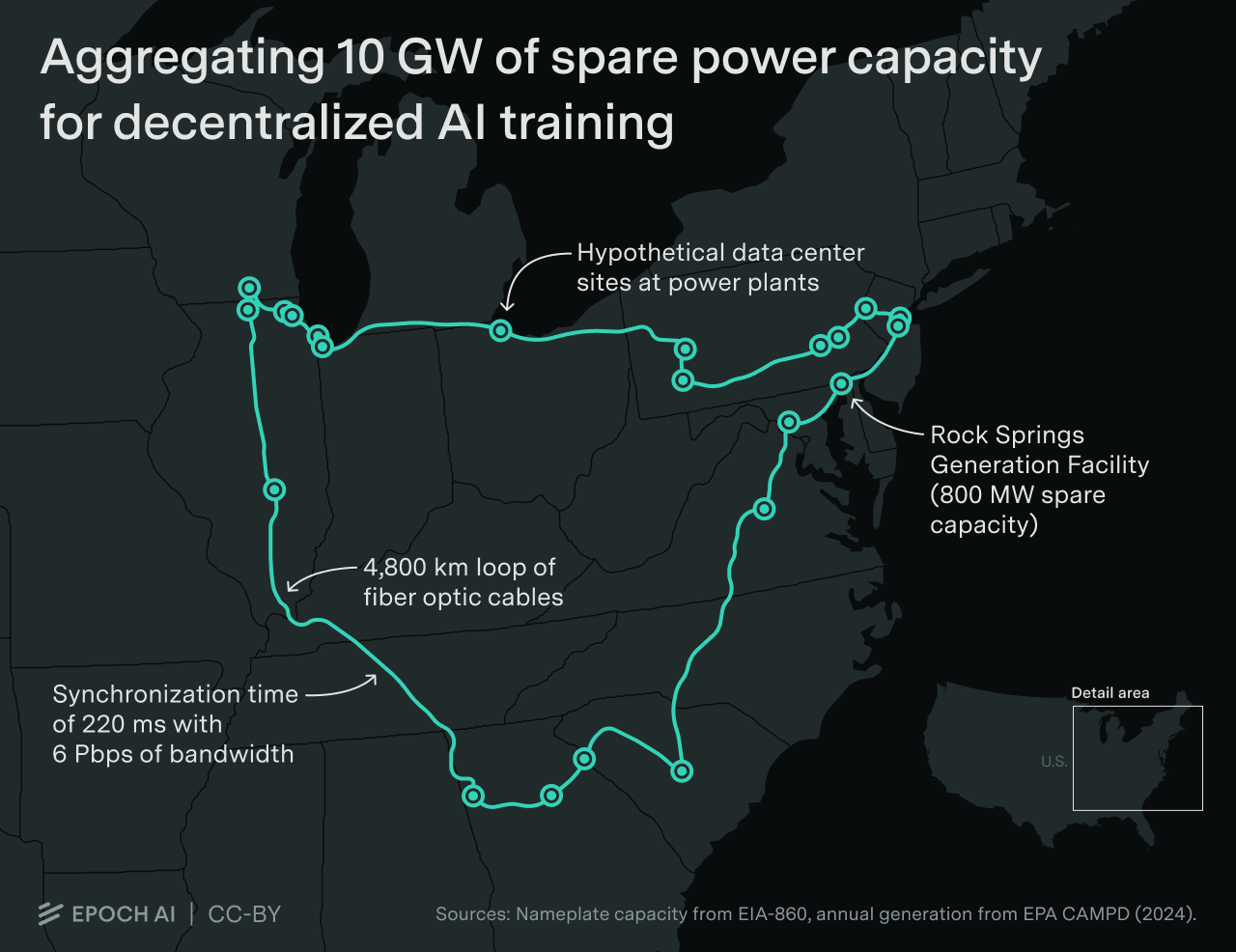
report
·
25 min read
Could decentralized training solve AI’s power problem?
We illustrate a decentralized 10 GW training run across a dozen sites spanning thousands of kilometers. Developers are likely to scale datacenters to multi-gigawatt levels before adopting decentralized training.

newsletter
·
8 min read
Less than 70% of FrontierMath is within reach for today’s models

newsletter
·
7 min read
OpenAI is projecting unprecedented revenue growth
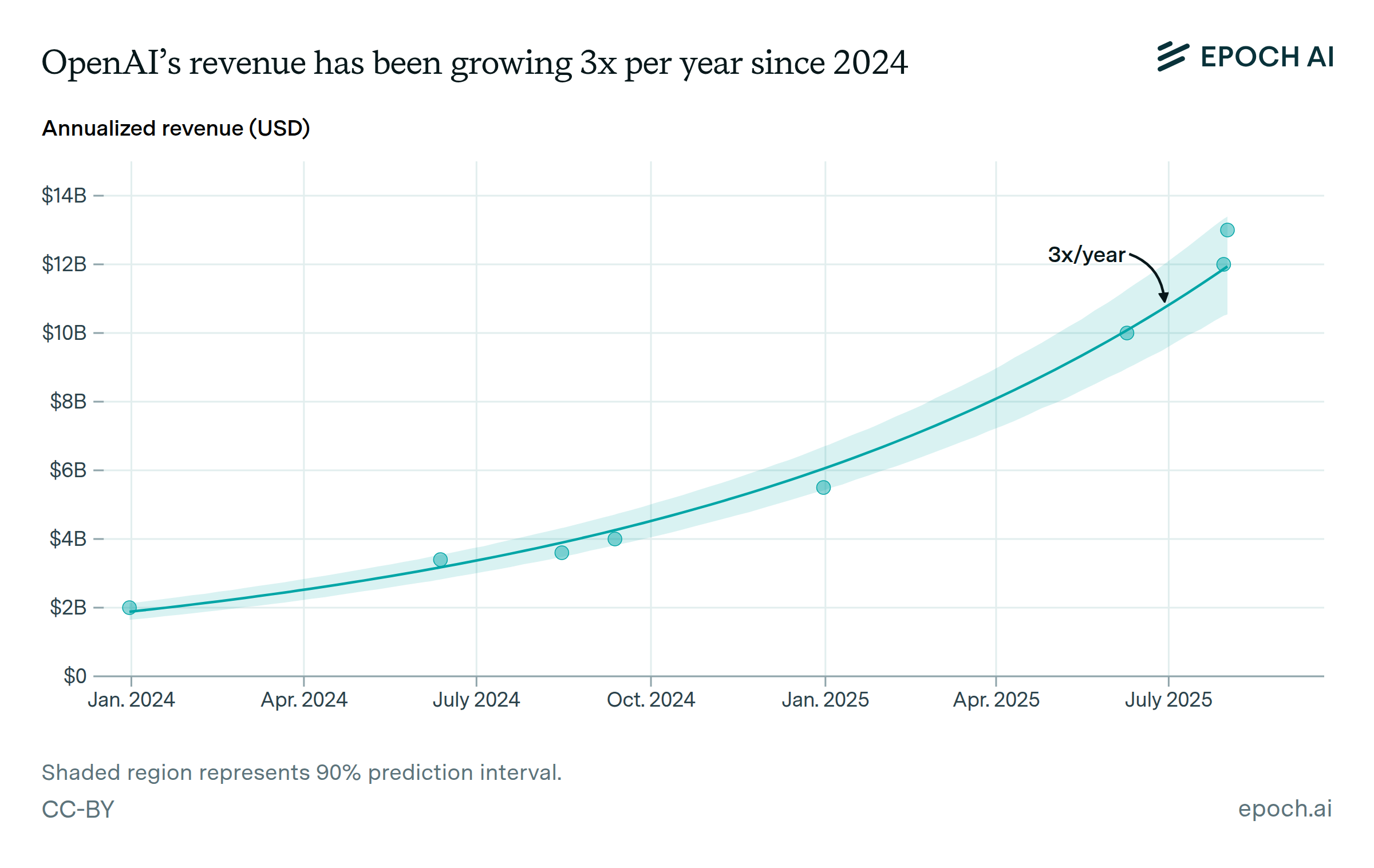
data insight
·
1 min read
OpenAI's revenue has been growing 3x a year since 2024
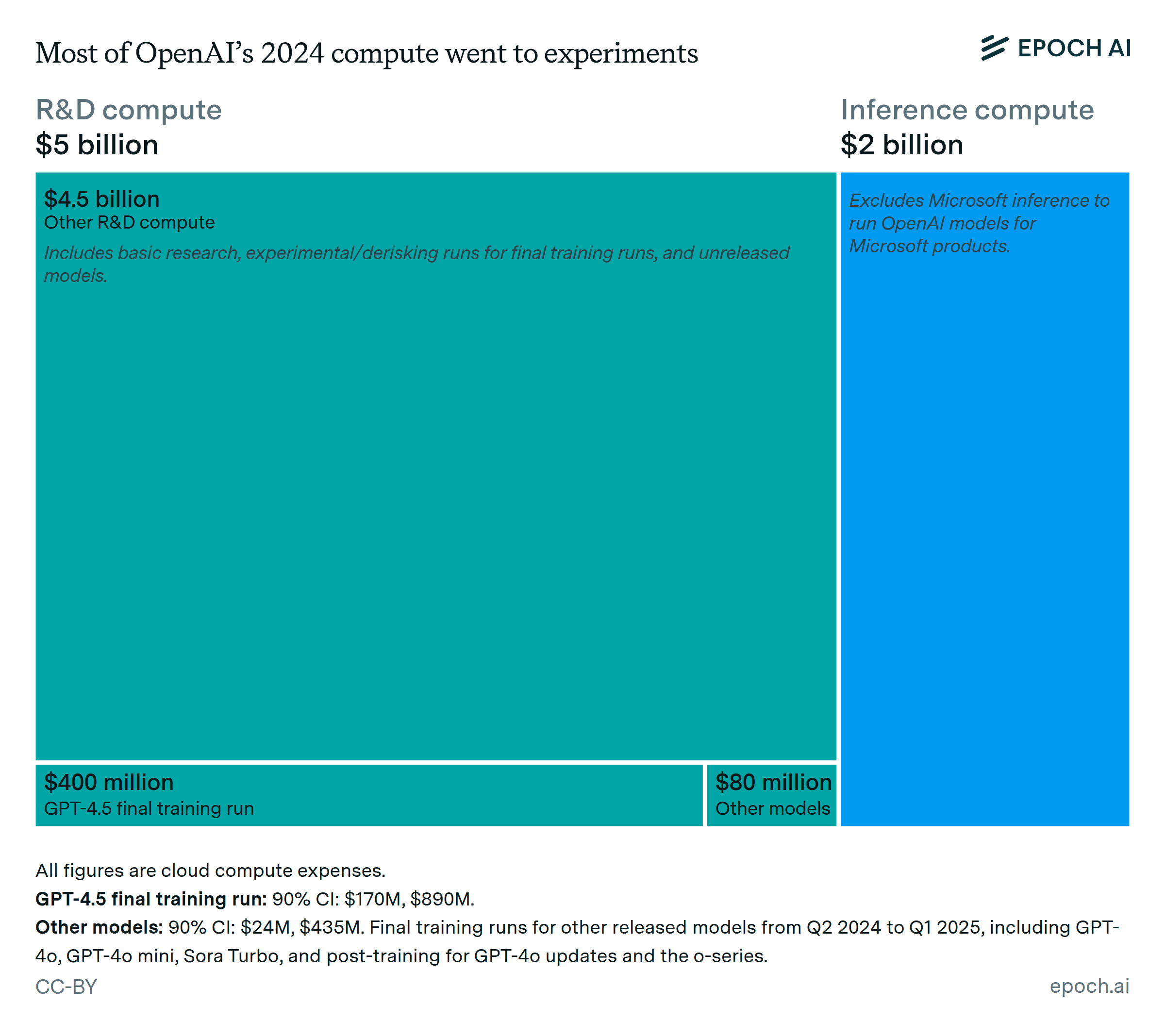
data insight
·
3 min read
Most of OpenAI’s 2024 compute went to experiments

report
·
23 min read
Evaluating Gemini 2.5 Deep Think's math capabilities
Improved use of knowledge and precision, helpful for research, more conceptual in geometry, but limited creativity and citation issues.

newsletter
·
8 min read
How many digital workers could OpenAI deploy?
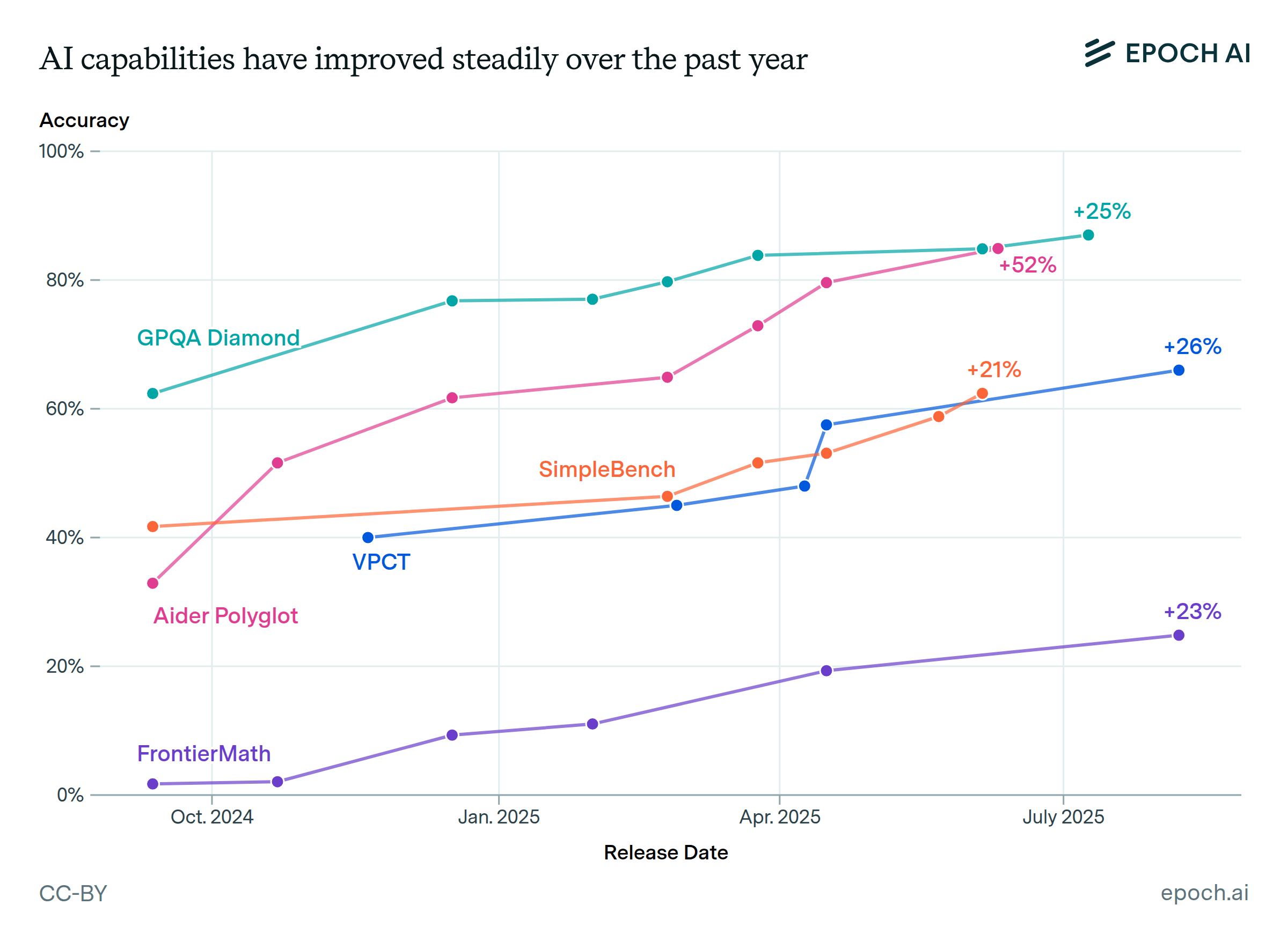
data insight
·
1 min read
AI capabilities have steadily improved over the past year

update
·
2 min read
Introducing the AI Companies Data Hub
Our new AI Companies Data Hub tracks key economic and operational data, including frontier AI companies’ revenue, funding, valuations, staff counts, compute spending, and product usage

newsletter
·
7 min read
Why GPT-5 used less training compute than GPT-4.5 (but GPT-6 probably won’t)
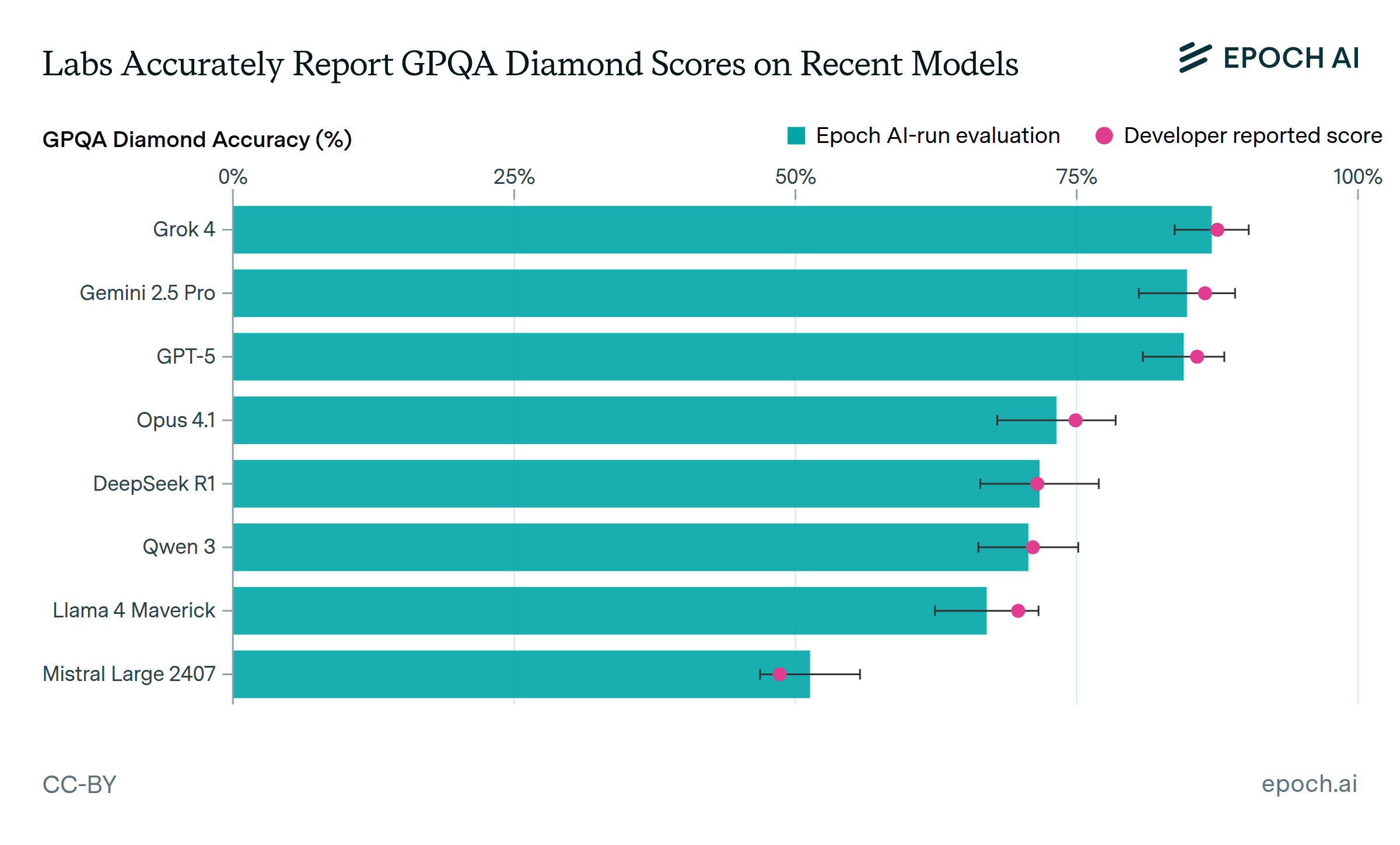
data insight
·
2 min read
AI developers accurately report GPQA Diamond scores for recent models

newsletter
·
8 min read
The huge potential implications of long-context inference

report
·
8 min read
What will AI look like in 2030?
If scaling persists to 2030, AI investments will reach hundreds of billions of dollars and require gigawatts of power. Benchmarks suggest AI could improve productivity in valuable areas such as scientific R&D.

data insight
·
3 min read
What did it take to train Grok 4?

newsletter
·
11 min read
Three challenges facing compute-based AI policies

newsletter
·
10 min read
Compute scaling will slow down due to increasing lead times
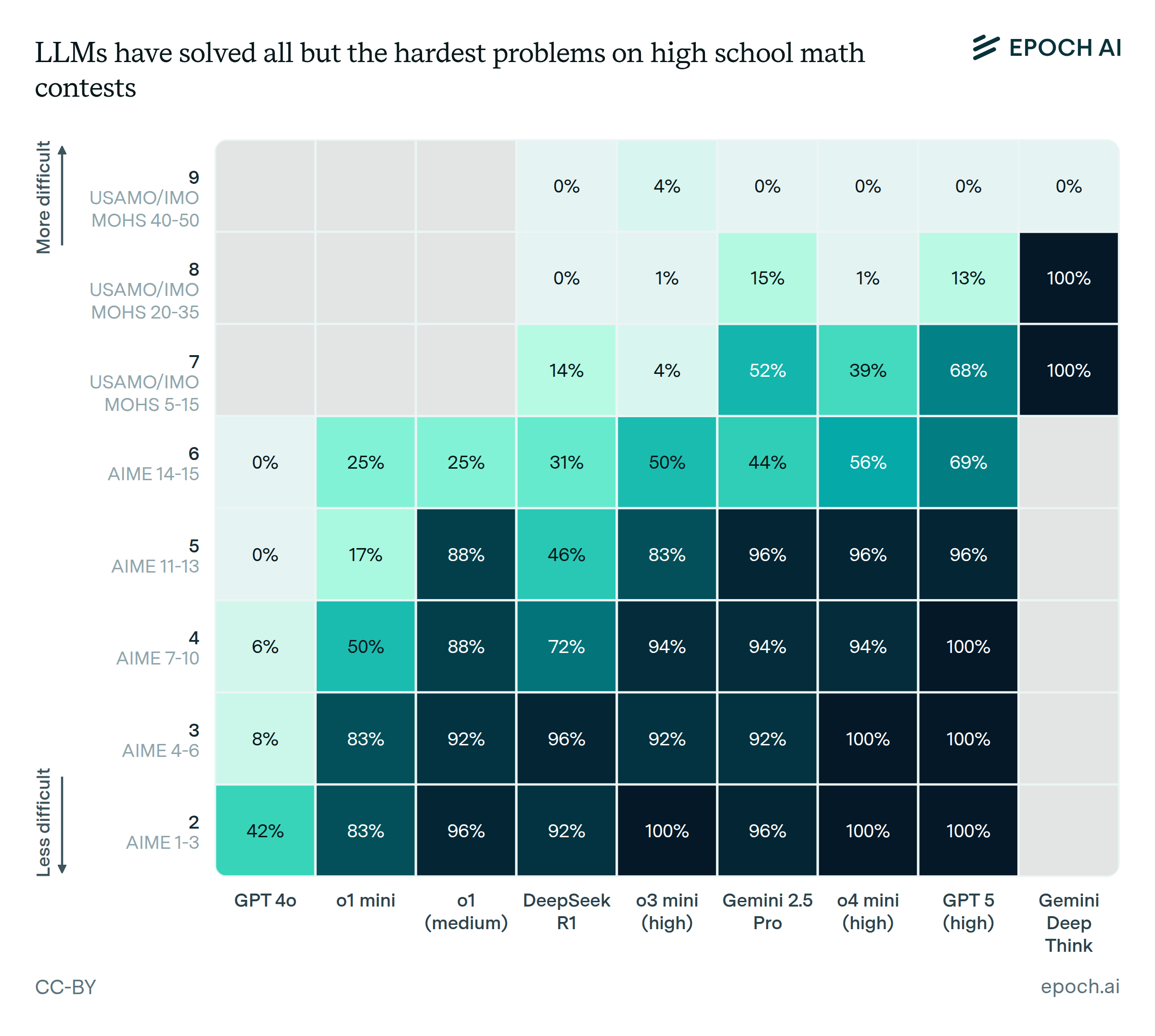
data insight
·
5 min read
LLMs have not yet solved the hardest problems on high school math contests
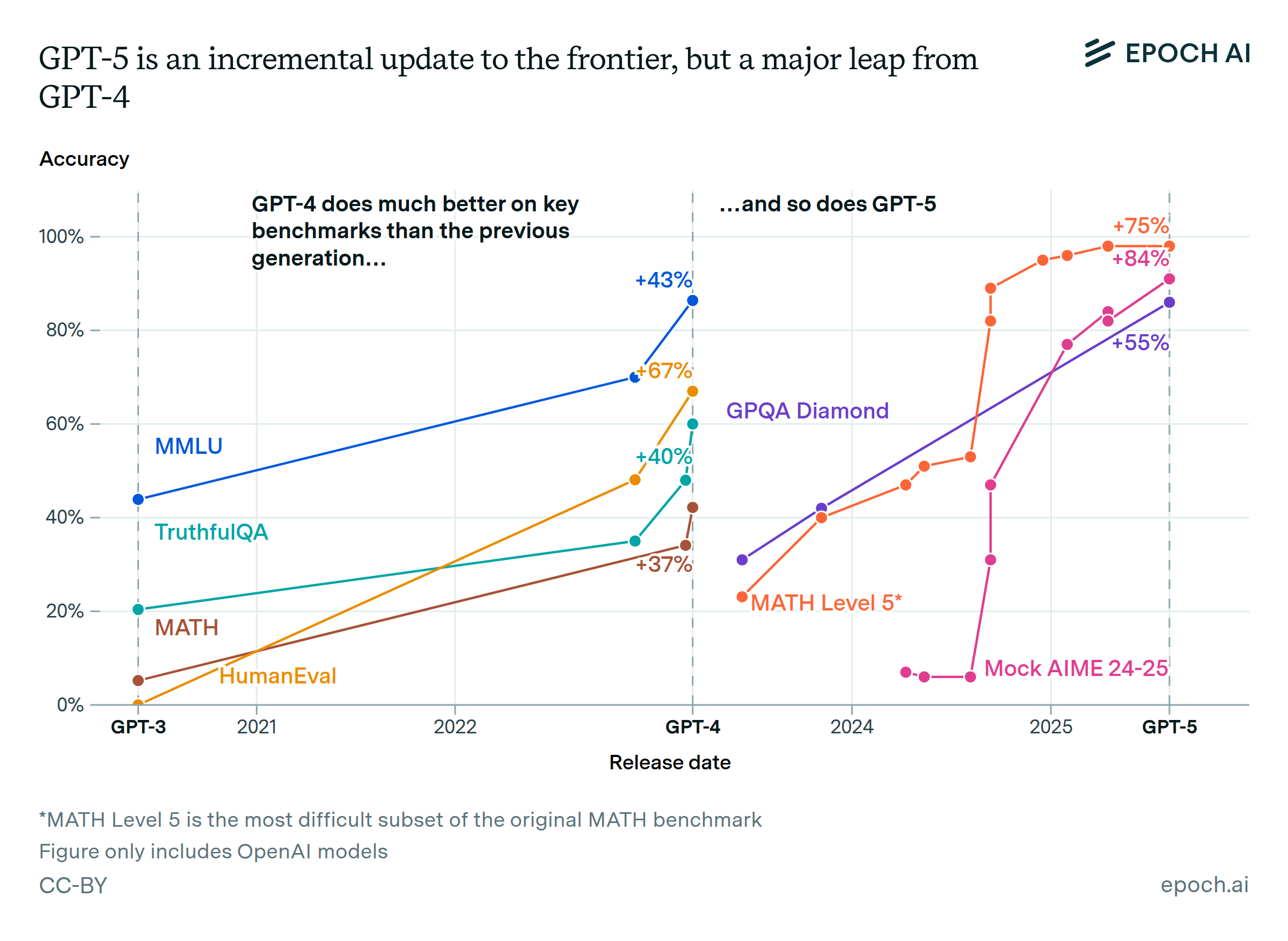
data insight
·
2 min read
GPT-5 and GPT-4 were both major leaps in benchmarks from the previous generation

newsletter
·
7 min read
Why future AI agents will be trained to work together
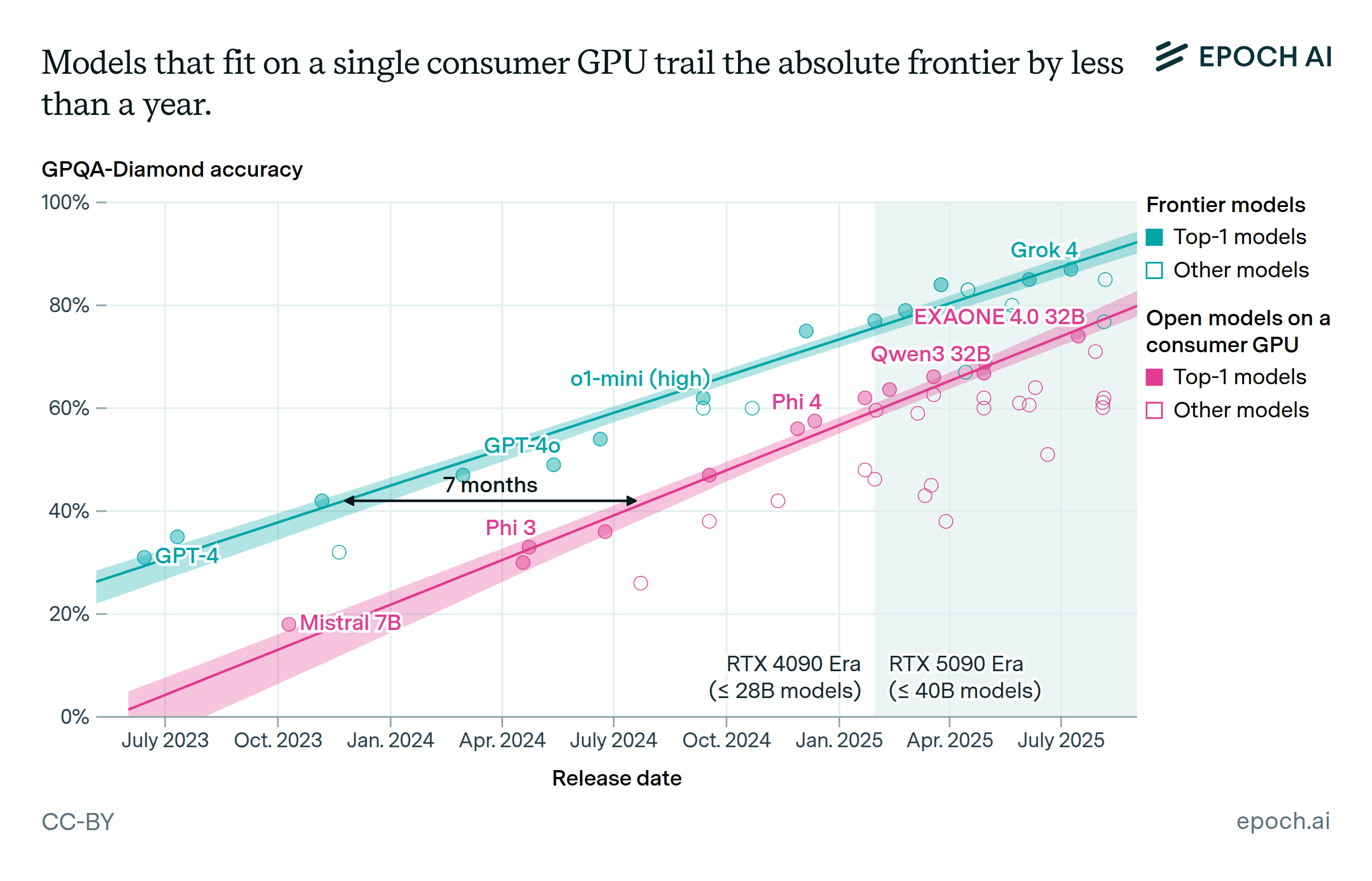
data insight
·
5 min read
Frontier AI performance becomes accessible on consumer hardware within a year
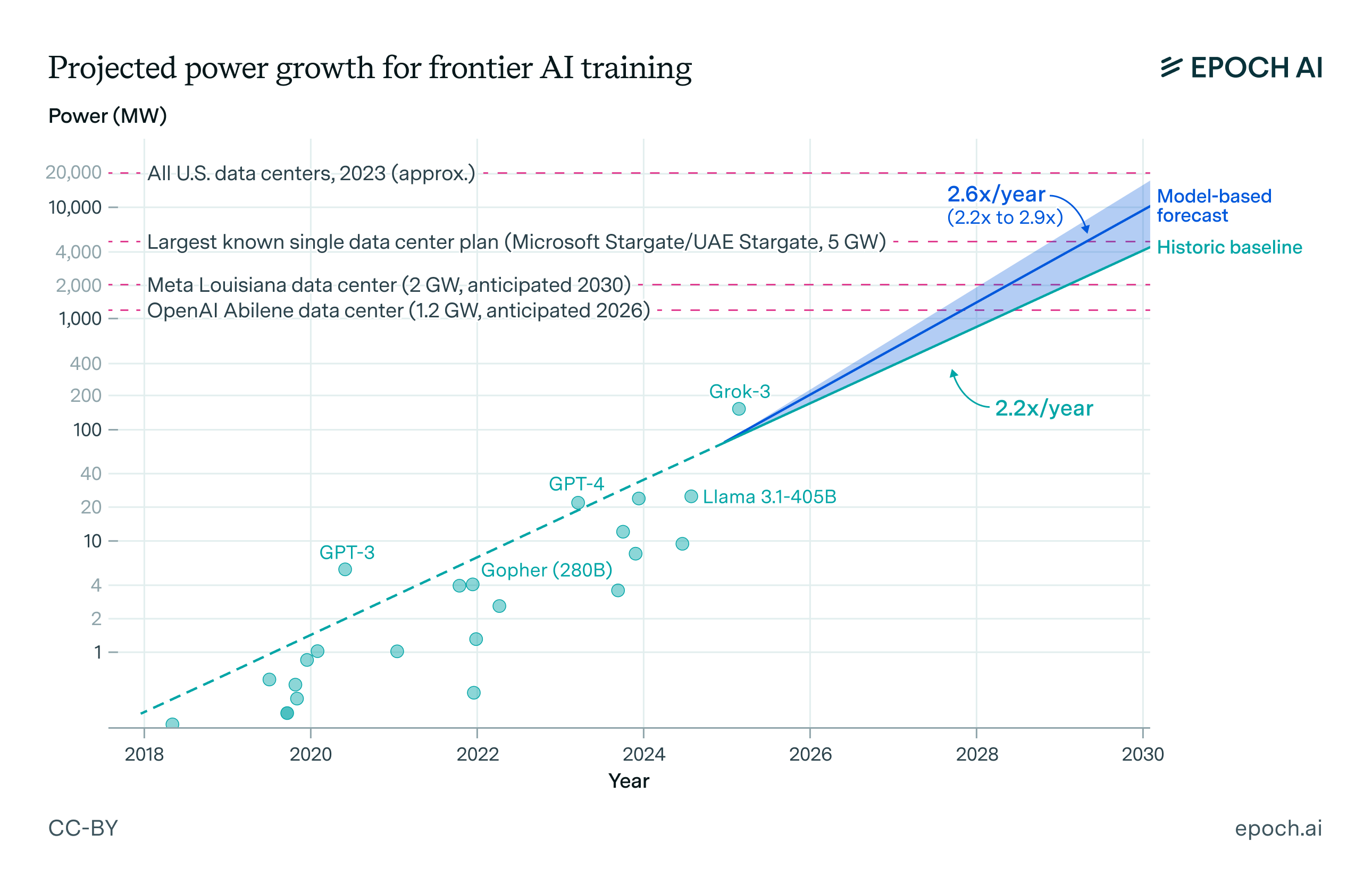
paper
·
4 min read
How much power will frontier AI training demand in 2030?
The power required to train the largest frontier models is growing by more than 2x per year, and is on trend to reaching multiple gigawatts by 2030.

data insight
·
3 min read
Compute is not a bottleneck for robotic manipulation

newsletter
·
10 min read
We didn’t learn much from the IMO

newsletter
·
10 min read
Quantifying the algorithmic improvement from reasoning models
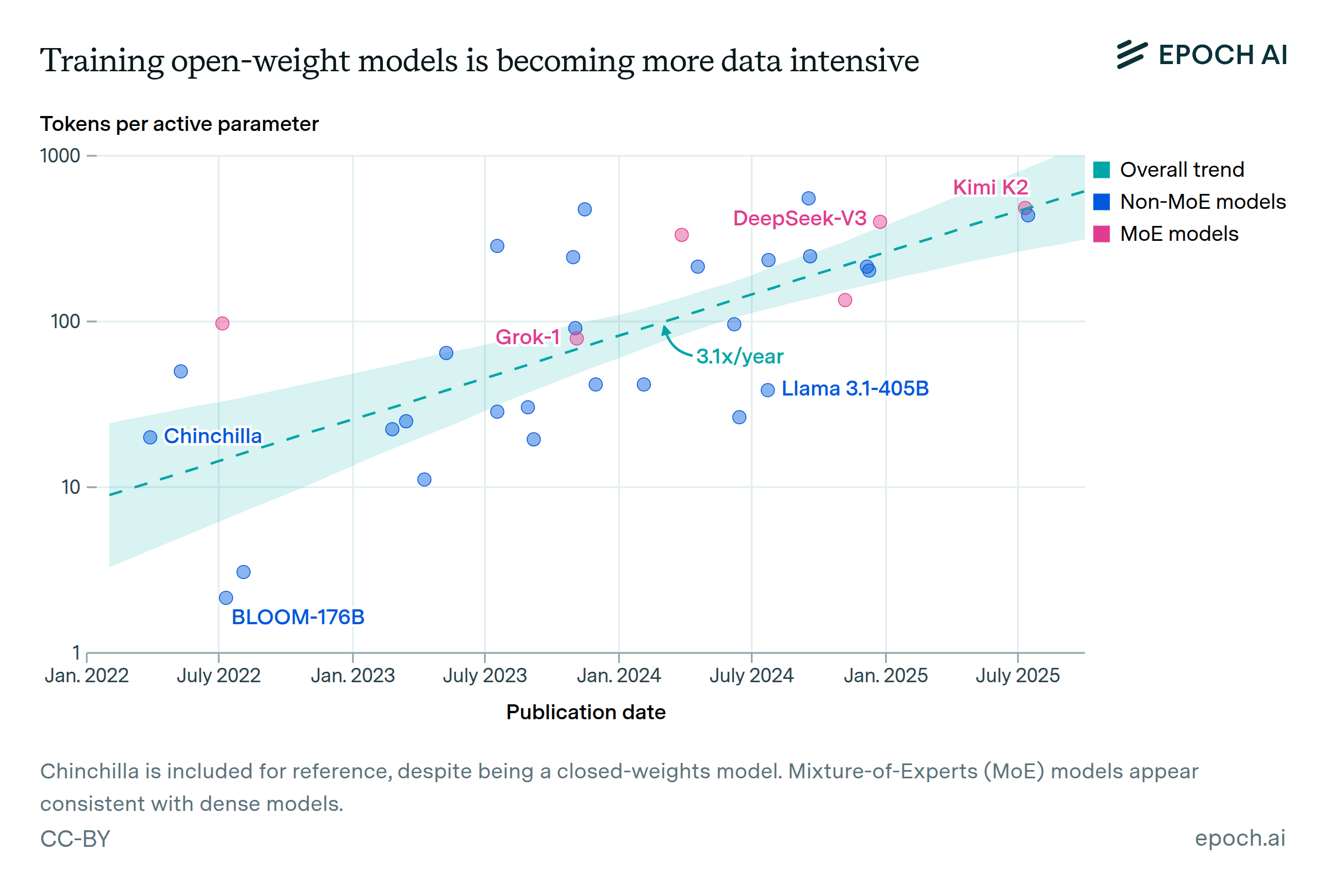
data insight
·
2 min read
Training open-weight models is becoming more data intensive

newsletter
·
12 min read
Why China isn’t about to leap ahead of the West on compute

data insight
·
2 min read
Frontier training runs will likely stop getting longer by around 2027

report
·
31 min read
Evaluating Grok 4’s math capabilities
It's good at involved computations, improving at proofs, and useful for literature search. It still favors low-level grinds and leans on background knowledge.

newsletter
·
11 min read
After the ChatGPT moment: Measuring AI’s adoption
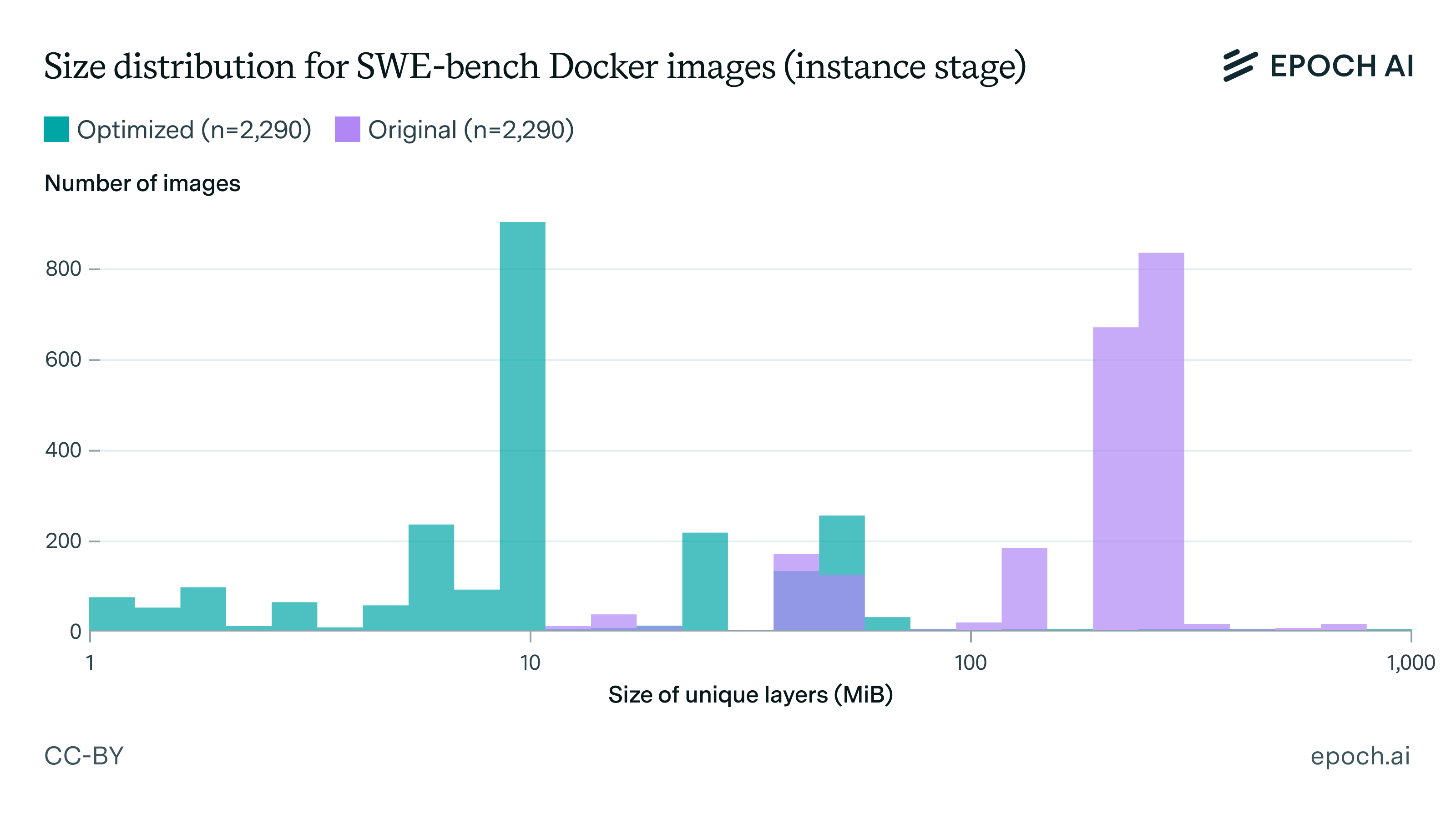
update
·
15 min read
How to run SWE-bench Verified in one hour on one machine
We are releasing a public registry of optimized Docker images for SWE-bench. This allows us to run SWE-bench Verified in 62 minutes on a single GitHub actions VM.

newsletter
·
15 min read
What will the IMO tell us about AI math capabilities?

newsletter
·
9 min read
How big could an “AI Manhattan Project” get?
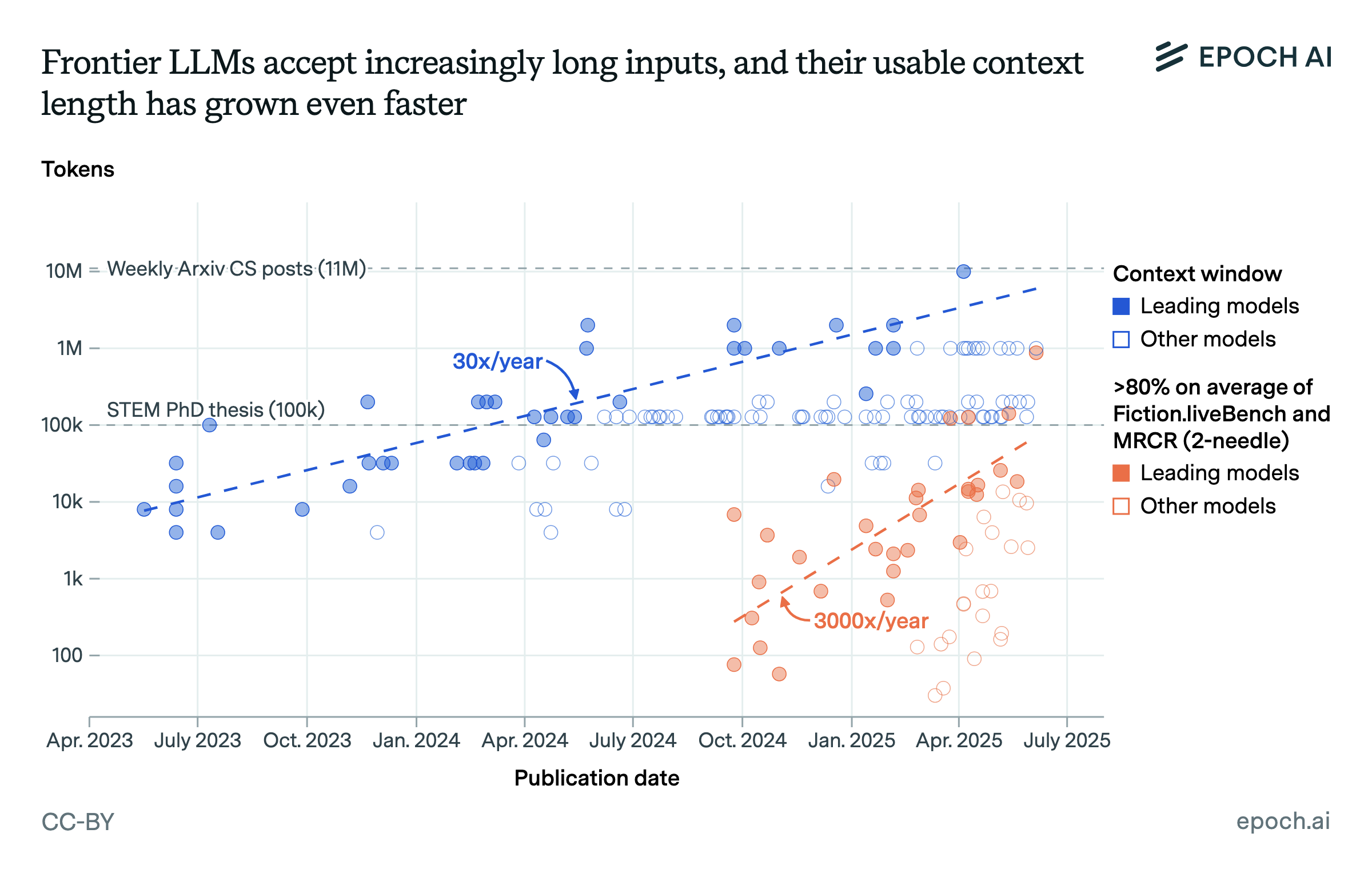
data insight
·
4 min read
LLMs now accept longer inputs, and the best models can use them more effectively

newsletter
·
9 min read
AI and explosive growth redux
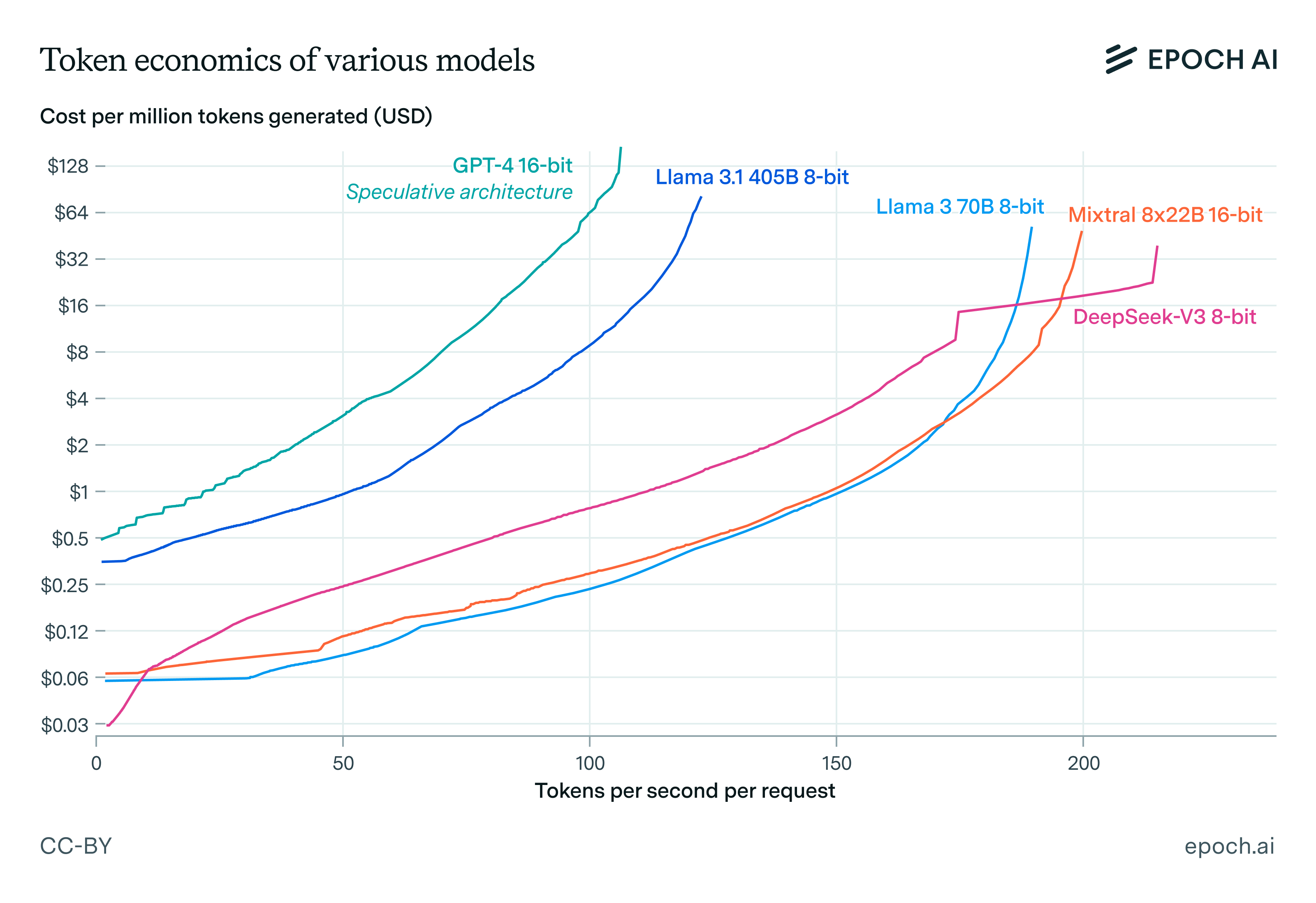
paper
·
4 min read
Inference economics of language models
We investigate how speed trades off against cost in language model inference. We find that inference latency scales with the square root of model size and the cube root of memory bandwidth, and other results.

newsletter
·
19 min read
Do the biorisk evaluations of AI labs actually measure the risk of developing bioweapons?

report
·
11 min read
What skills does SWE-bench Verified evaluate?
We take a deep dive into SWE-bench Verified, a prominent agentic coding benchmark. While one of the best public tests of AI coding agents, it is limited by its focus on simple bug fixes in familiar open-source repositories.

data insight
·
3 min read
LLM providers offer a trade-off between accuracy and speed

data insight
·
8 min read
Over 30 AI models have been trained at the scale of GPT-4

newsletter
·
8 min read
Beyond benchmark scores: Analyzing o3-mini’s mathematical reasoning
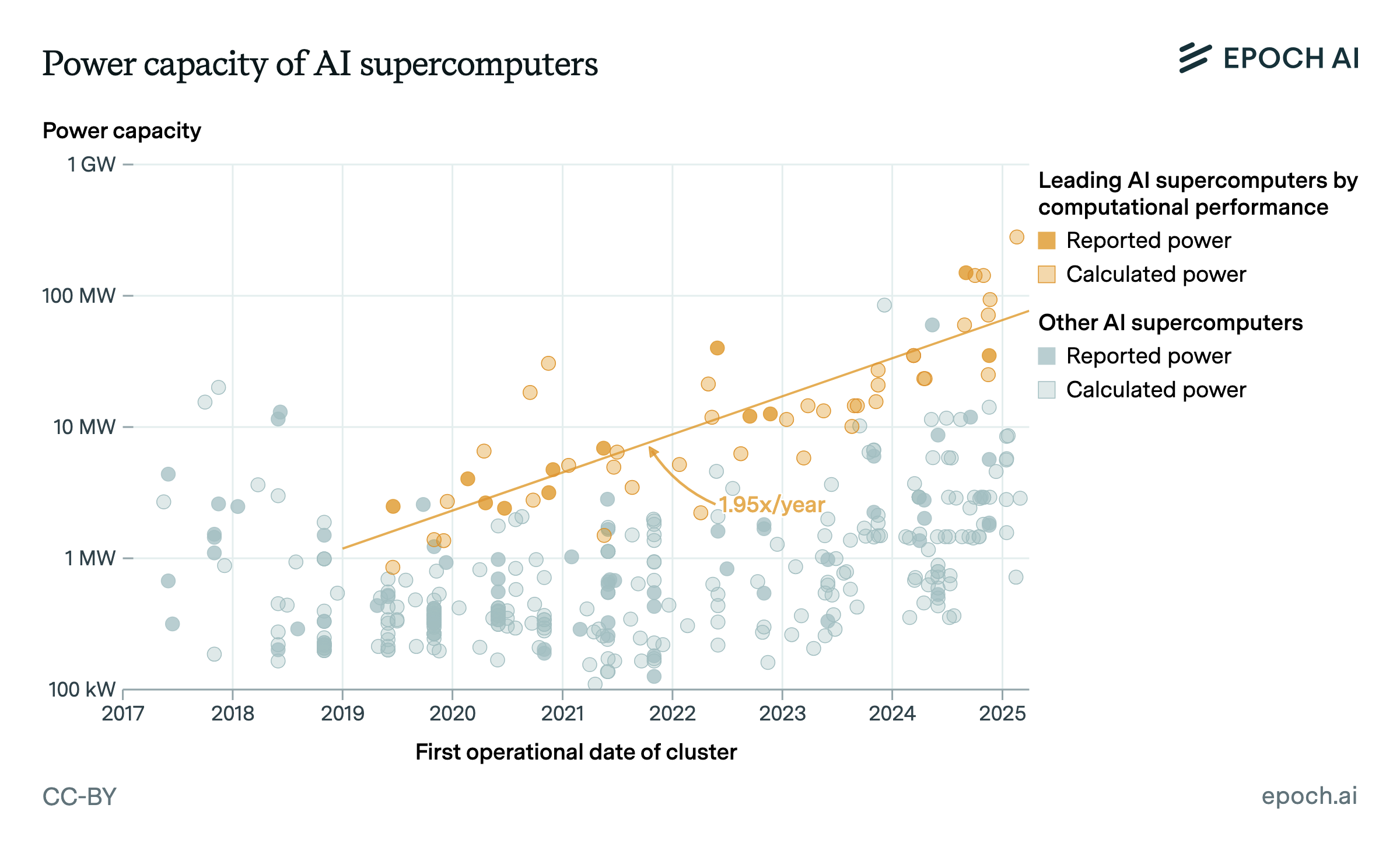
data insight
·
3 min read
Power requirements of leading AI supercomputers have doubled every 13 months

data insight
·
1 min read
Private-sector companies own a dominant share of GPU clusters
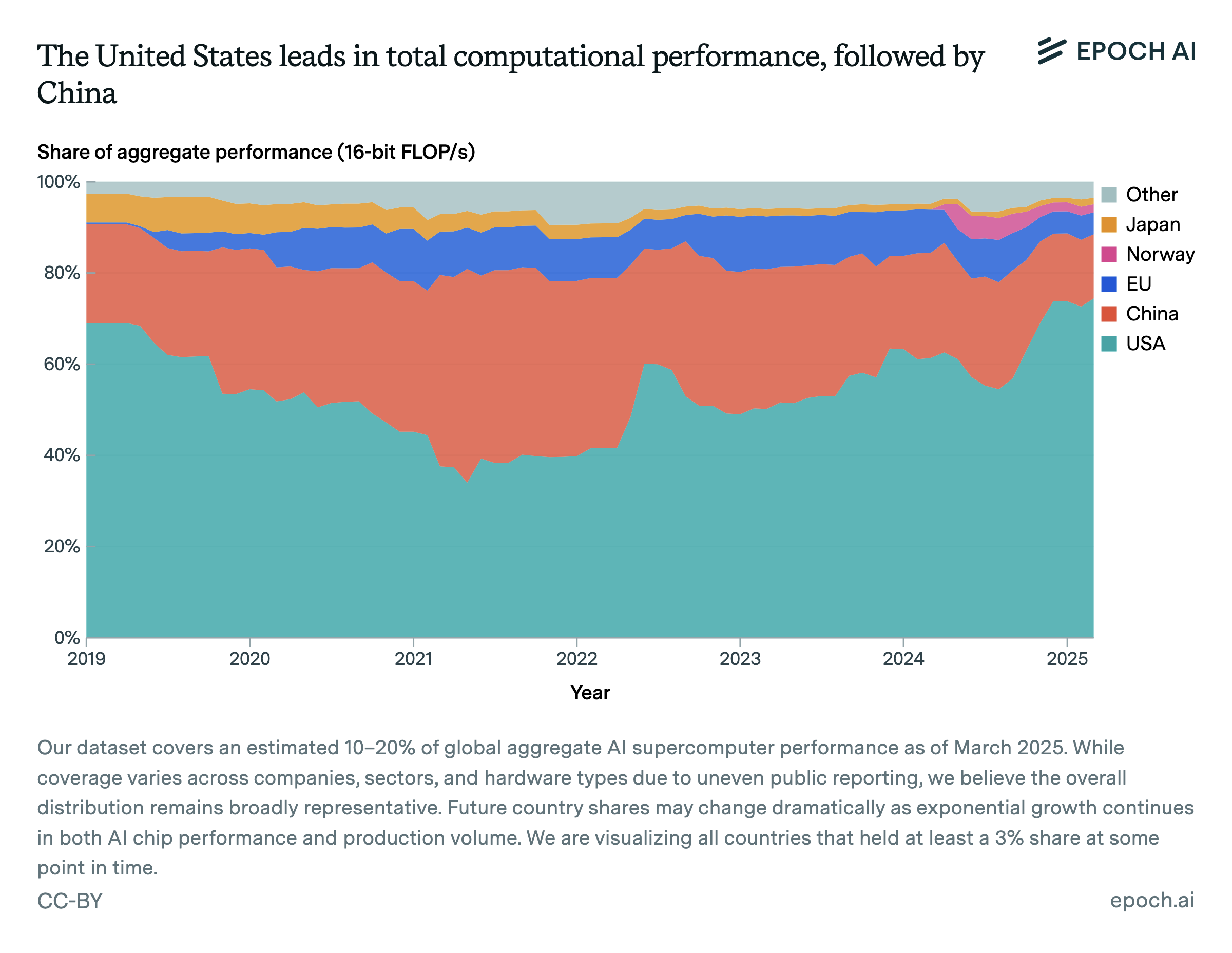
data insight
·
2 min read
The US hosts the majority of GPU cluster performance, followed by China
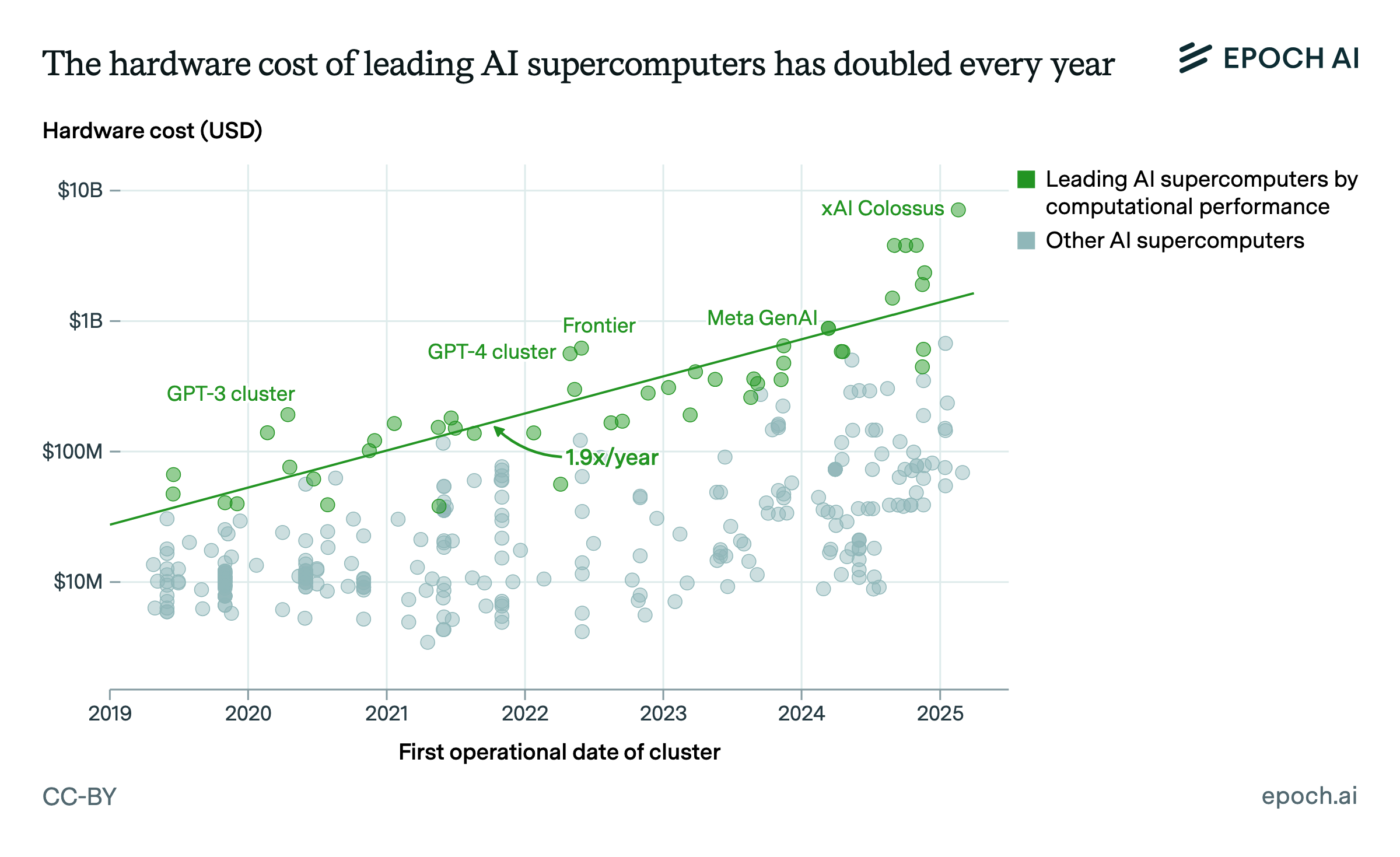
data insight
·
1 min read
Acquisition costs of leading AI supercomputers have doubled every 13 months
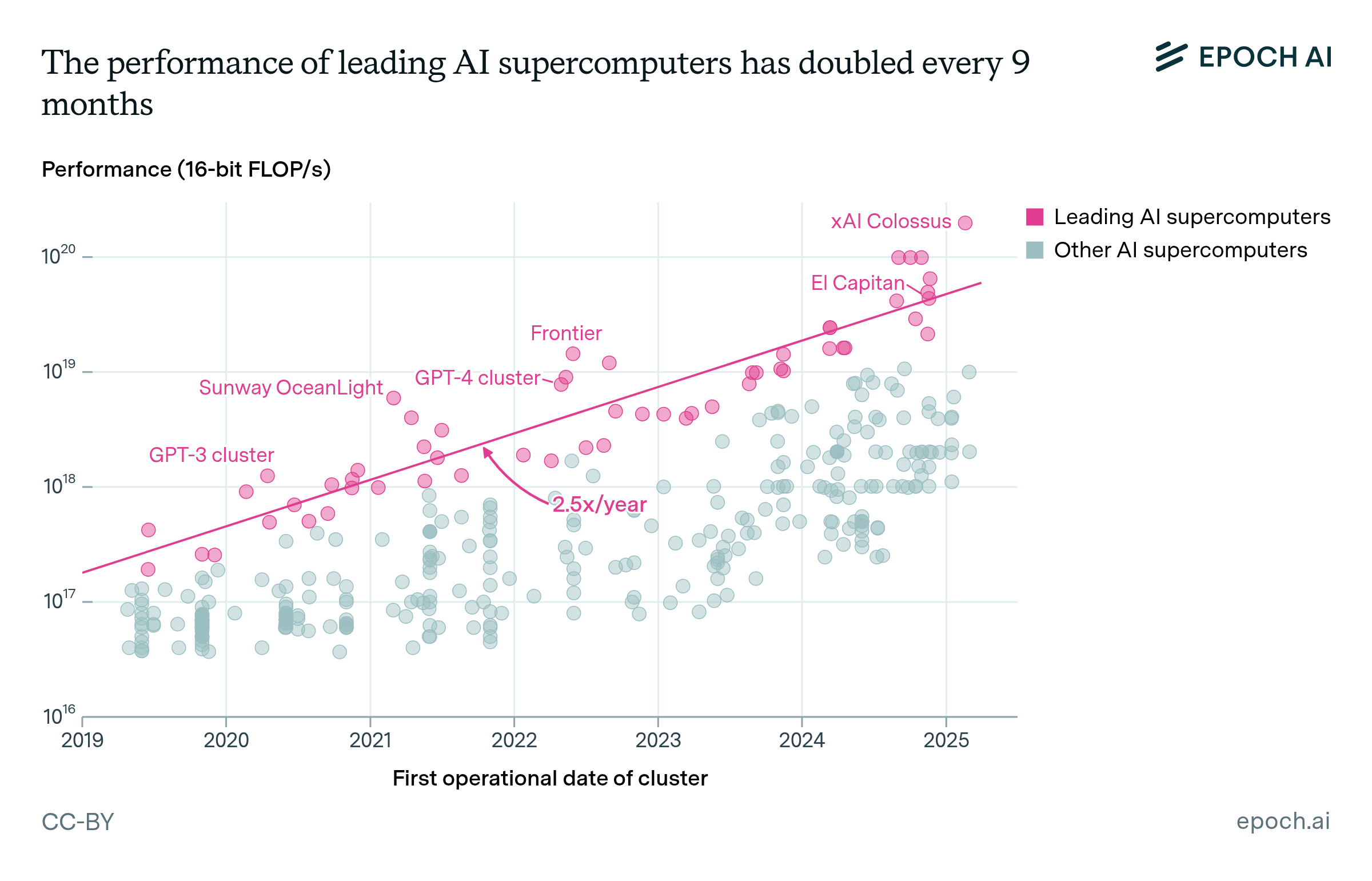
data insight
·
2 min read
The computational performance of leading AI supercomputers has doubled every nine months
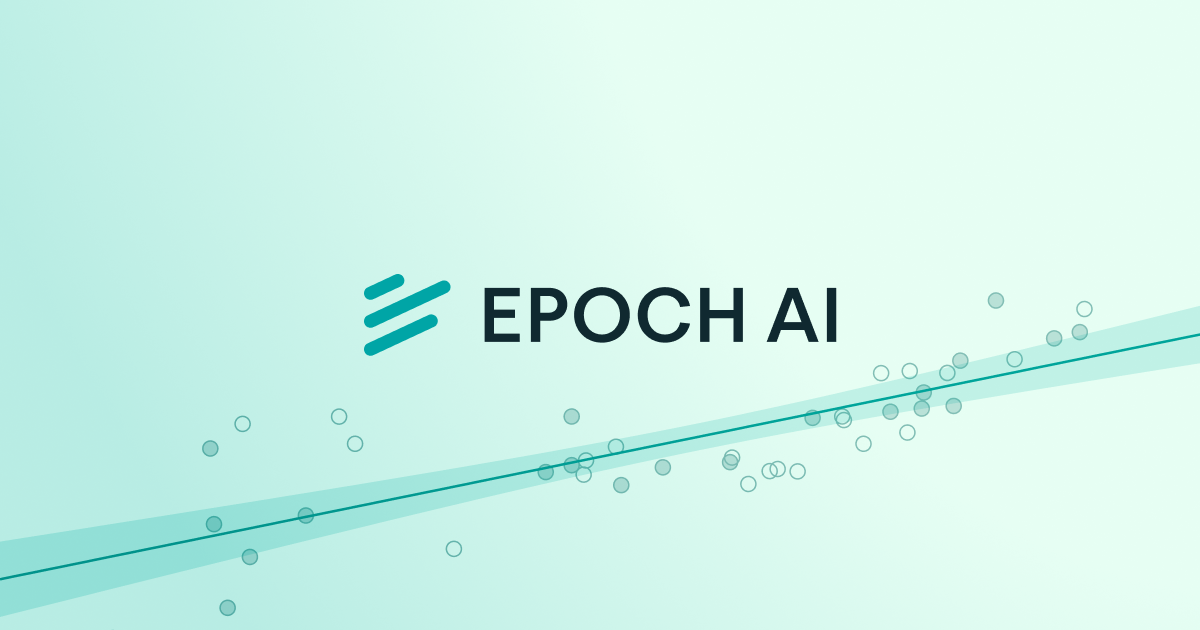
update
·
9 min read
What is Epoch?
Our director explains Epoch AI’s mission and how we decide our priorities. In short, we work on projects to understand the trajectory of AI, share this knowledge publicly, and inform important decisions about AI.

newsletter
·
11 min read
GPQA Diamond: What’s left?
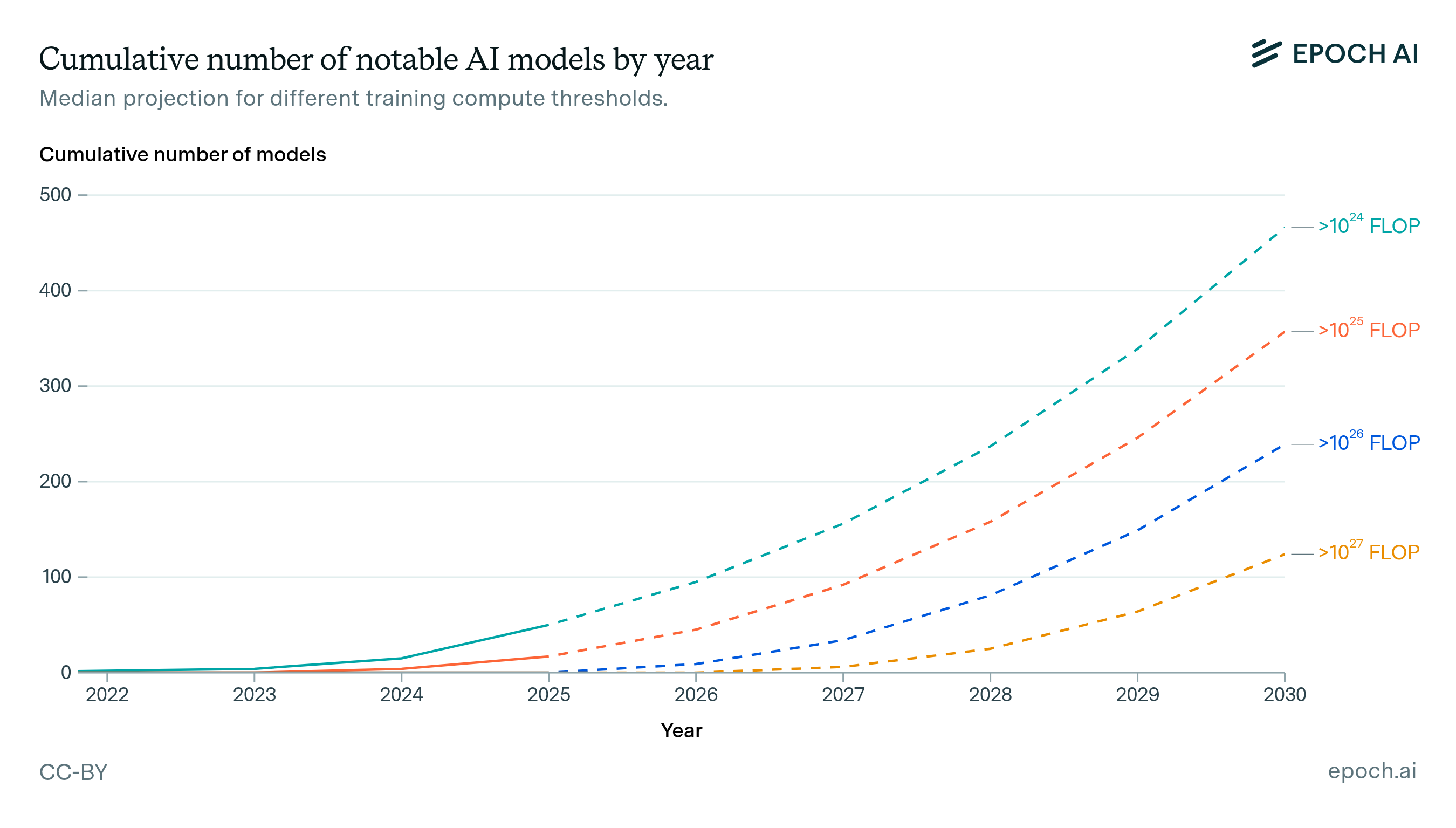
report
·
35 min read
How many AI models will exceed compute thresholds?
We project how many notable AI models will exceed training compute thresholds. Model counts rapidly grow from 10 above 1e26 FLOP by 2026, to over 200 by 2030.
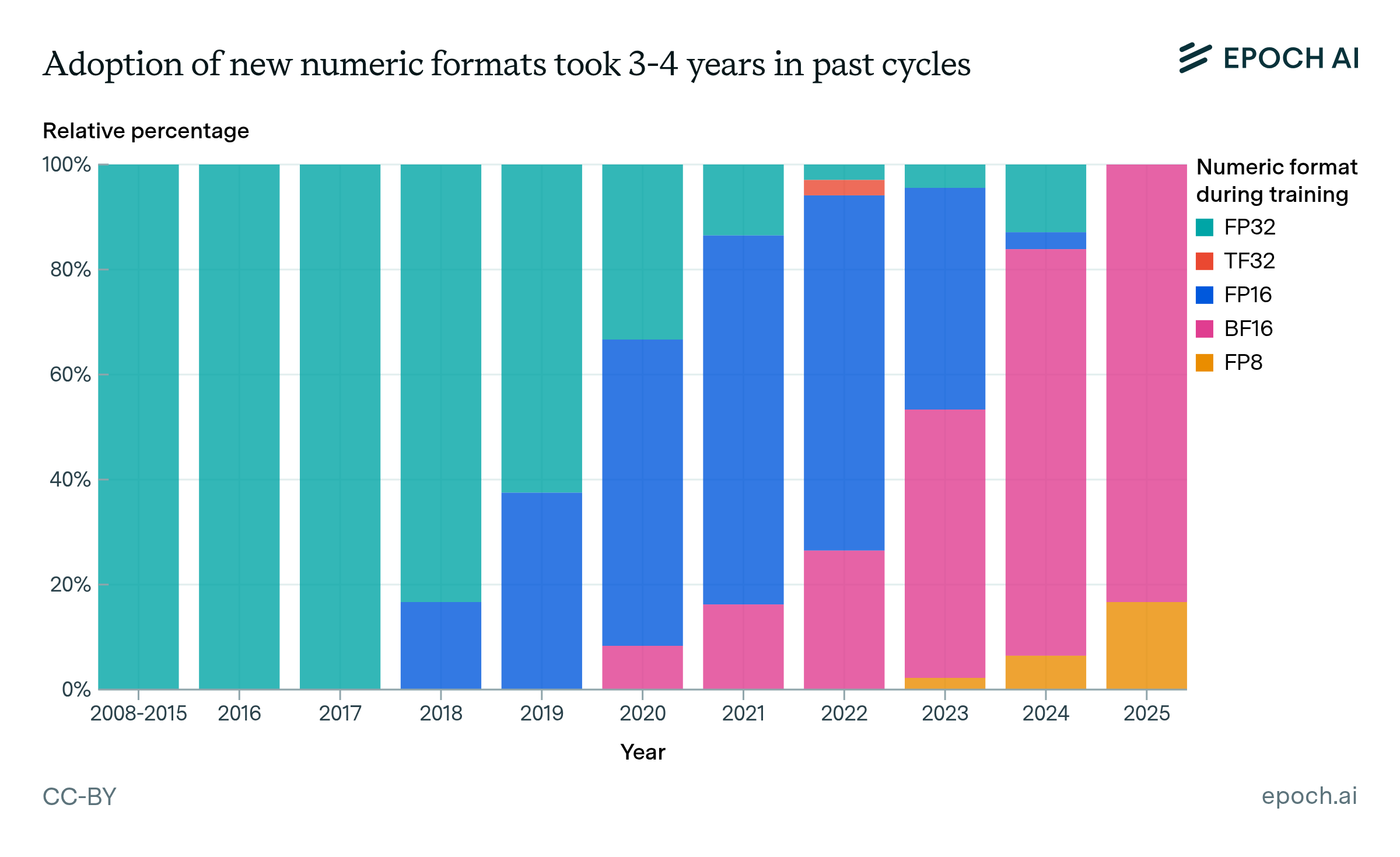
data insight
·
4 min read
Widespread adoption of new numeric formats took 3-4 years in past cycles

newsletter
·
7 min read
Is AI already superhuman on FrontierMath?

newsletter
·
8 min read
How fast can algorithms advance capabilities?

newsletter
·
10 min read
How far can reasoning models scale?

newsletter
·
10 min read
Where’s my ten minute AGI?

newsletter
·
12 min read
The case for multi-decade AI timelines
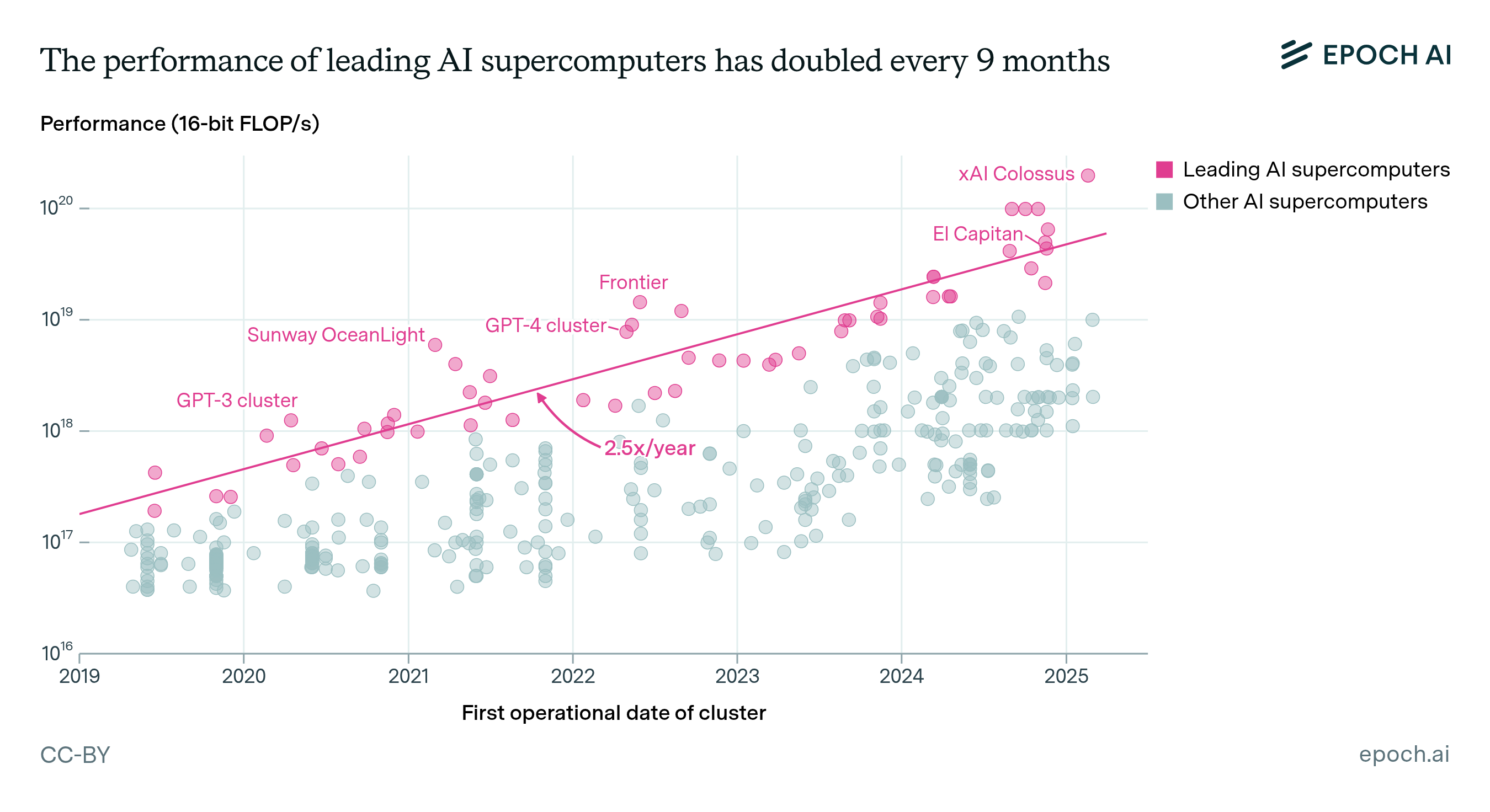
paper
·
4 min read
Trends in AI supercomputers
AI supercomputers double in performance every 9 months, cost billions of dollars, and require as much power as mid-sized cities. Companies now own 80% of all AI supercomputers, while governments’ share has declined.
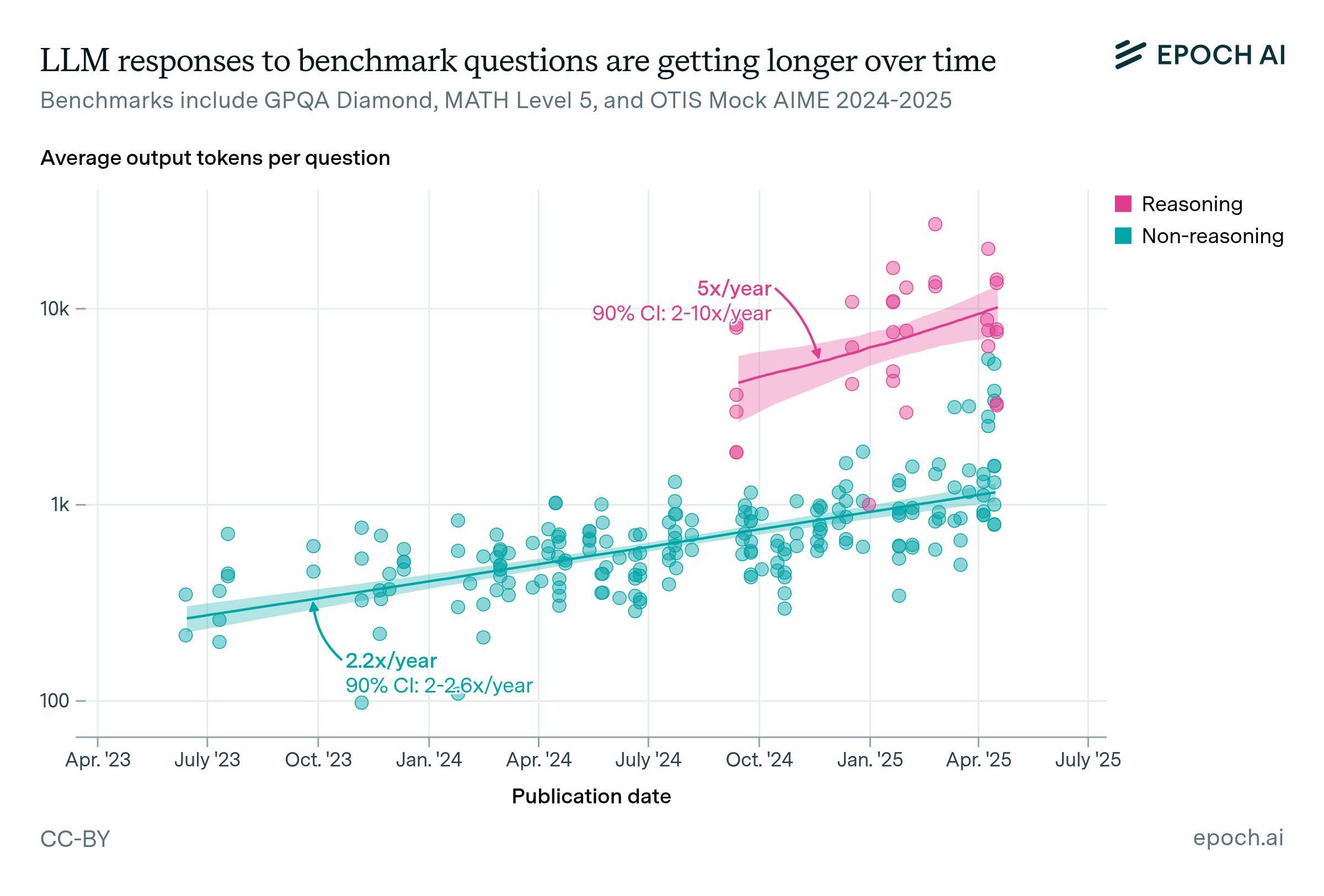
data insight
·
2 min read
LLM responses to benchmark questions are getting longer over time
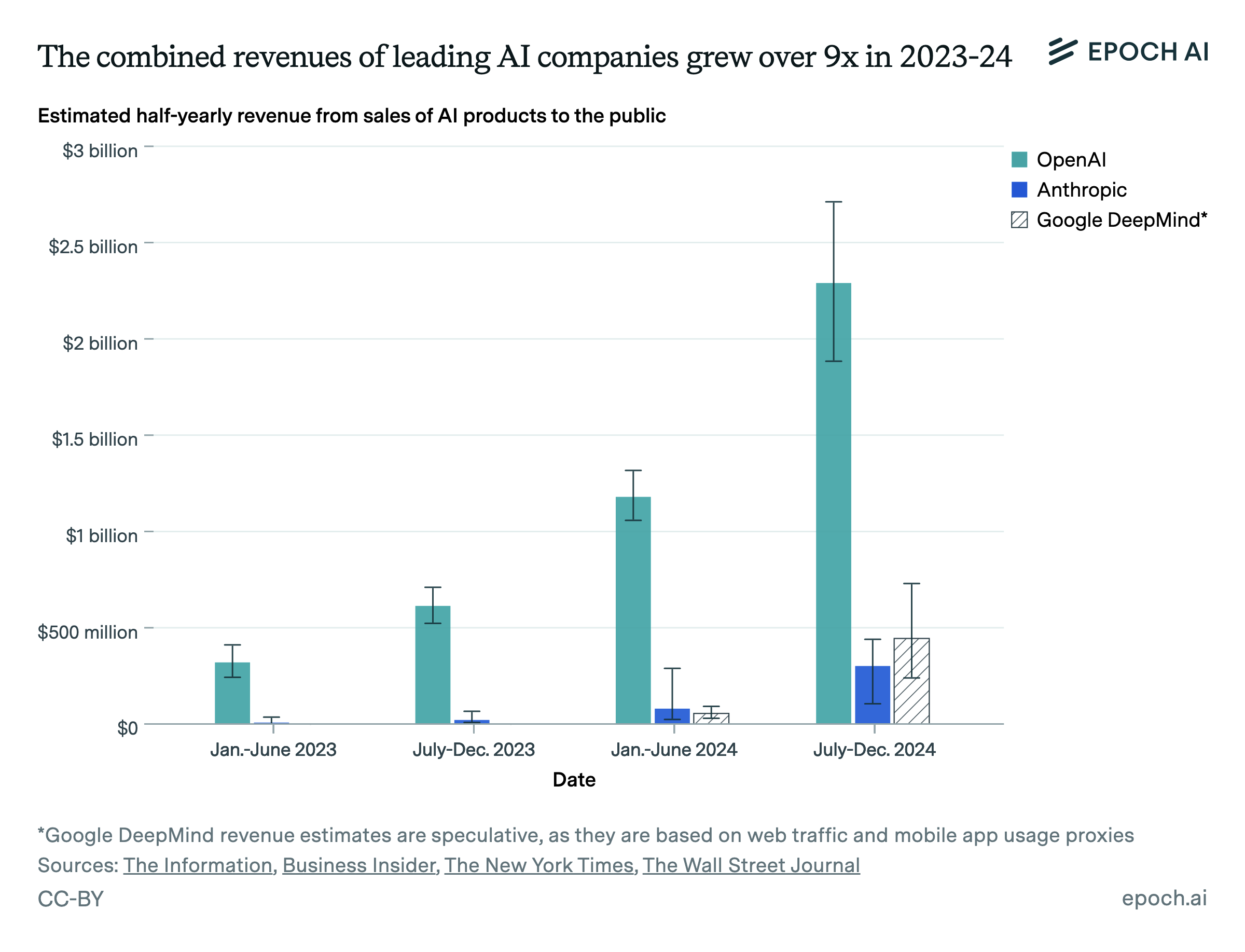
data insight
·
7 min read
The combined revenues of leading AI companies grew by over 9x in 2023-2024

newsletter
·
4 min read
The real reason AI benchmarks haven’t reflected economic impacts

newsletter
·
15 min read
Most AI value will come from broad automation, not from R&D

paper
·
5 min read
GATE: Modeling the trajectory of AI and automation
We introduce a compute-centric model of AI automation and its economic effects, illustrating key dynamics of AI development. The model suggests large AI investments and subsequent economic growth.

update
·
1 min read
FrontierMath competition: Setting benchmarks for AI evaluation
We are hosting a competition to establish rigorous human performance baselines for FrontierMath. With a prize pool of $10,000, your participation will contribute directly to measuring AI progress in solving challenging mathematical problems.
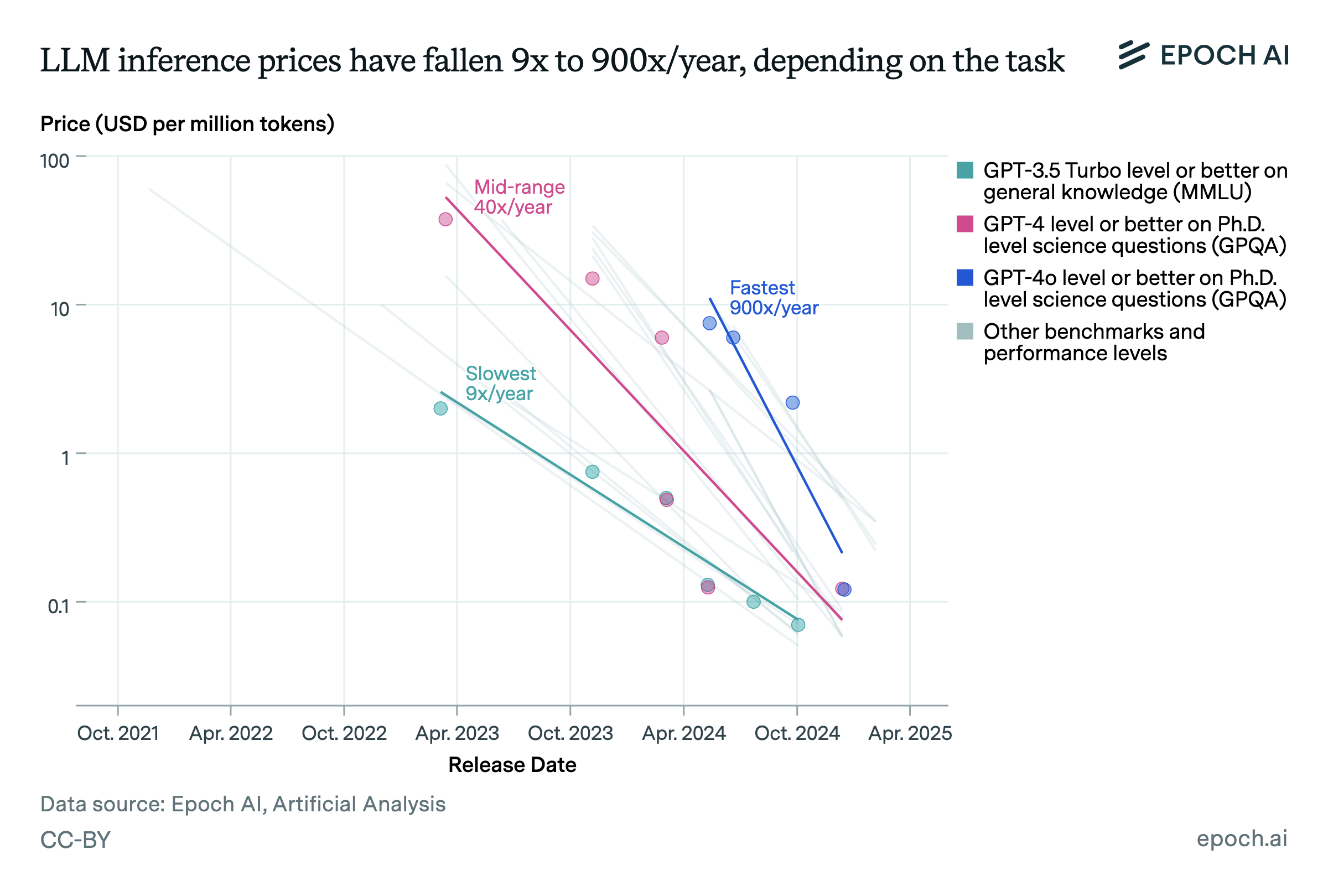
data insight
·
5 min read
LLM inference prices have fallen rapidly but unequally across tasks

newsletter
·
10 min read
What AI can currently do is not the story

report
·
9 min read
Train once, deploy many: AI and increasing returns
AI's “train-once-deploy-many” advantage yields increasing returns: doubling compute more than doubles output by increasing models' inference efficiency and enabling more deployed inference instances.
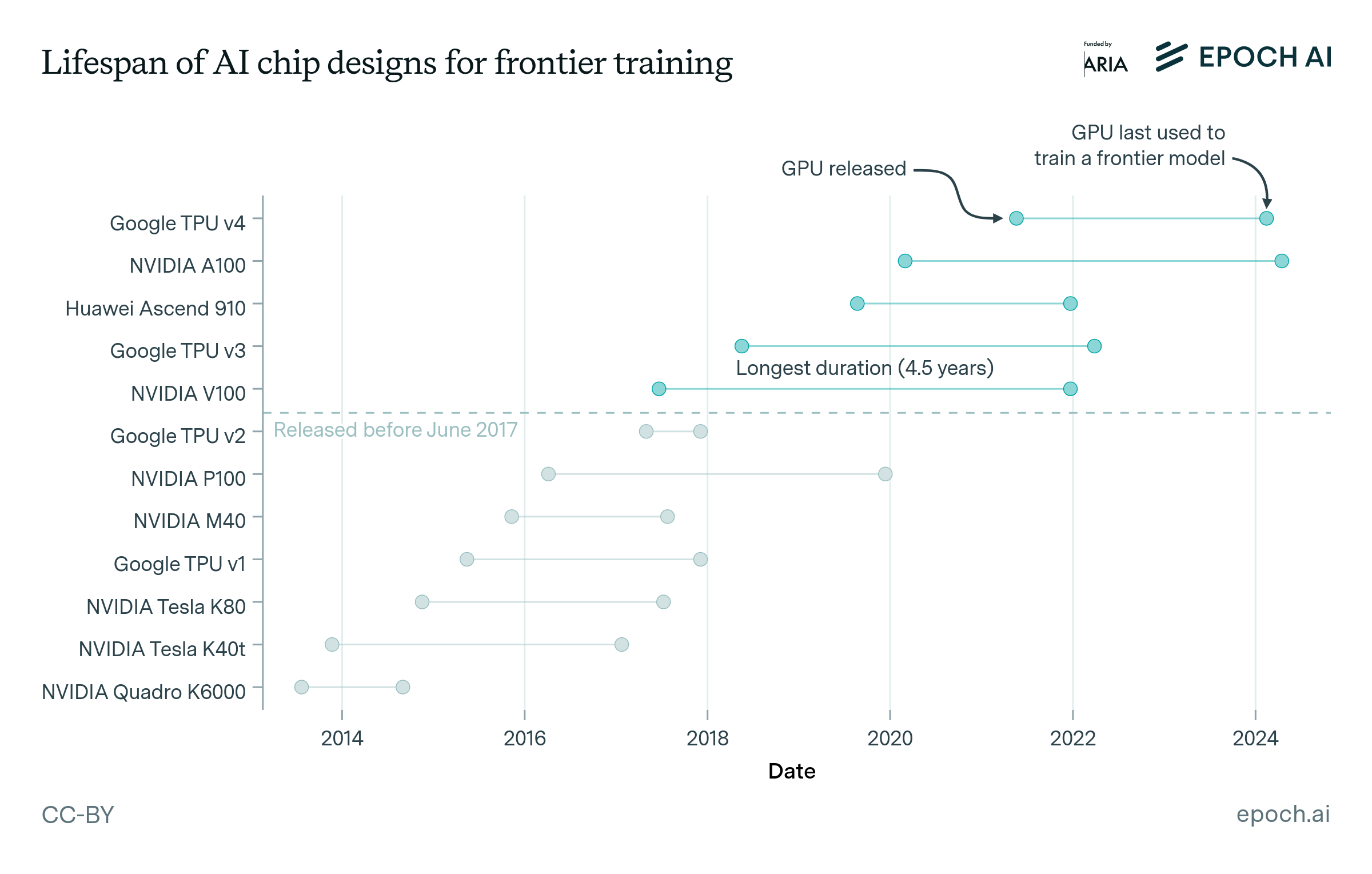
data insight
·
4 min read
Leading AI chip designs are used for around four years in frontier training

newsletter
·
14 min read
The promise of reasoning models
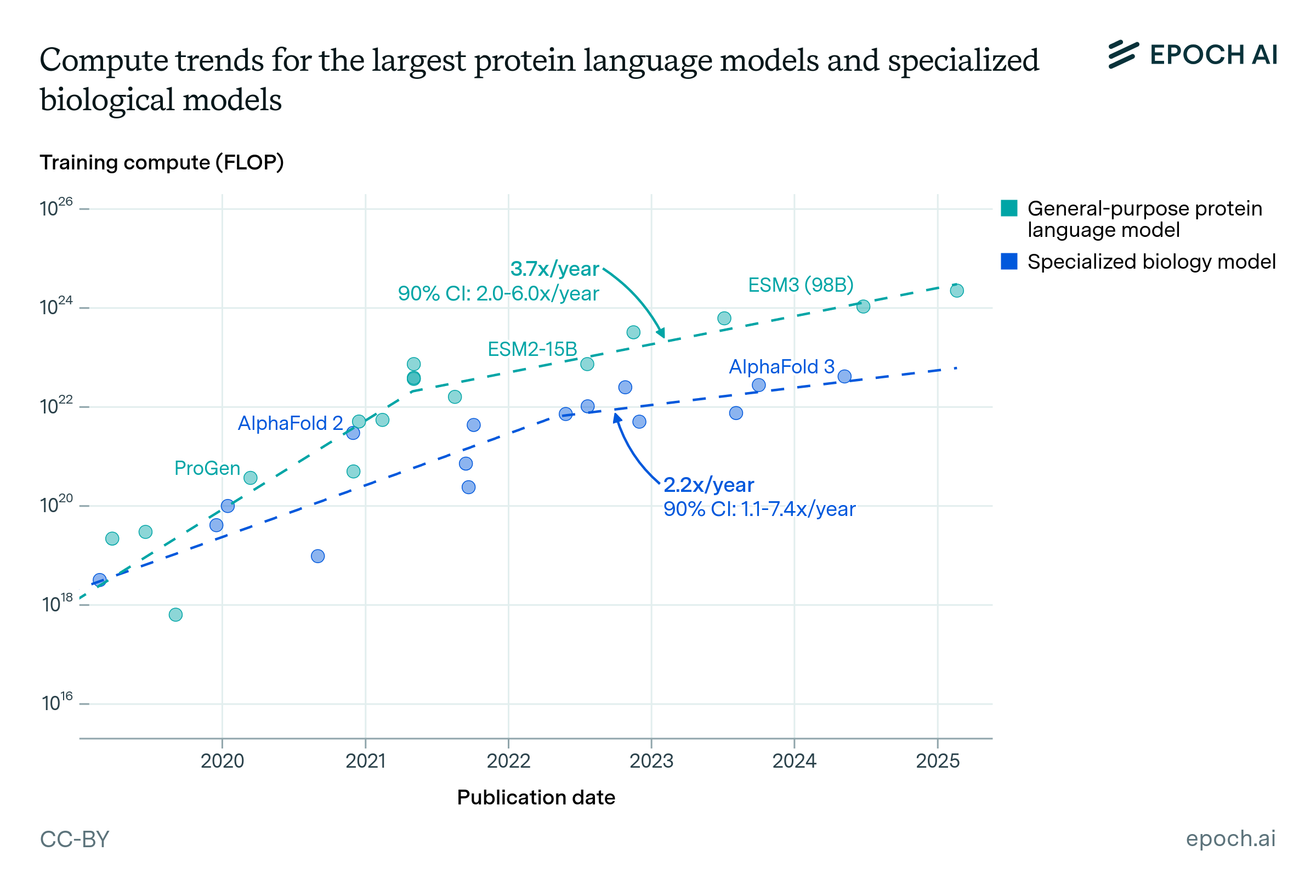
data insight
·
3 min read
Biology AI models are scaling 2-4x per year after rapid growth from 2019-2021

newsletter
·
11 min read
AI progress is about to speed up

newsletter
·
13 min read
Algorithmic progress likely spurs more spending on compute, not less
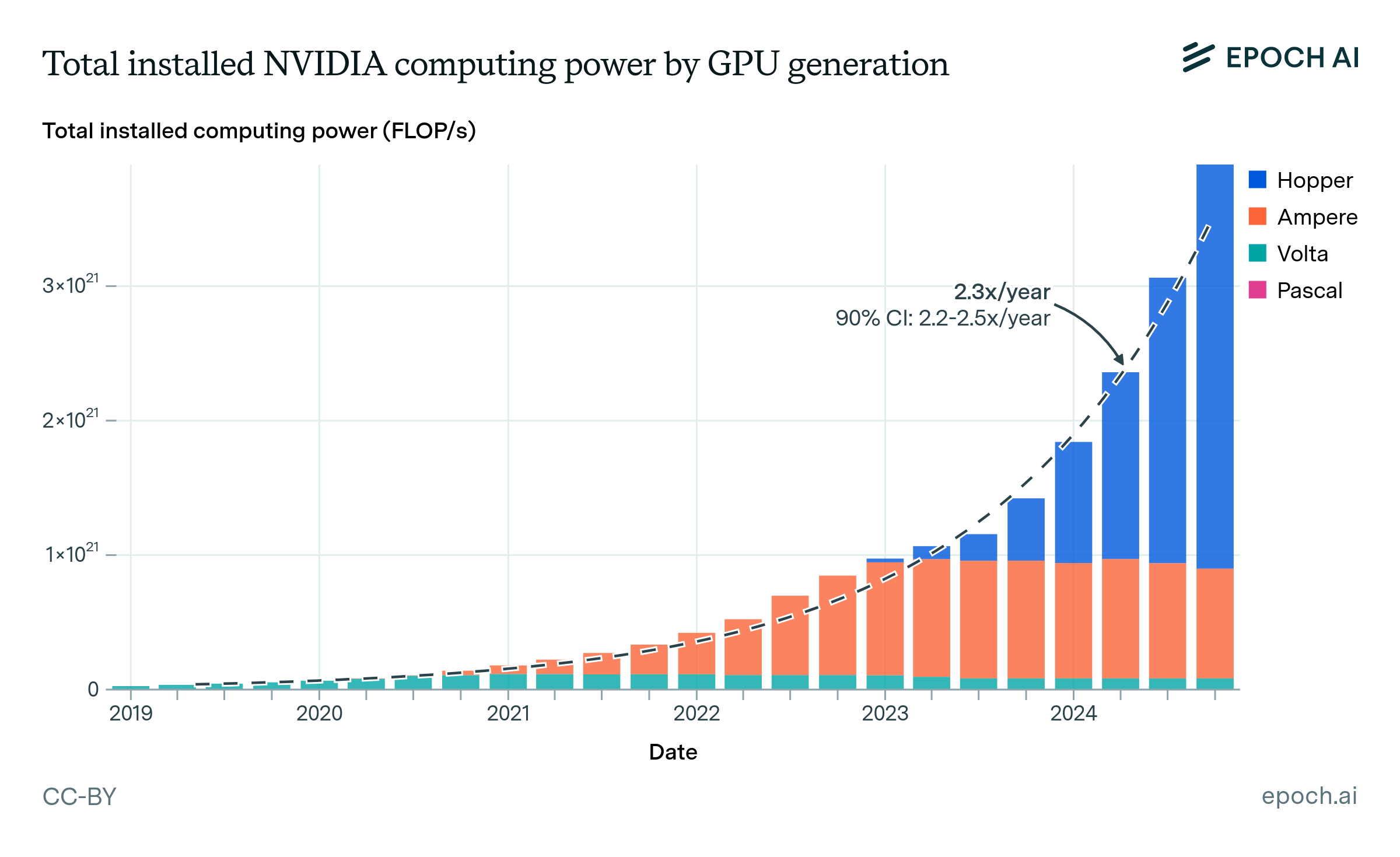
data insight
·
7 min read
The stock of computing power from NVIDIA chips is doubling every 10 months
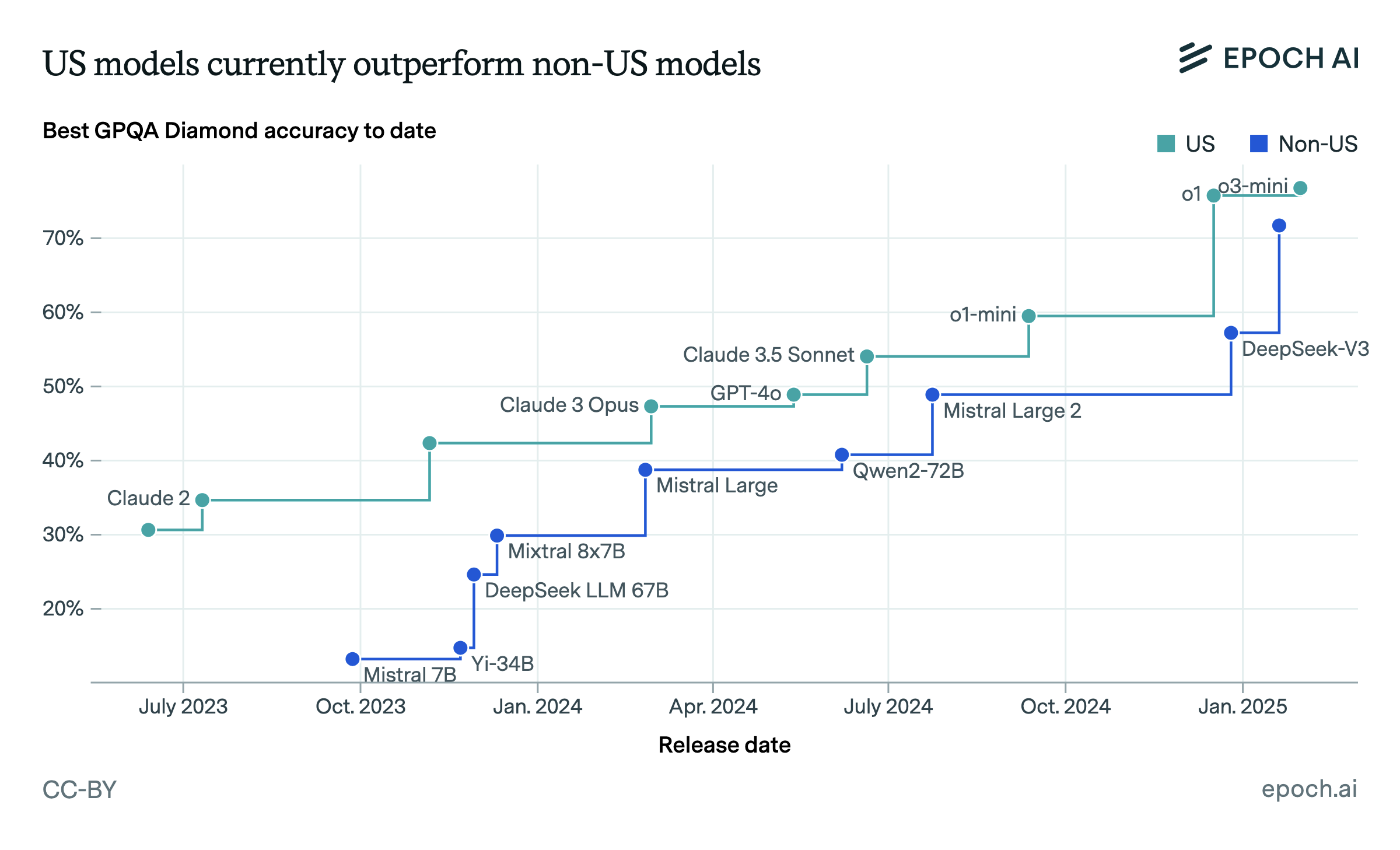
data insight
·
1 min read
US models currently outperform non-US models
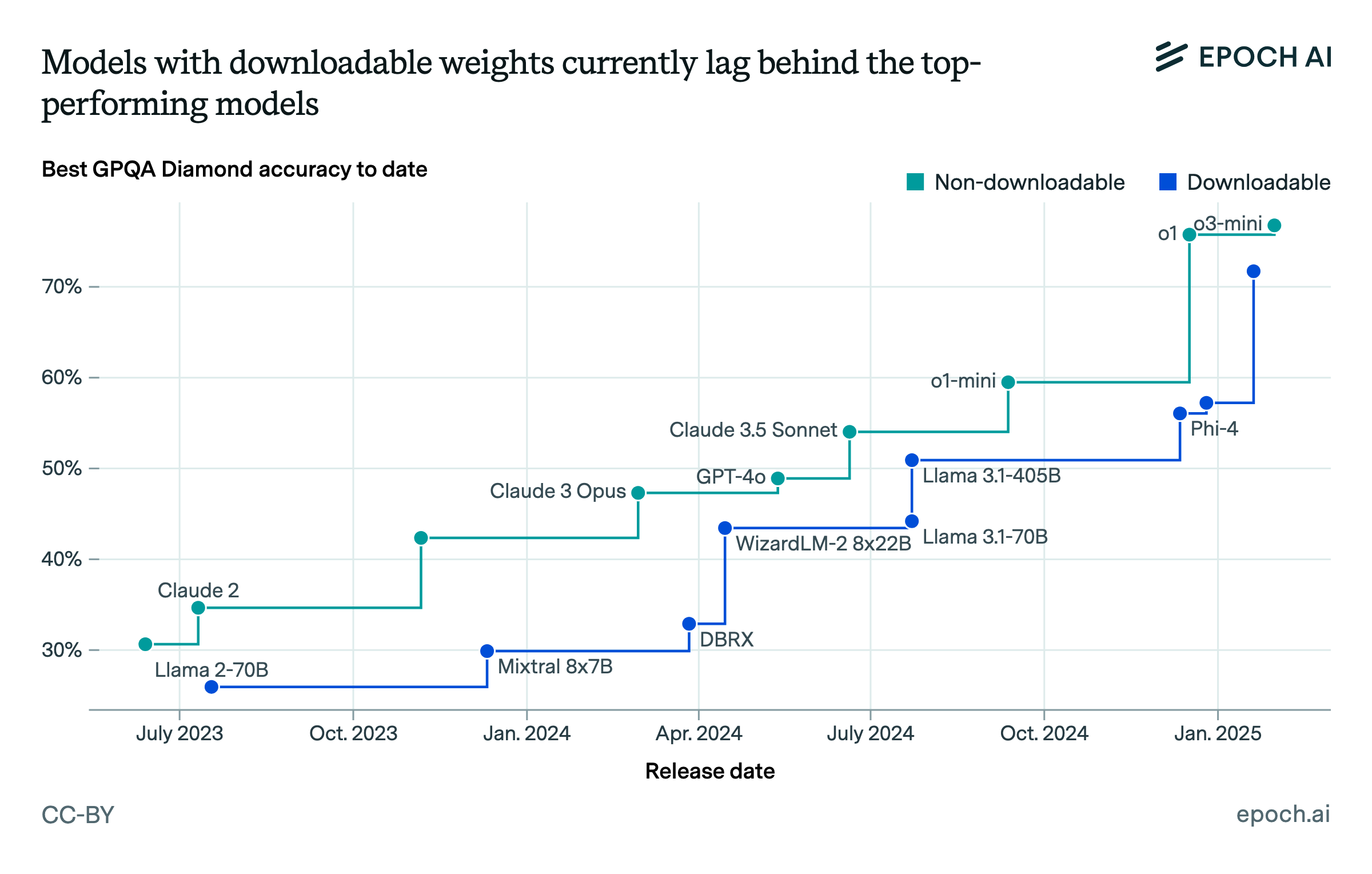
data insight
·
1 min read
Models with downloadable weights currently lag behind the top-performing models
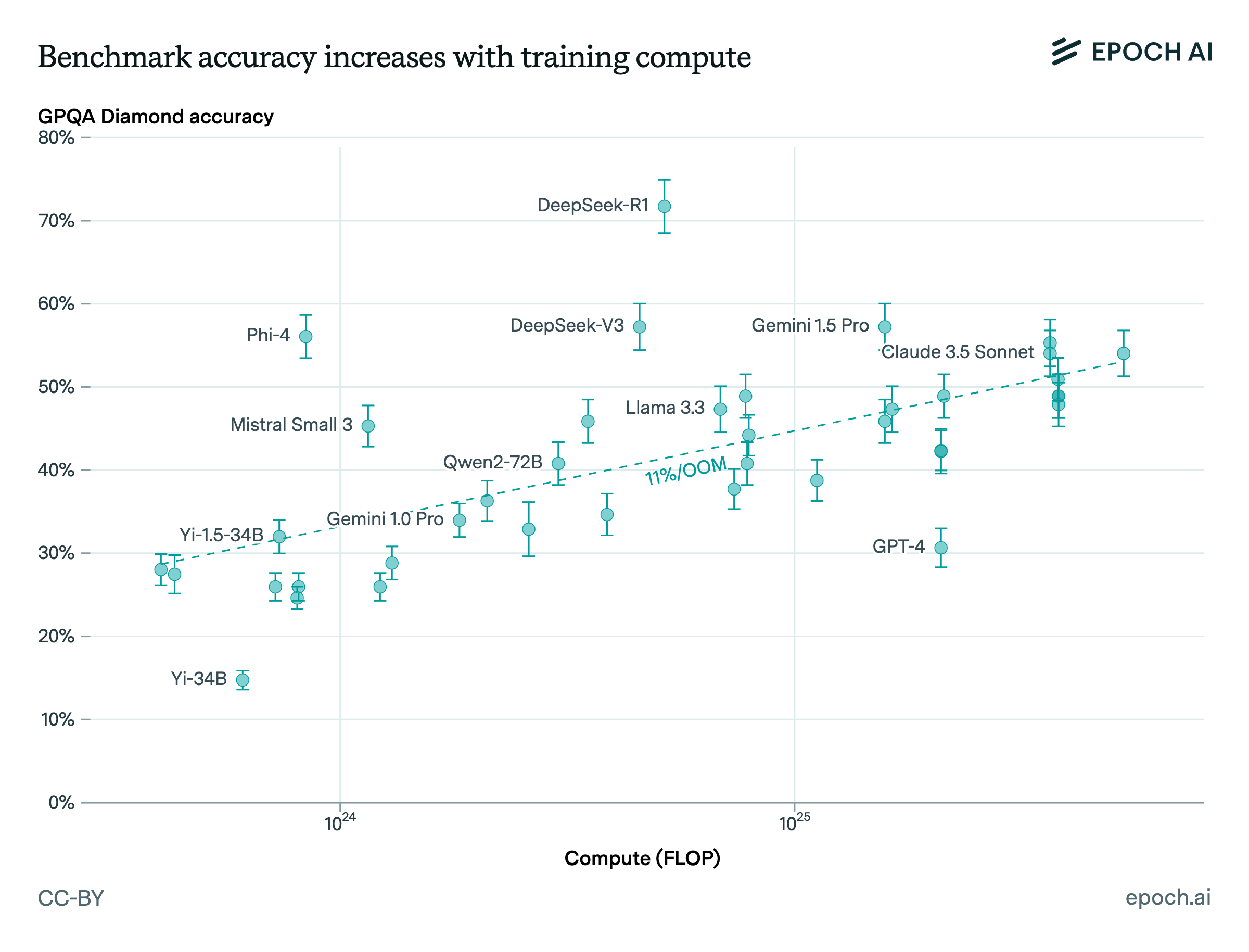
data insight
·
1 min read
Accuracy increases with estimated training compute

newsletter
·
22 min read
How much energy does ChatGPT use?
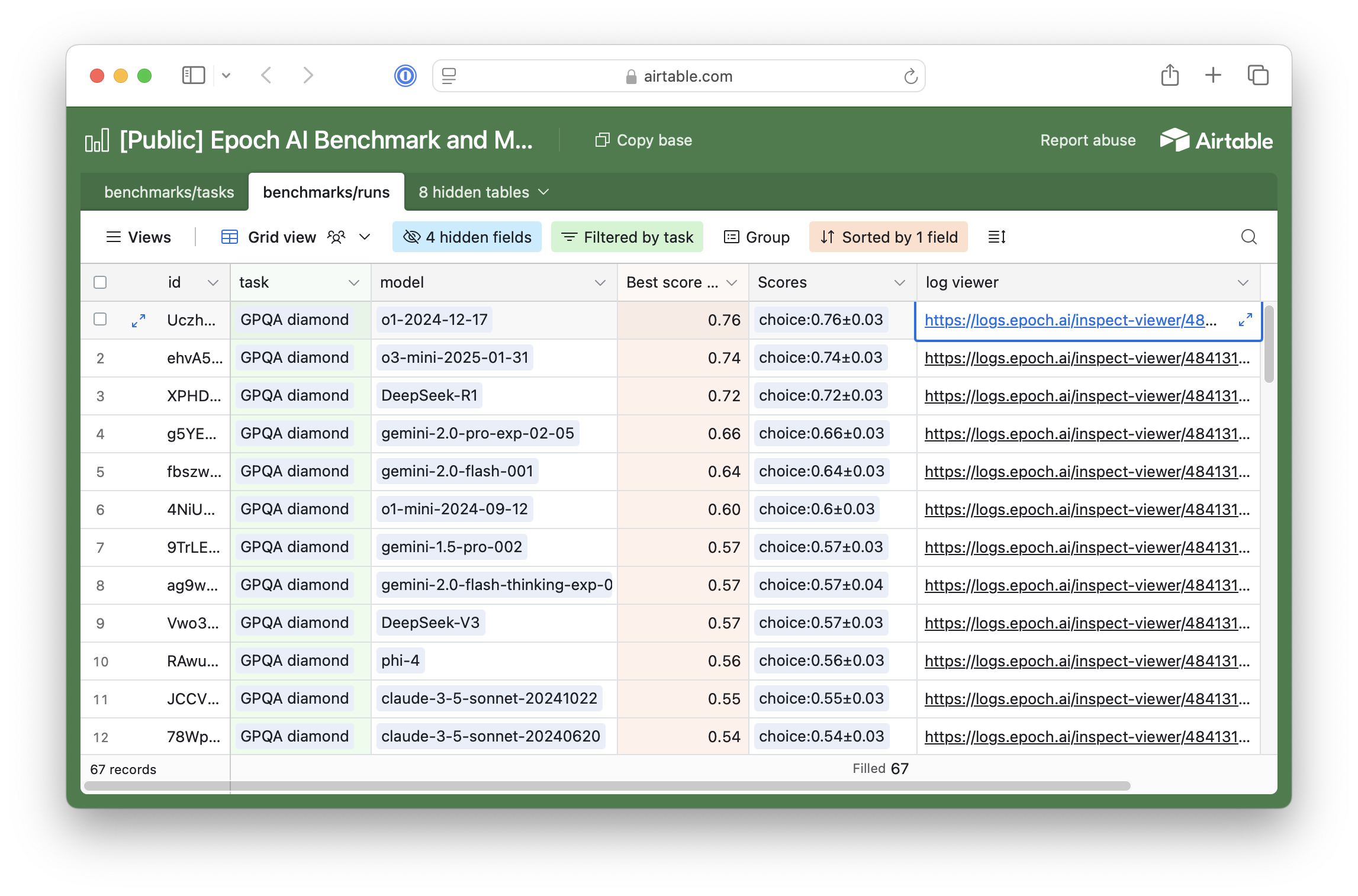
update
·
3 min read
A more systematic and transparent AI benchmarking hub
We've overhauled our AI benchmarking infrastructure to provide more transparent, systematic, and up-to-date evaluations of AI model capabilities.

newsletter
·
14 min read
What went into training DeepSeek-R1?
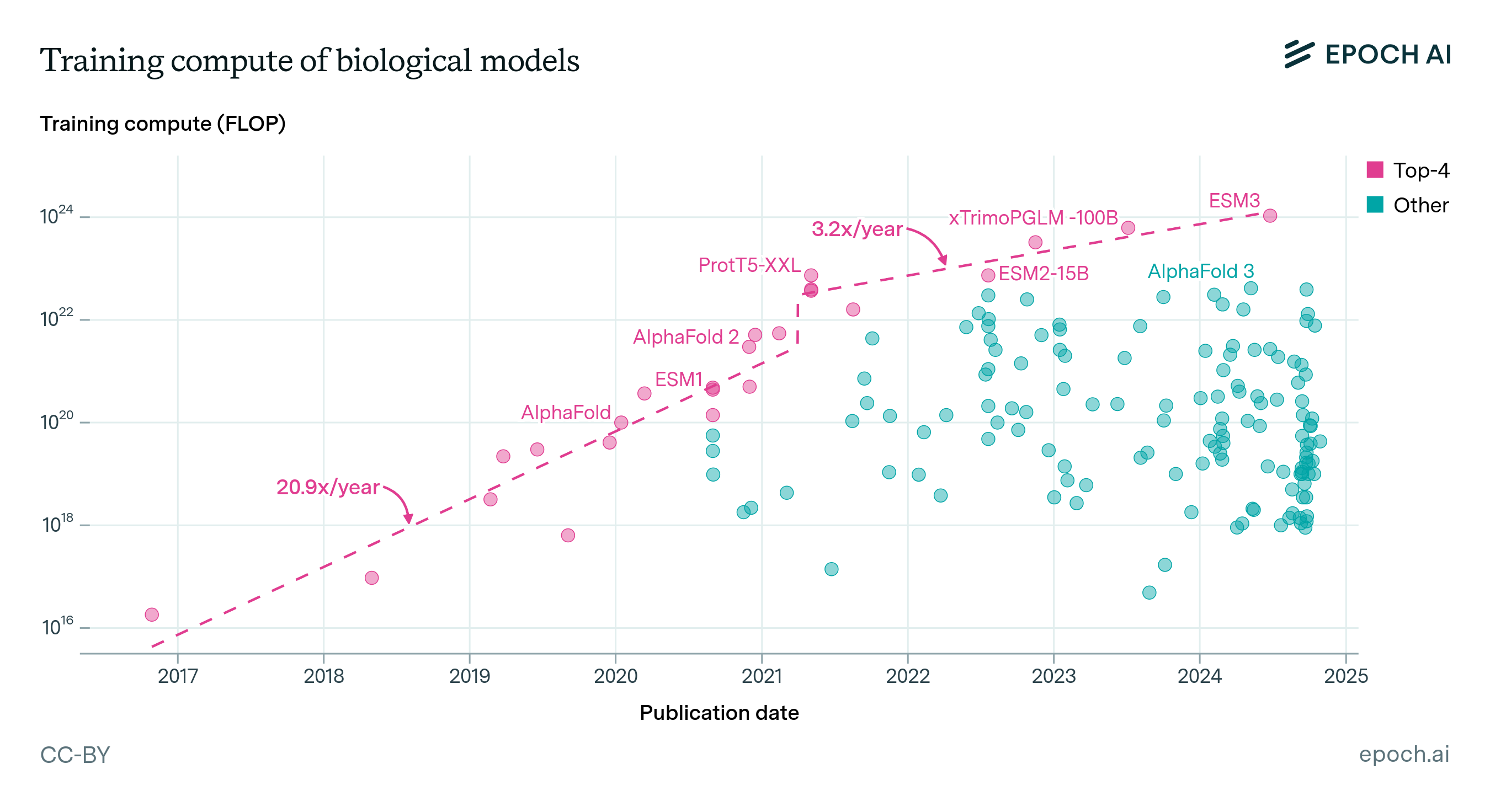
update
·
2 min read
Announcing our expanded biology AI coverage
We've expanded our Biology AI Dataset, now covering 360+ models. Our analysis reveals rapid scaling from 2017-2021, followed by a notable slowdown in biological model development.

newsletter
·
16 min read
AGI could drive wages below subsistence level

update
·
2 min read
Clarifying the creation and use of the FrontierMath benchmark
We clarify that OpenAI commissioned Epoch AI to produce 300 math questions for the FrontierMath benchmark. They own these and have access to the statements and solutions, except for a 50-question holdout set.

data insight
·
4 min read
Chinese language models have scaled up more slowly than their global counterparts

newsletter
·
12 min read
How has DeepSeek improved the Transformer architecture?

update
·
9 min read
2024 impact report
Epoch's Impact Report for 2024 highlights influential research on AI's trajectory, the launch of FrontierMath, an expanded AI data hub, engagement with leaders, $7M raised, and more.
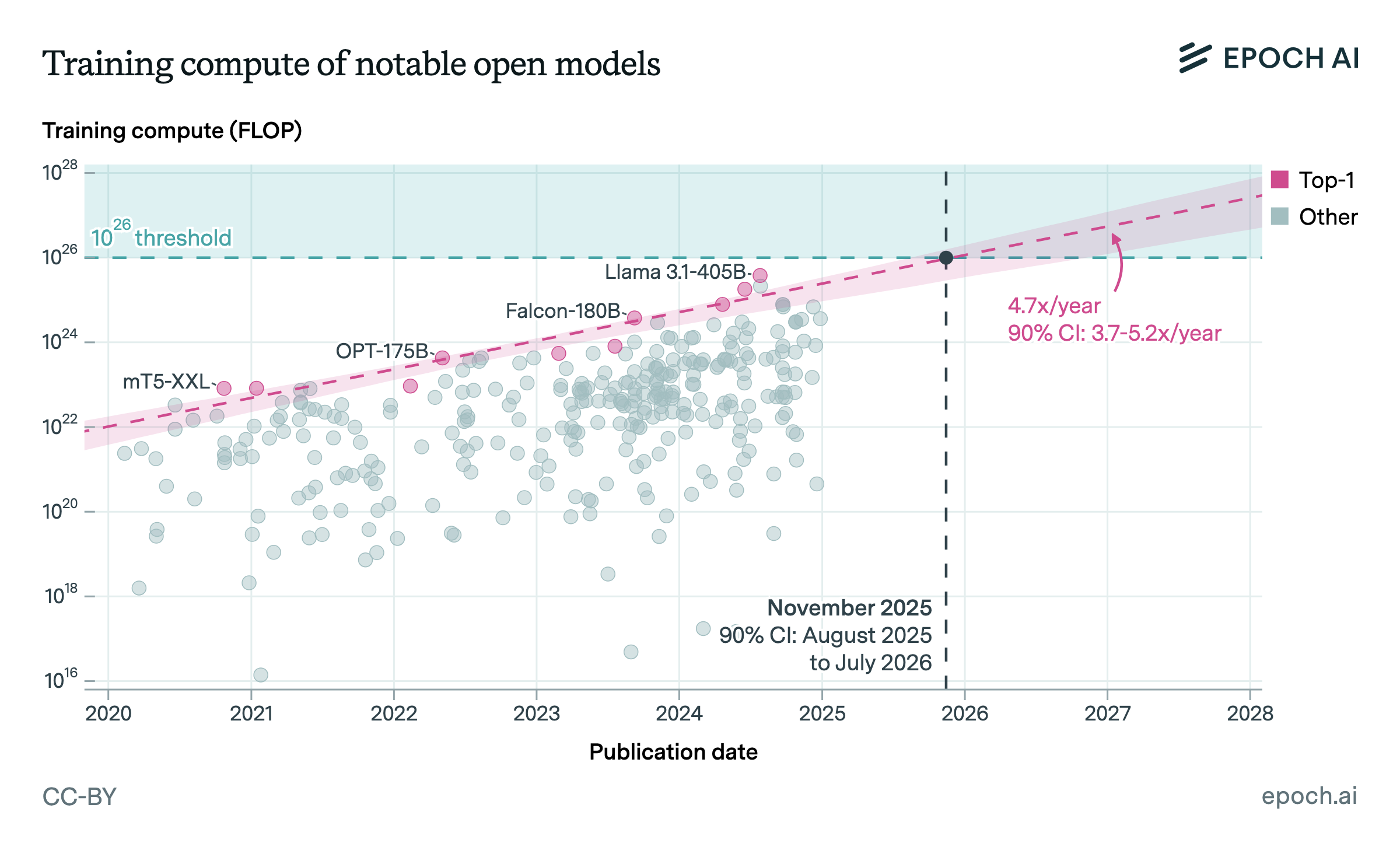
data insight
·
3 min read
Frontier open models may surpass 10²⁶ FLOP of training compute before 2026

newsletter
·
16 min read
The economic consequences of automating remote work
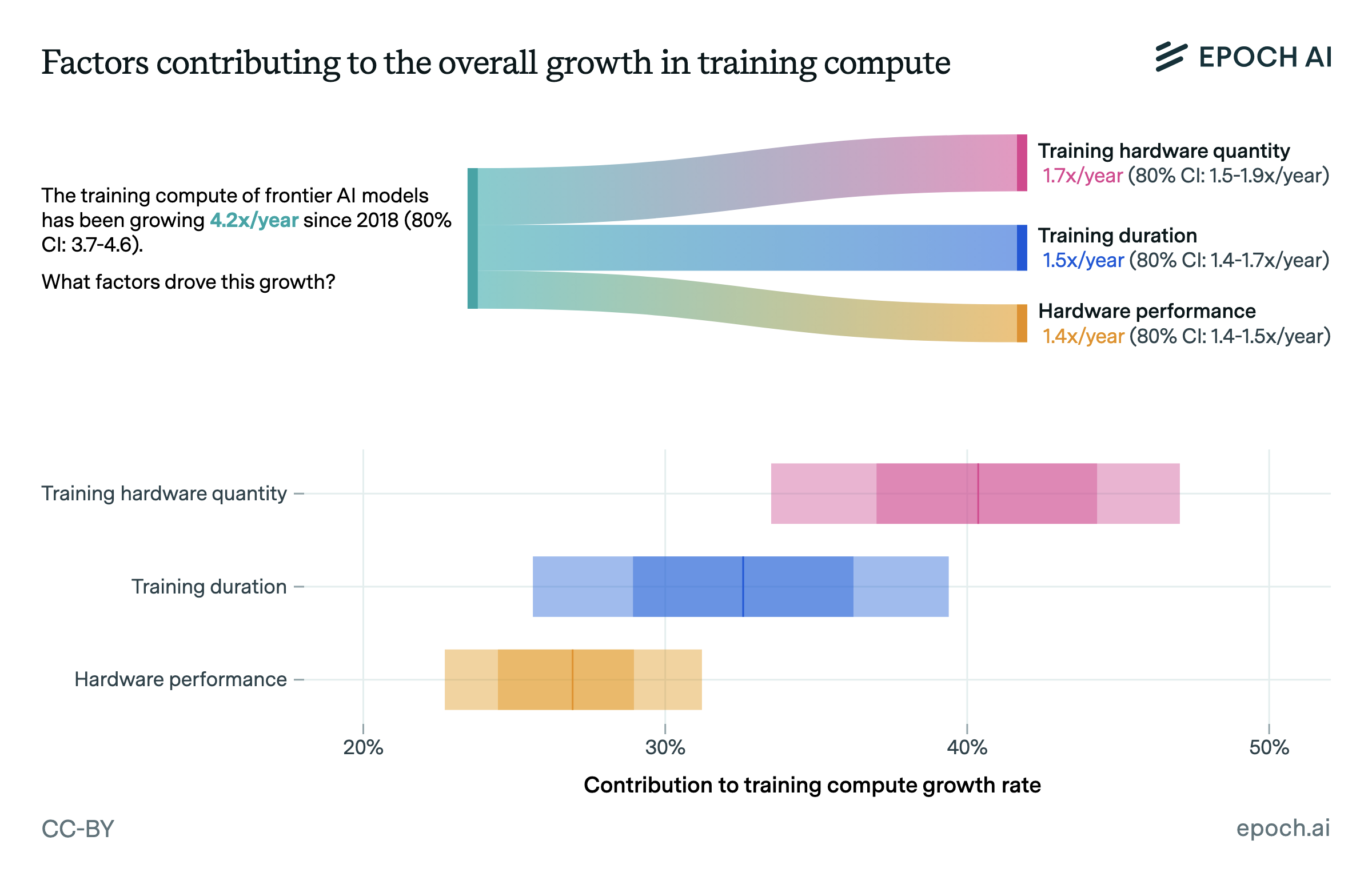
data insight
·
4 min read
Training compute growth is driven by larger clusters, longer training, and better hardware

newsletter
·
9 min read
Moravec’s paradox and its implications

newsletter
·
10 min read
How do mixture-of-experts models compare to dense models in inference?

newsletter
·
8 min read
Frontier language models have become much smaller

update
·
1 min read
Announcing Gradient Updates: Our new weekly newsletter
We are announcing Gradient Updates, Epoch AI’s new weekly newsletter focused on timely and important questions in AI.

newsletter
·
8 min read
What did US export controls mean for China’s AI capabilities?

report
·
7 min read
What is the future of AI in mathematics? Interviews with leading mathematicians
How will AI transform mathematics? Fields Medalists and other leading mathematicians discuss whether they expect AI to automate advanced math research.

update
·
6 min read
Introducing the distributed training interactive simulator
We introduce and walk you through an interactive tool that simulates distributed training runs of large language models under ideal conditions.
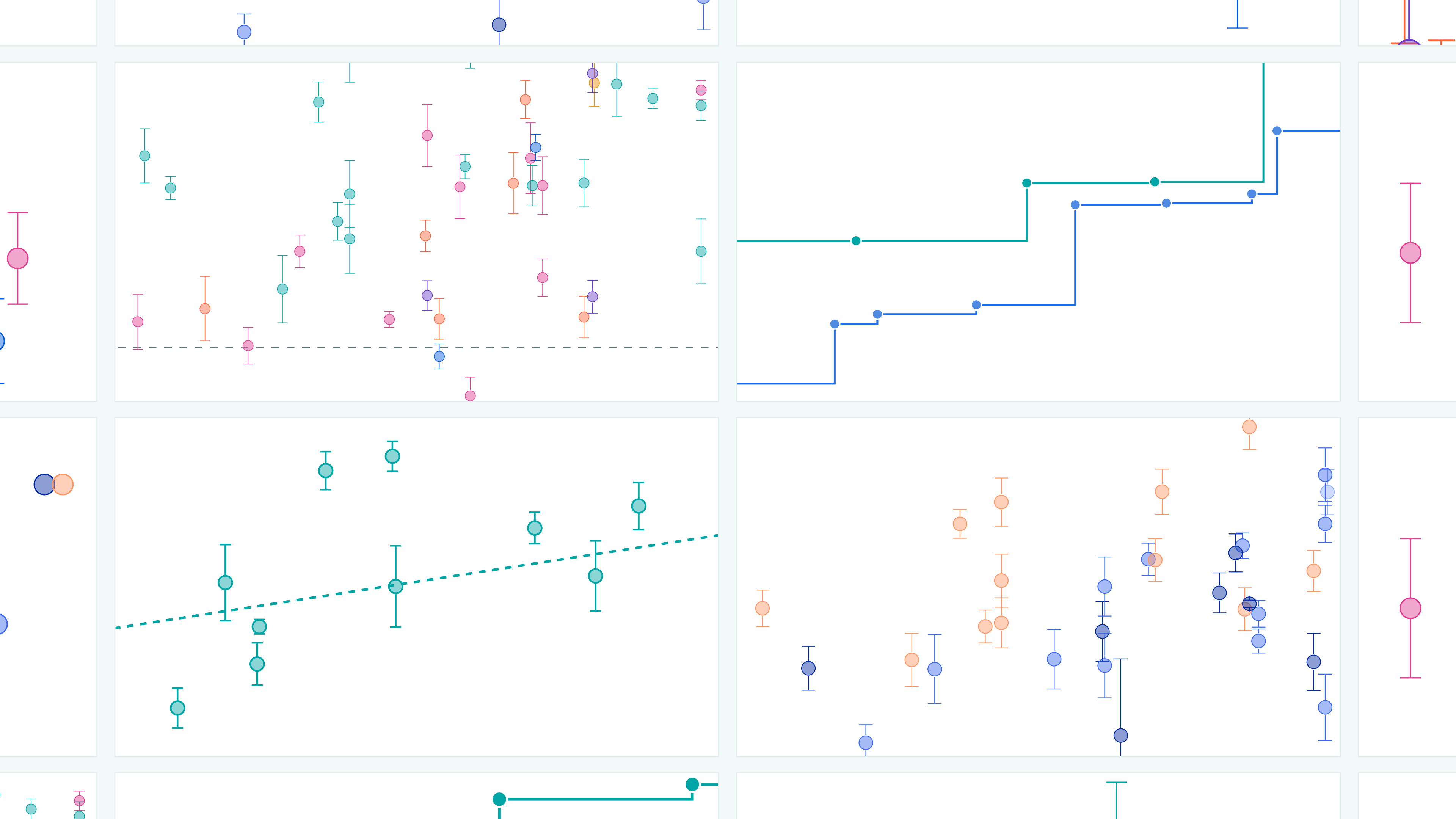
update
·
2 min read
Introducing Epoch AI's AI benchmarking hub
We are launching the AI Benchmarking Hub: a platform presenting our evaluations of leading models on challenging benchmarks, with analysis of trends in AI capabilities.

report
·
15 min read
Hardware failures won’t limit AI scaling
Hardware failures won't limit AI training scale - GPU memory checkpointing enables training with millions of GPUs despite failures.

paper
·
6 min read
FrontierMath: A benchmark for evaluating advanced mathematical reasoning in AI
FrontierMath: a new benchmark of expert-level math problems designed to measure AI's mathematical abilities. See how leading AI models perform against the collective mathematics community.
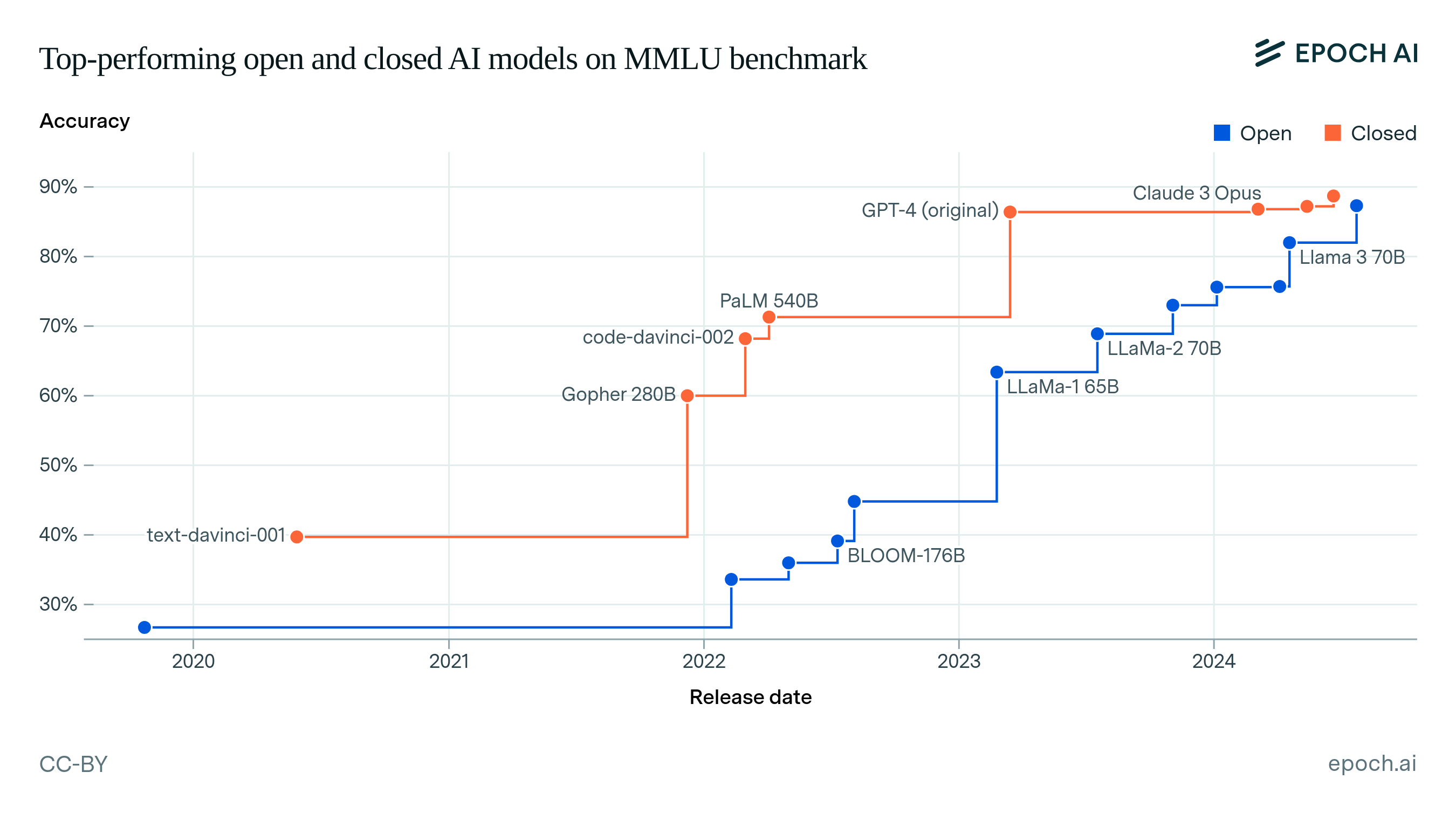
report
·
38 min read
How far behind are open models?
Analysis of open vs. closed AI models reveals the best open model today matches closed models in performance and training compute, but with a one-year lag.
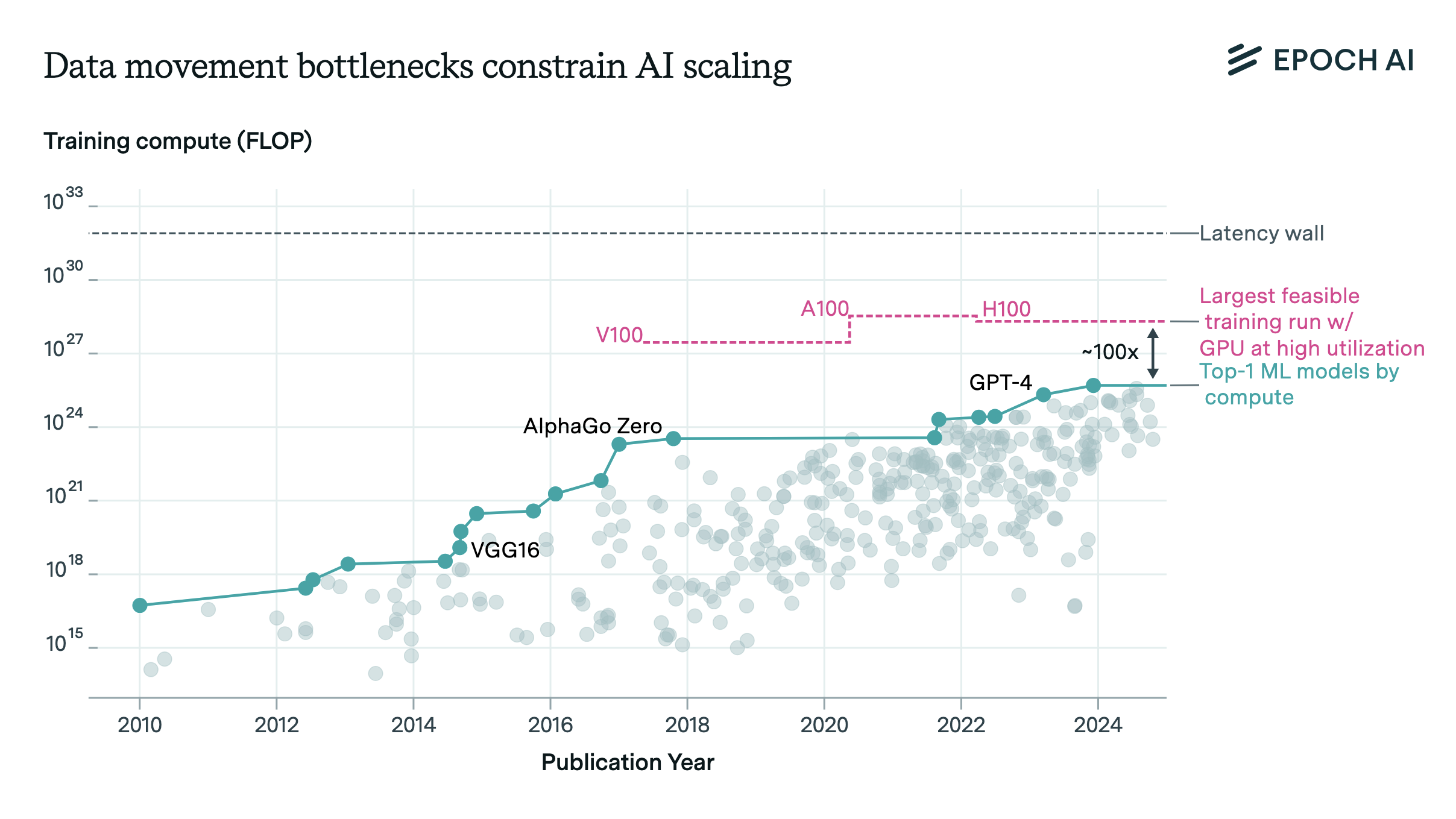
paper
·
14 min read
Data movement bottlenecks to large-scale model training: Scaling past 1e28 FLOP
Data movement bottlenecks limit LLM scaling beyond 2e28 FLOP, with a "latency wall" at 2e31 FLOP. We may hit these in ~3 years. Aggressive batch size scaling could potentially overcome these limits.
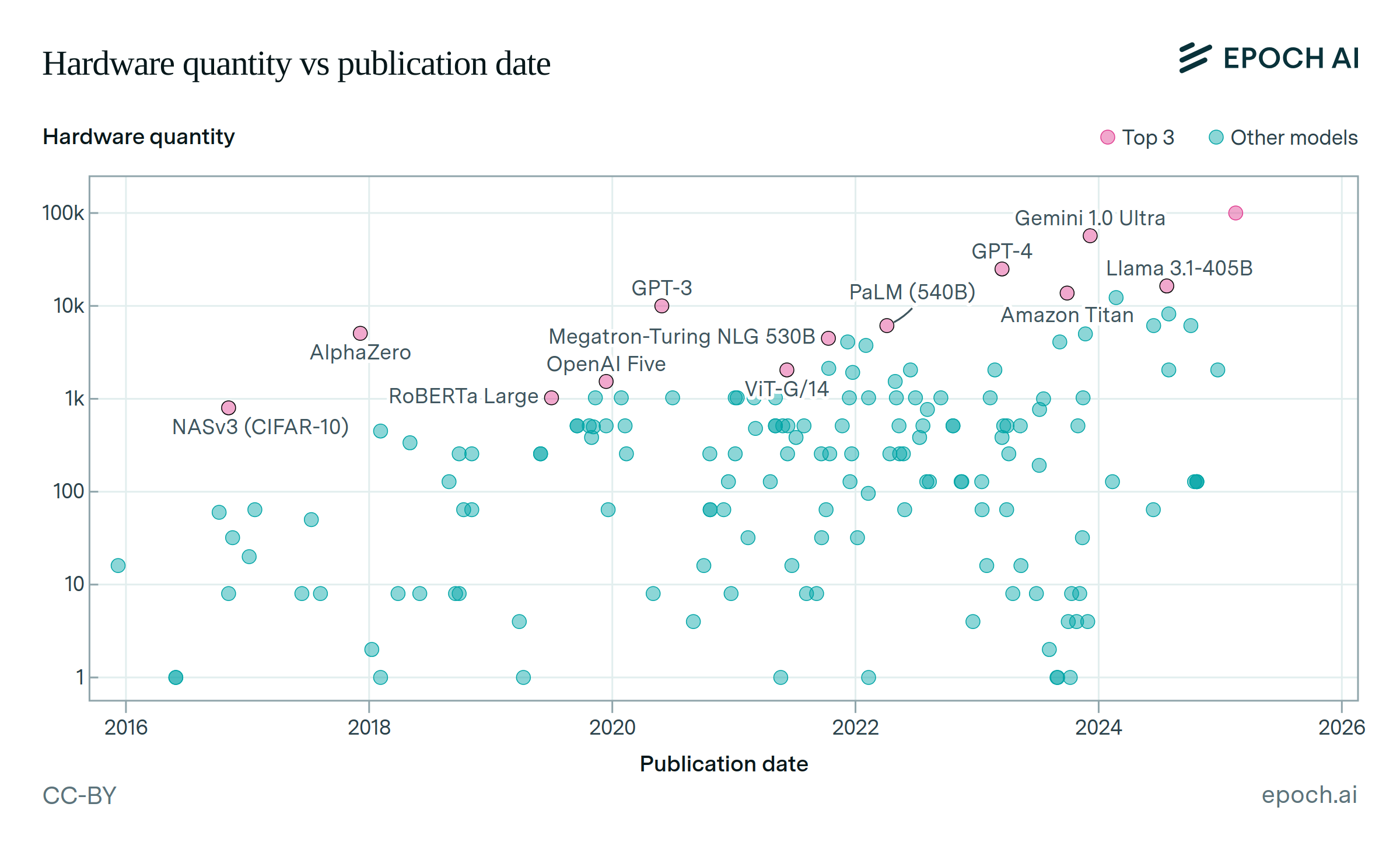
data insight
·
1 min read
AI training cluster sizes increased by more than 20x since 2016

data insight
·
1 min read
Performance per dollar improves around 30% each year

data insight
·
1 min read
The computational performance of machine learning hardware has doubled every 2.3 years
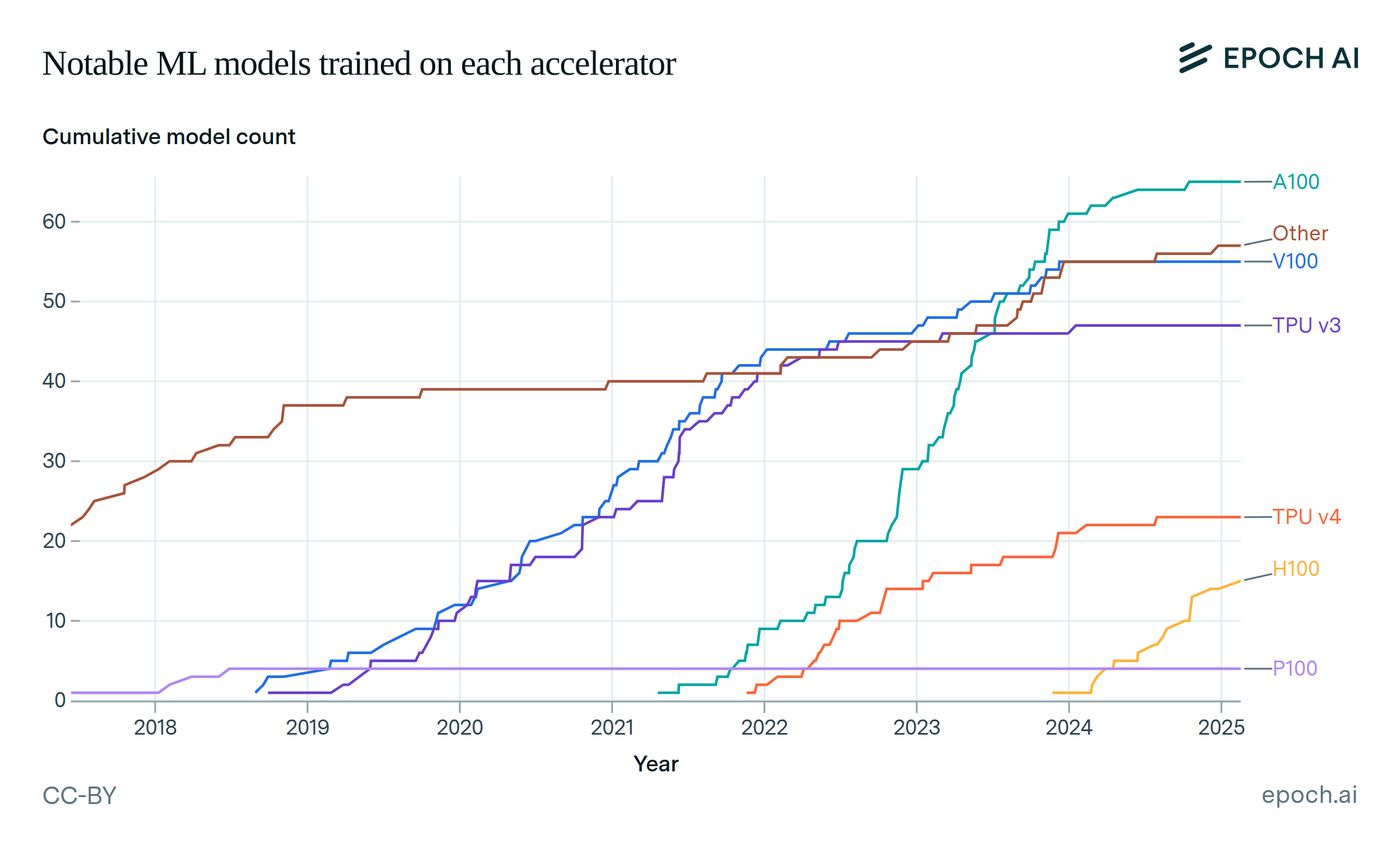
data insight
·
1 min read
The NVIDIA A100 has been the most popular hardware for training notable machine learning models
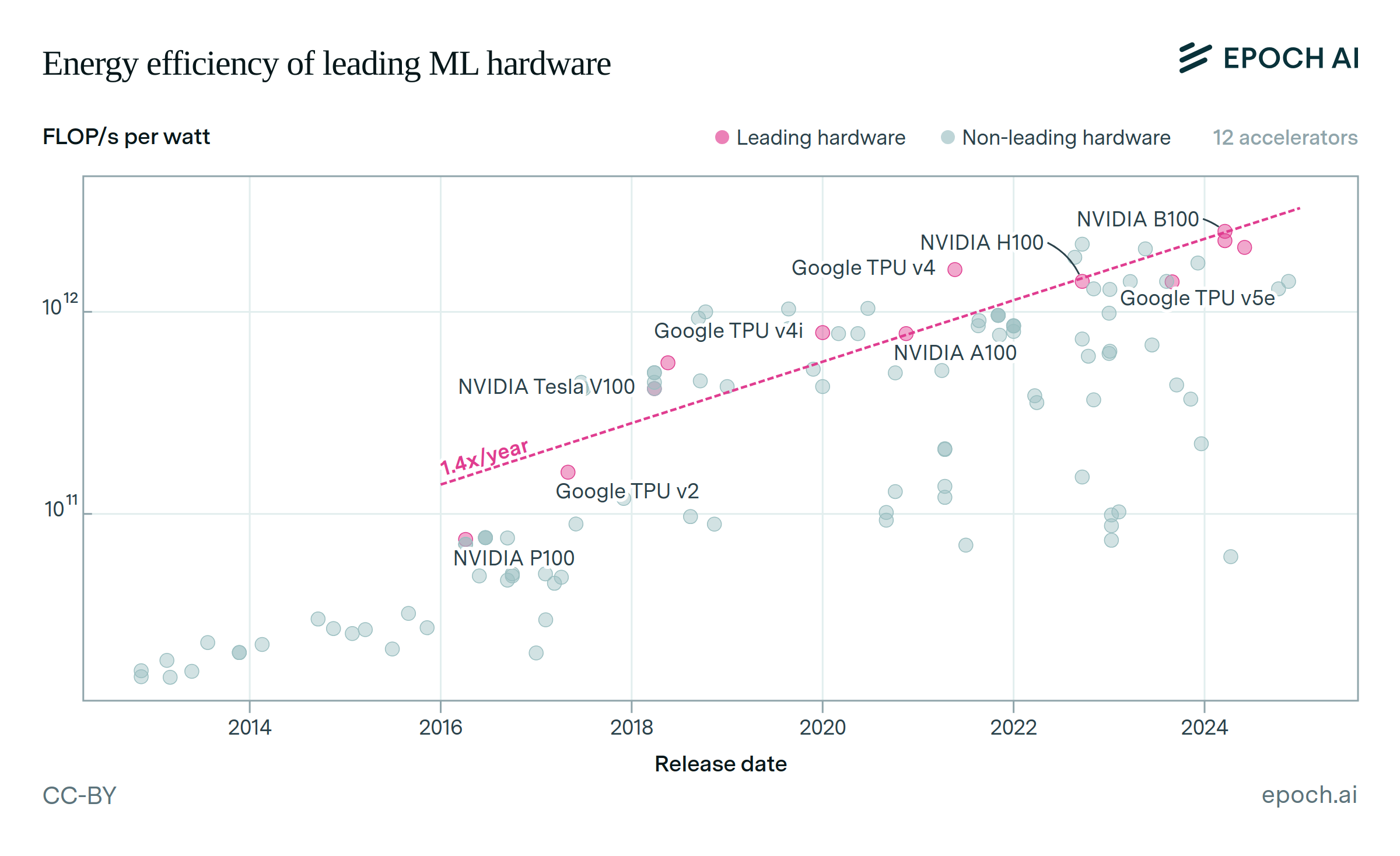
data insight
·
1 min read
Leading ML hardware becomes 40% more energy-efficient each year
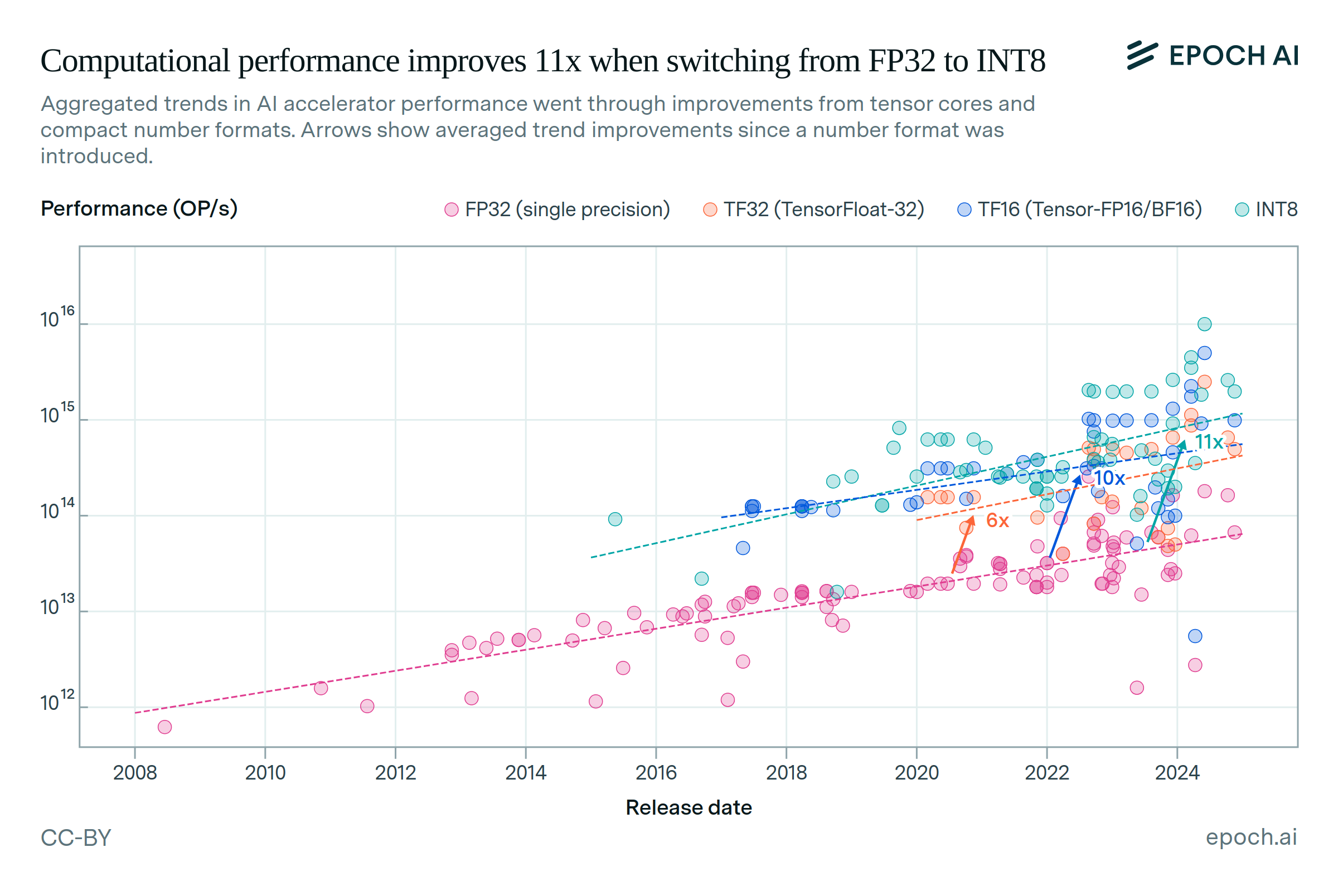
data insight
·
1 min read
Performance improves 13x when switching from FP32 to tensor-INT8

update
·
1 min read
Introducing Epoch AI's machine learning hardware database
Our new database covers hardware used to train AI models, featuring over 100 accelerators (GPUs and TPUs) across the deep learning era.
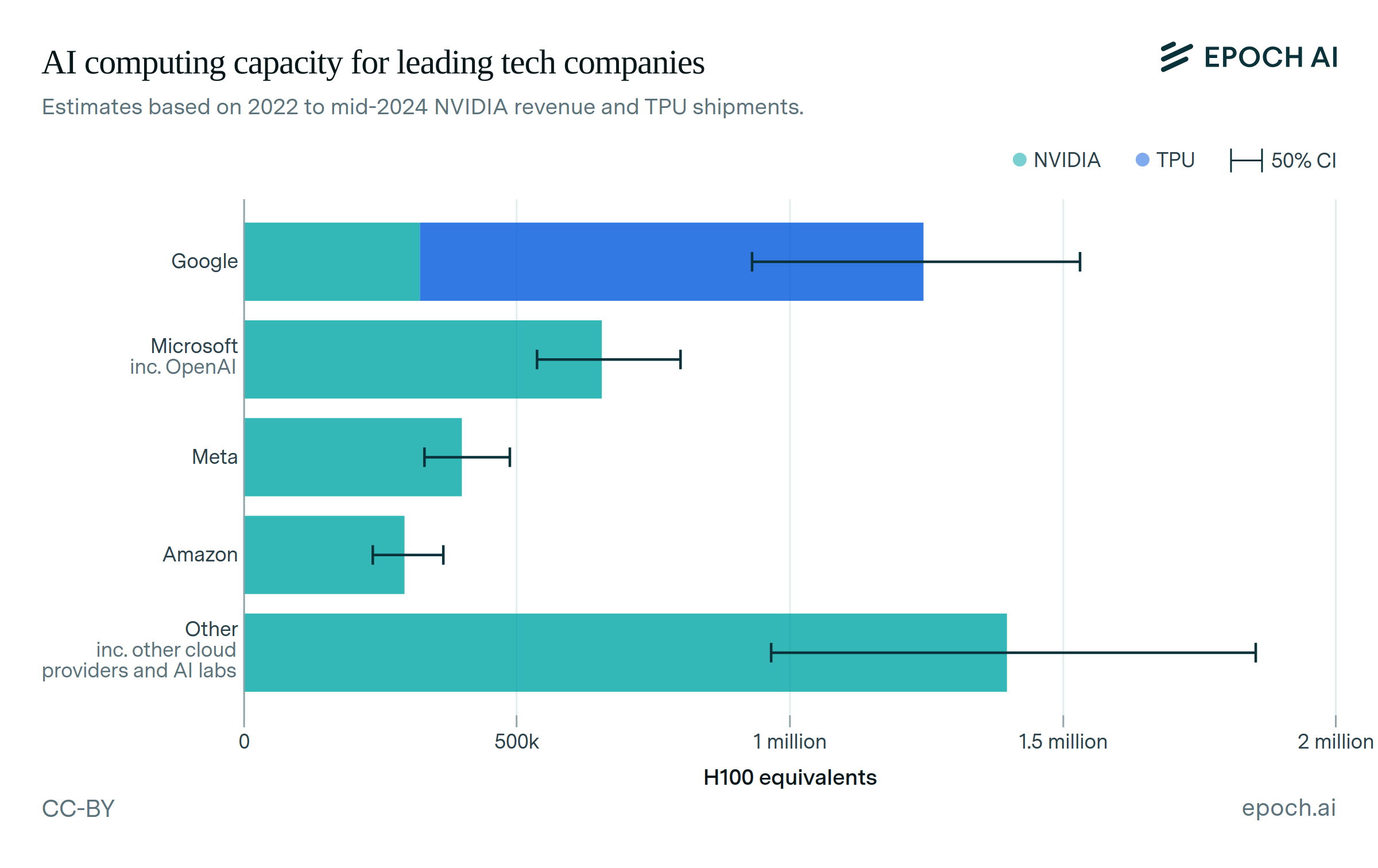
data insight
·
8 min read
Leading AI companies have hundreds of thousands of cutting-edge AI chips
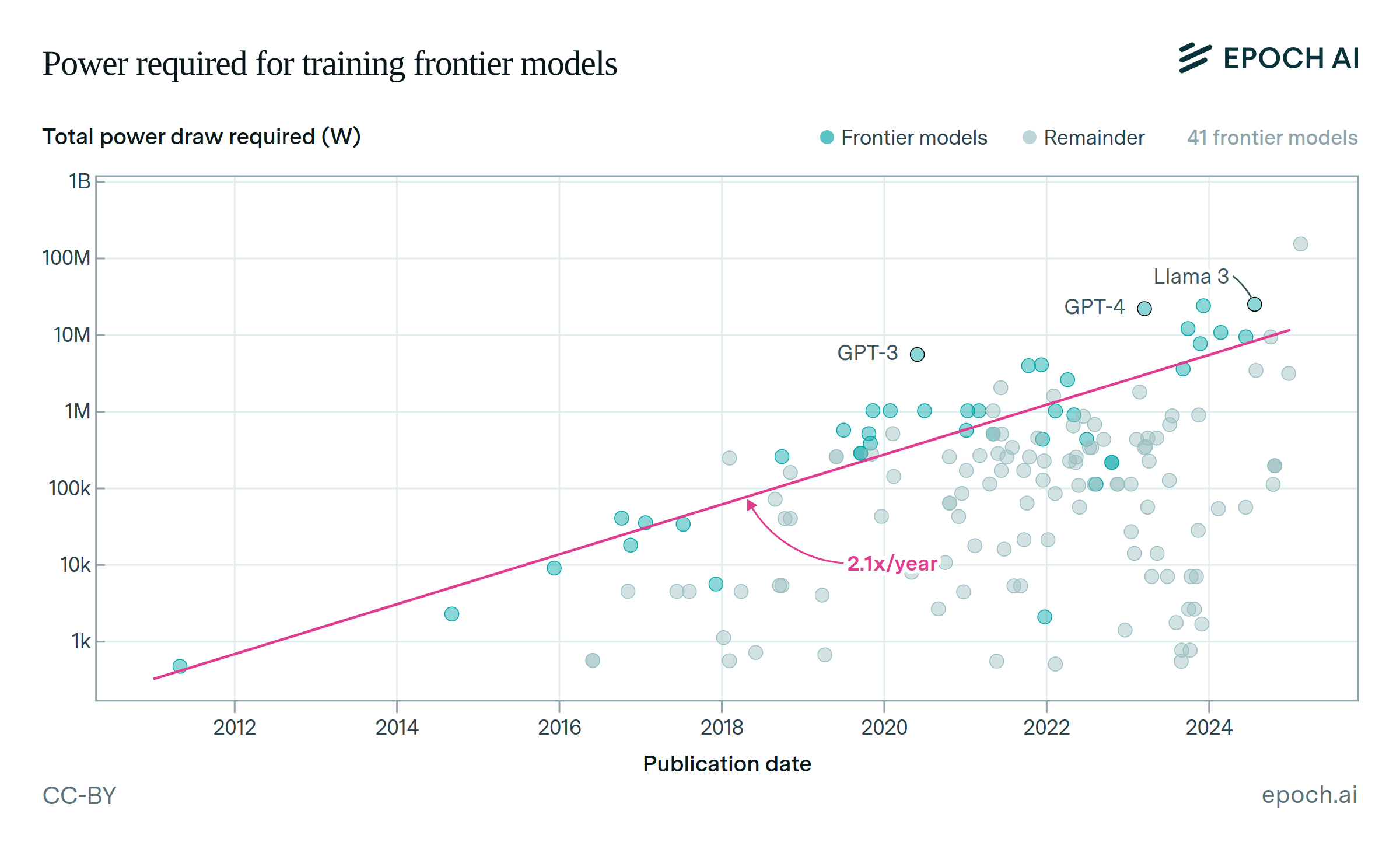
data insight
·
1 min read
The power required to train frontier AI models is doubling annually

report
·
10 min read
Interviewing AI researchers on automation of AI R&D
AI could speed up AI R&D, especially in coding and debugging. We explore predictions on automation and researchers' suggestions for AI R&D evaluations.
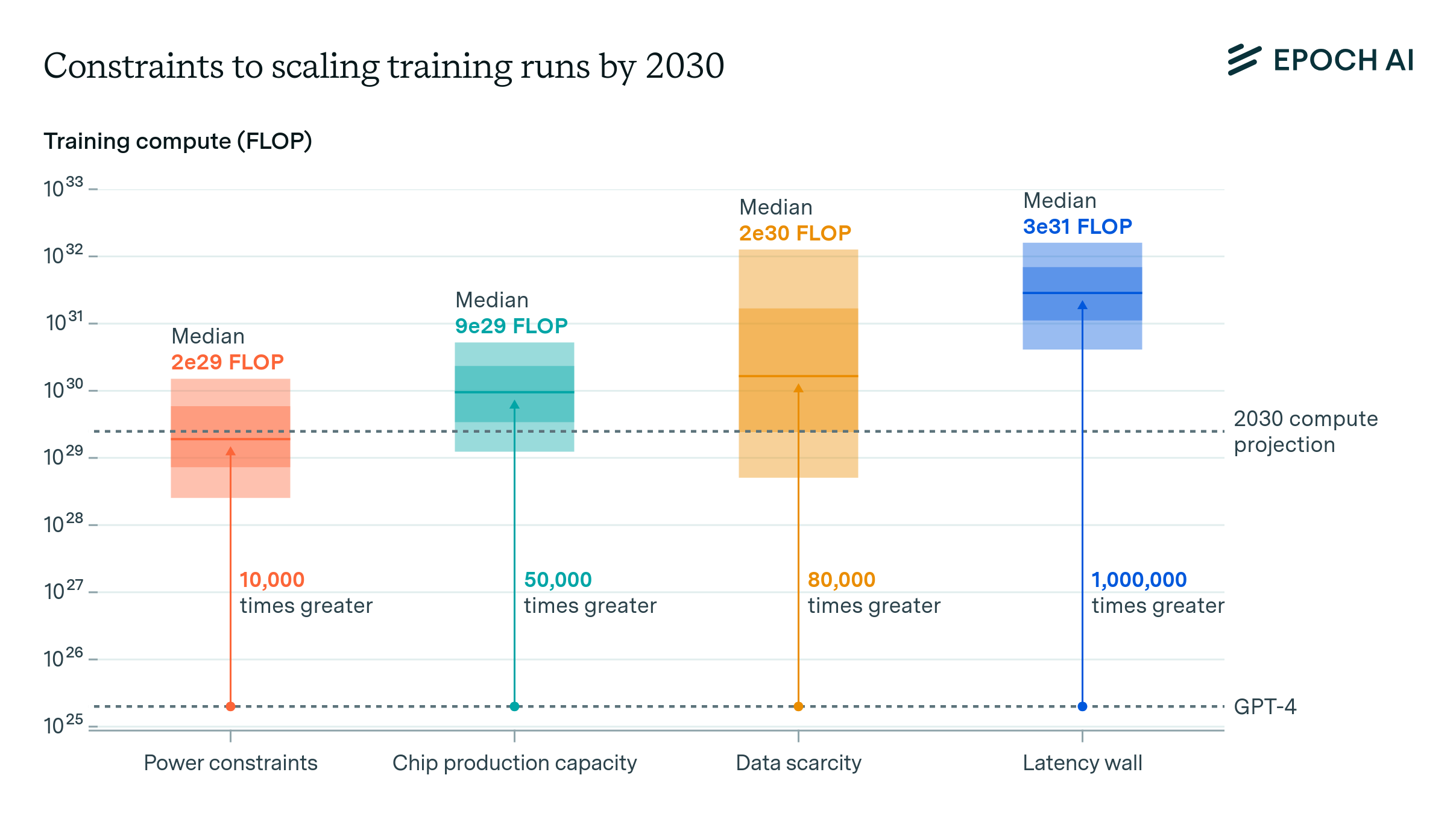
report
·
83 min read
Can AI scaling continue through 2030?
We investigate four constraints to scaling AI training: power, chip manufacturing, data, and latency. We predict 2e29 FLOP runs will be feasible by 2030.
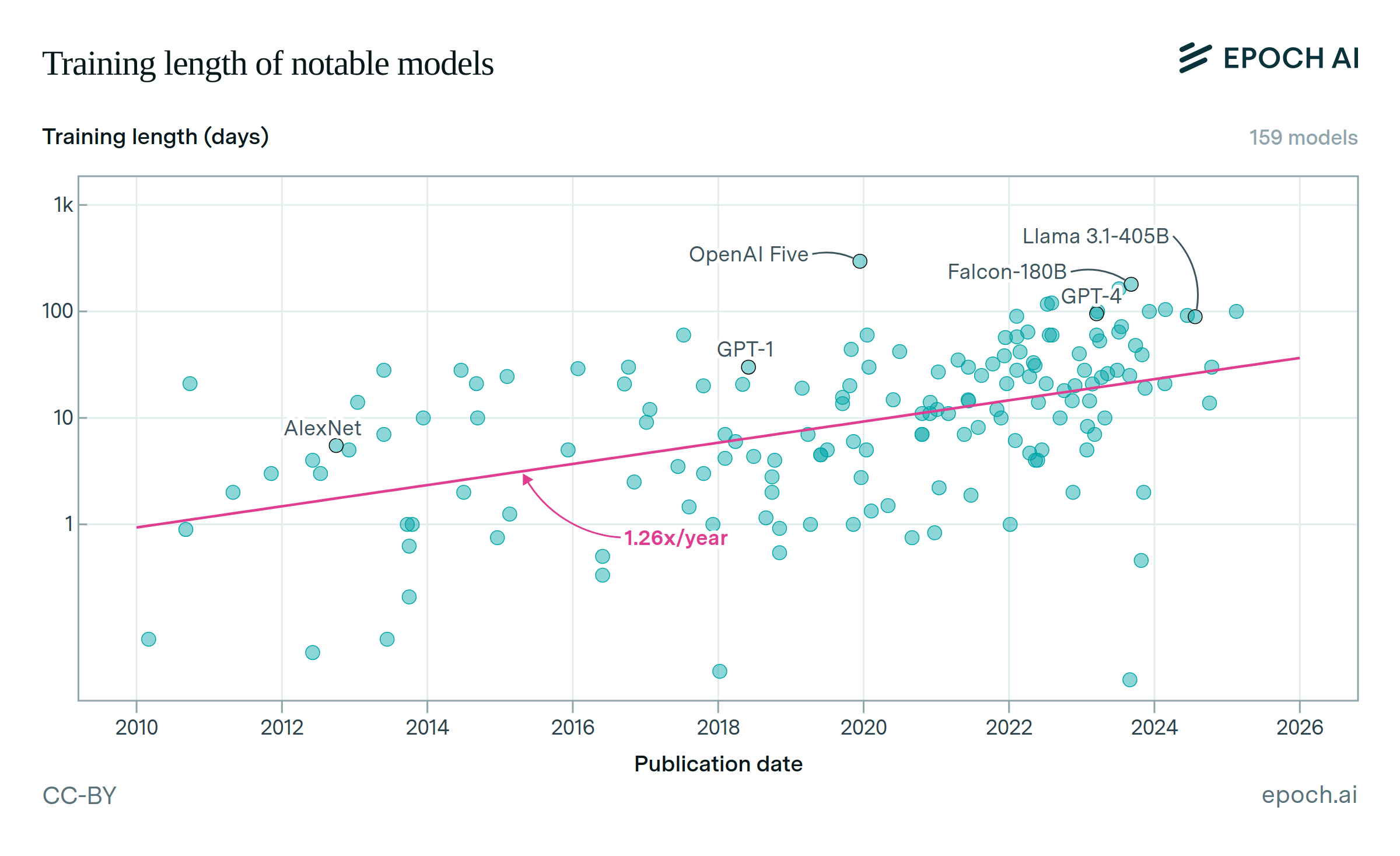
data insight
·
1 min read
The length of time spent training notable models is growing

data insight
·
1 min read
Language models compose the large majority of large-scale AI models
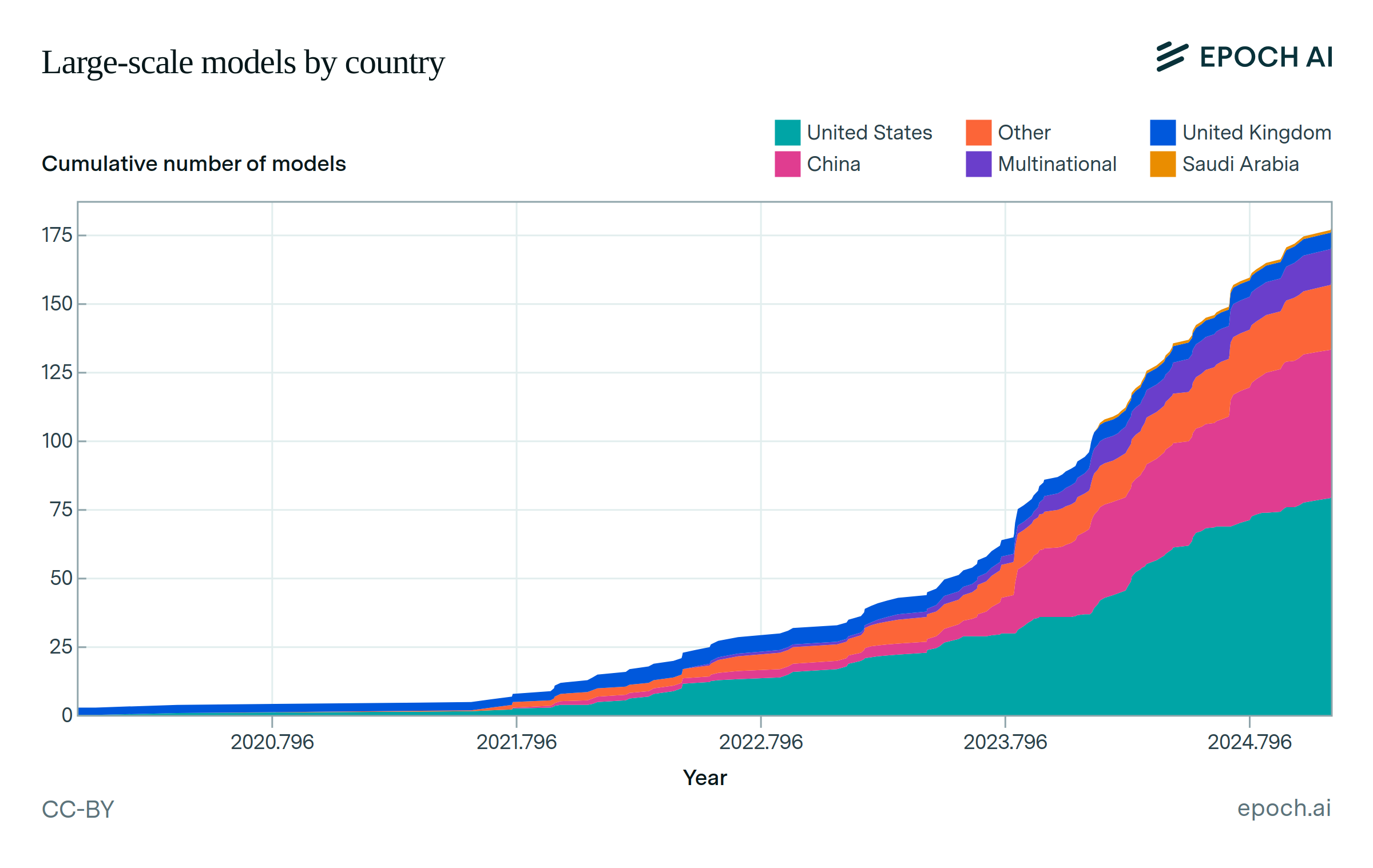
data insight
·
1 min read
Most large-scale models are developed by US companies
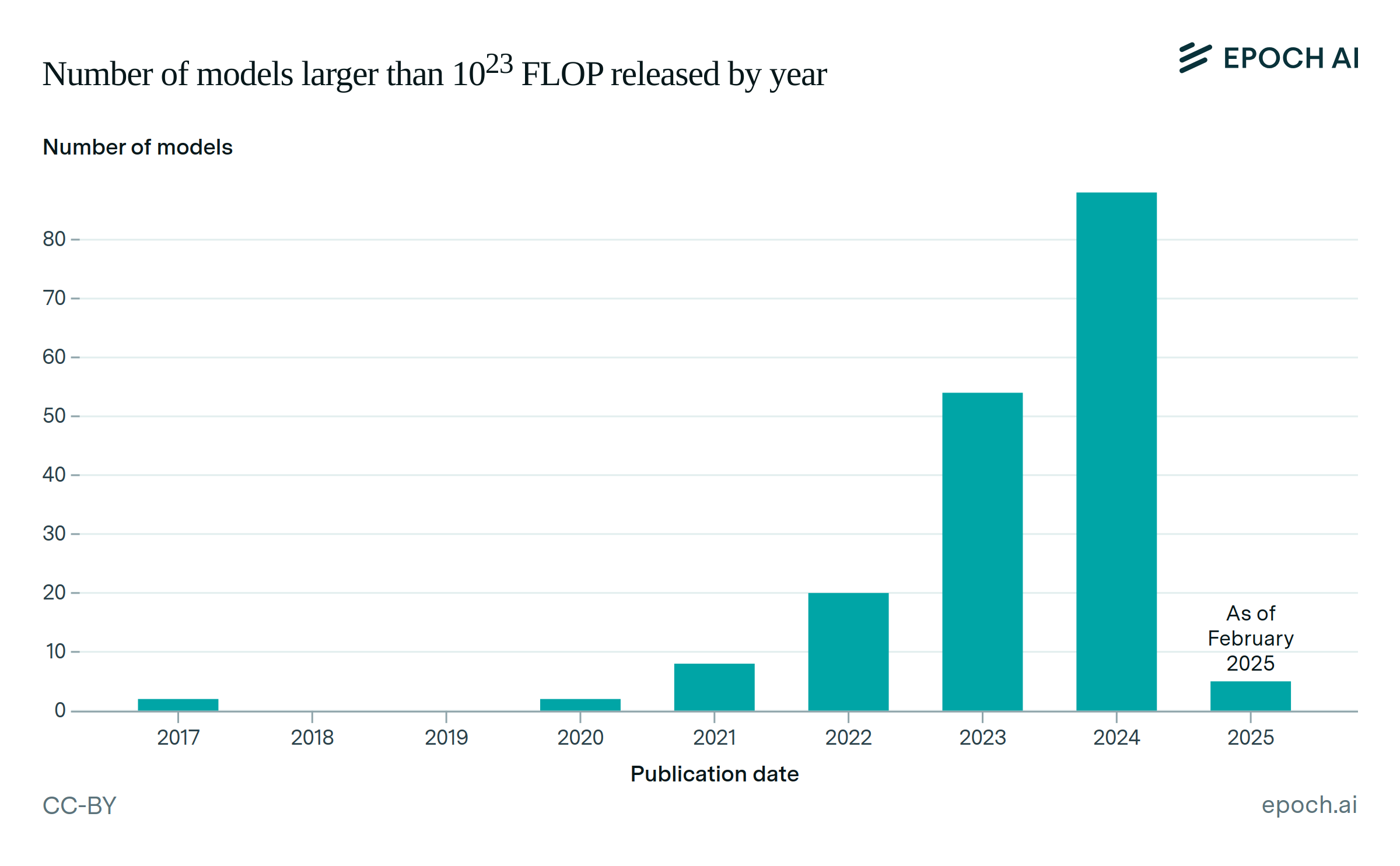
data insight
·
1 min read
The pace of large-scale model releases is accelerating
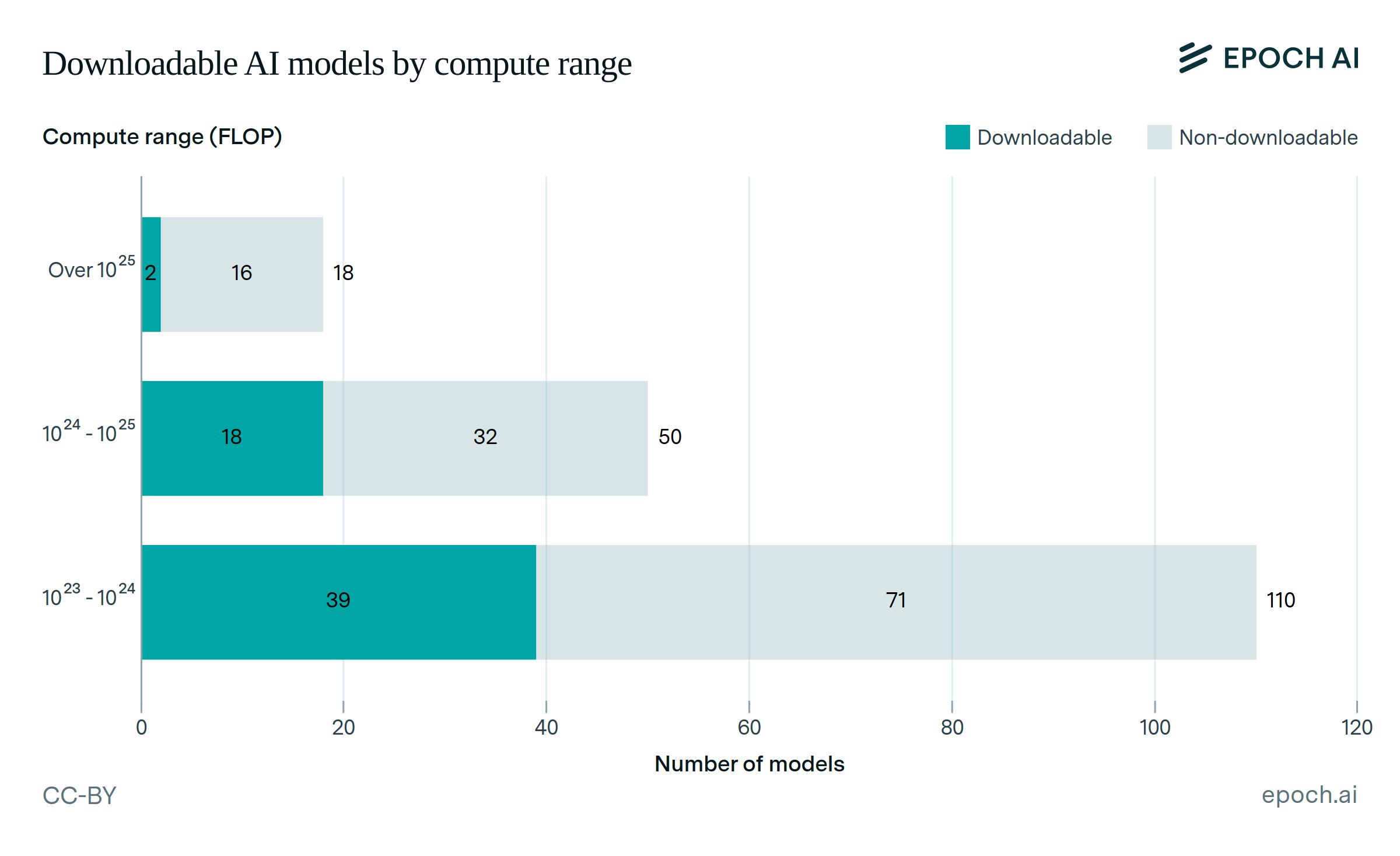
data insight
·
1 min read
Almost half of large-scale models have published, downloadable weights
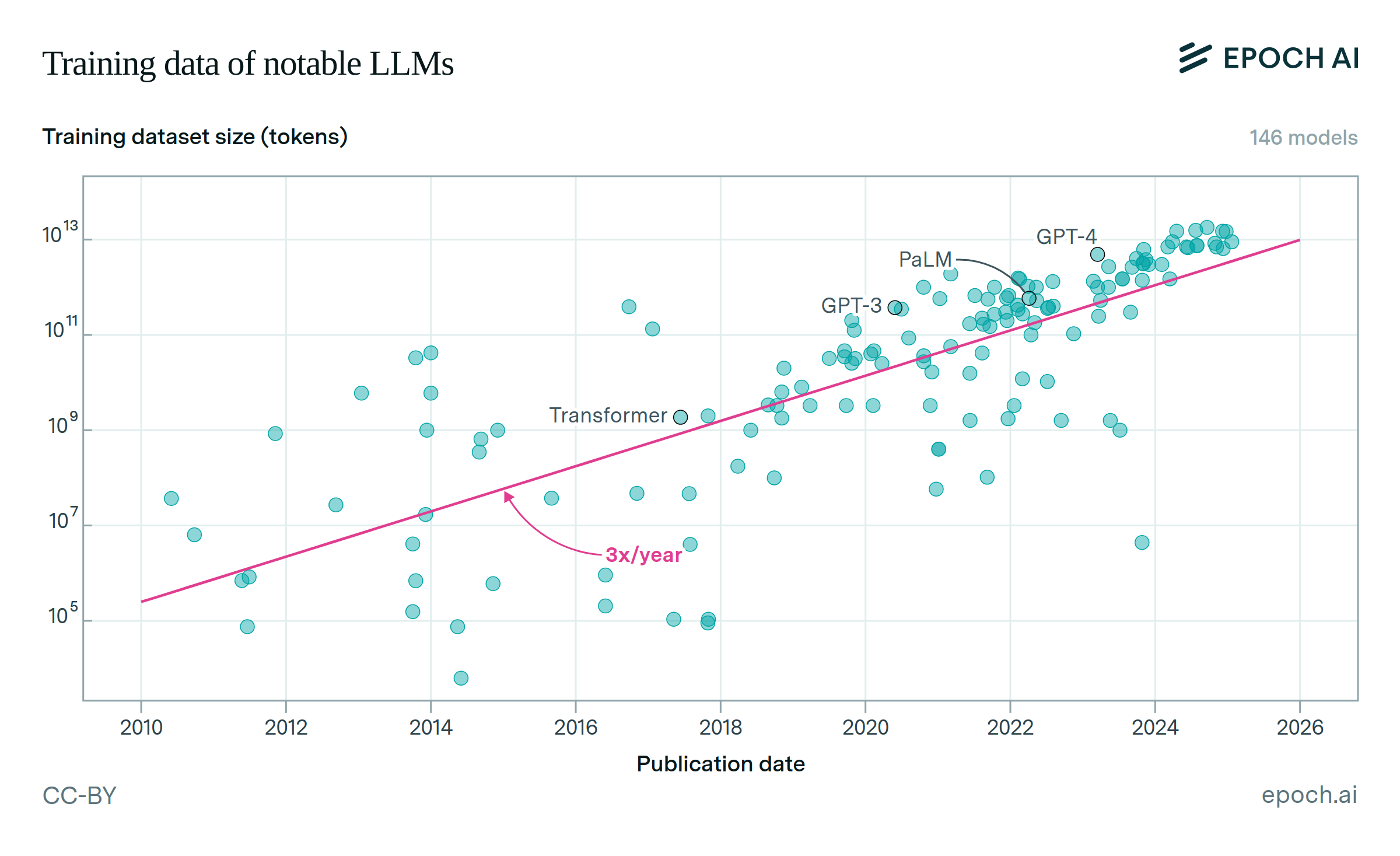
data insight
·
1 min read
The size of datasets used to train language models doubles approximately every six months
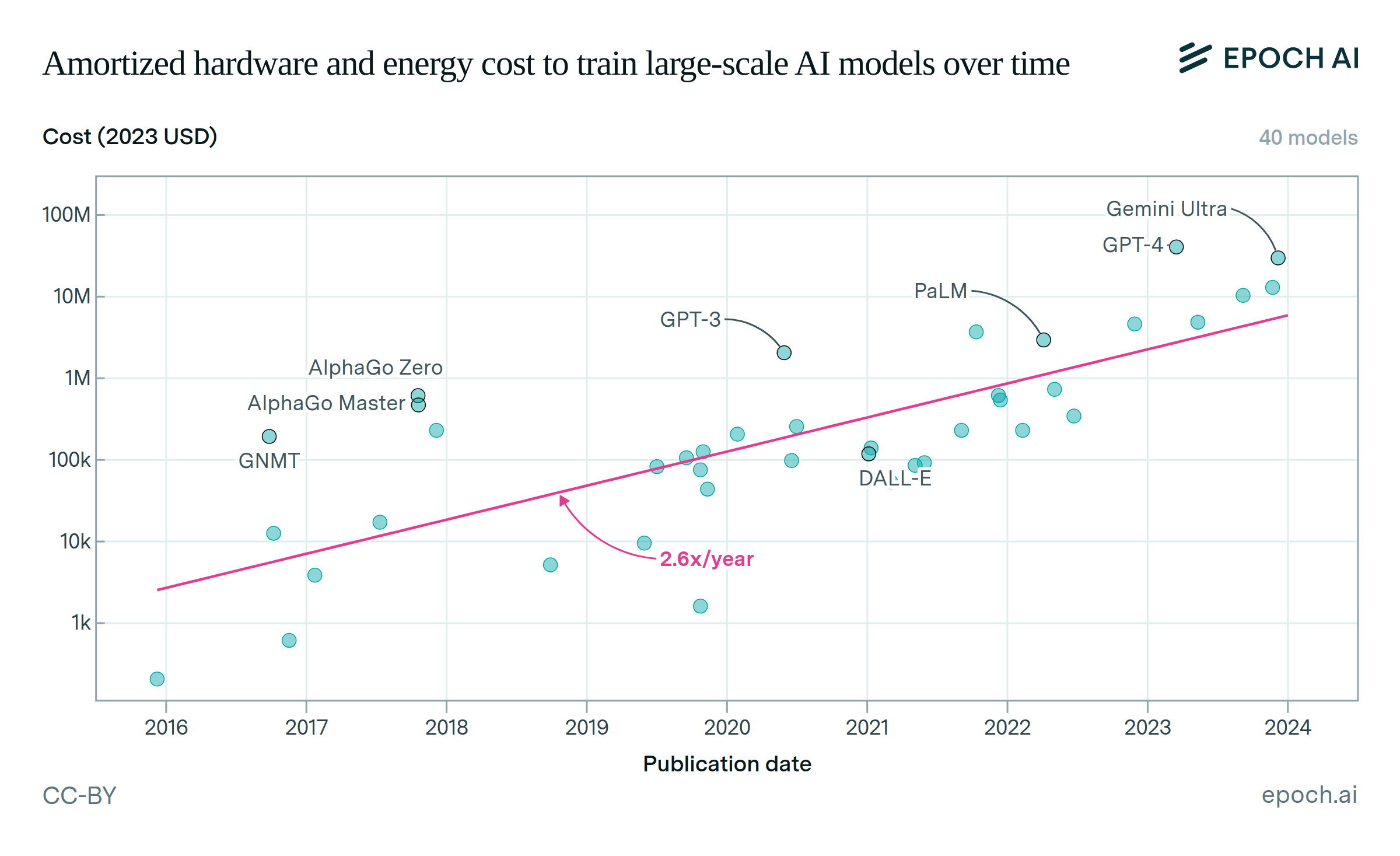
data insight
·
1 min read
Training compute costs are doubling every eight months for the largest AI models
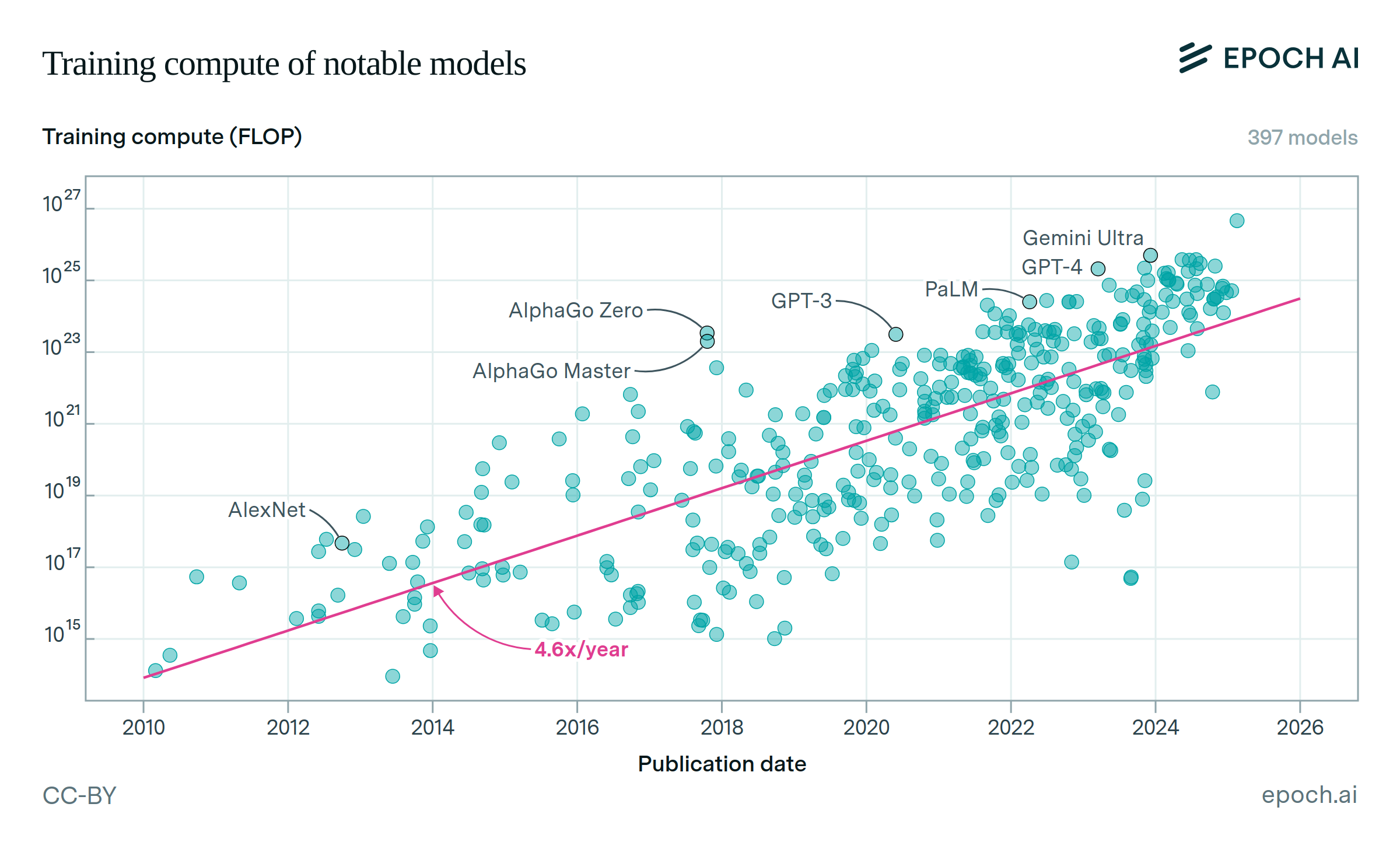
data insight
·
1 min read
The training compute of notable AI models has been doubling roughly every six months
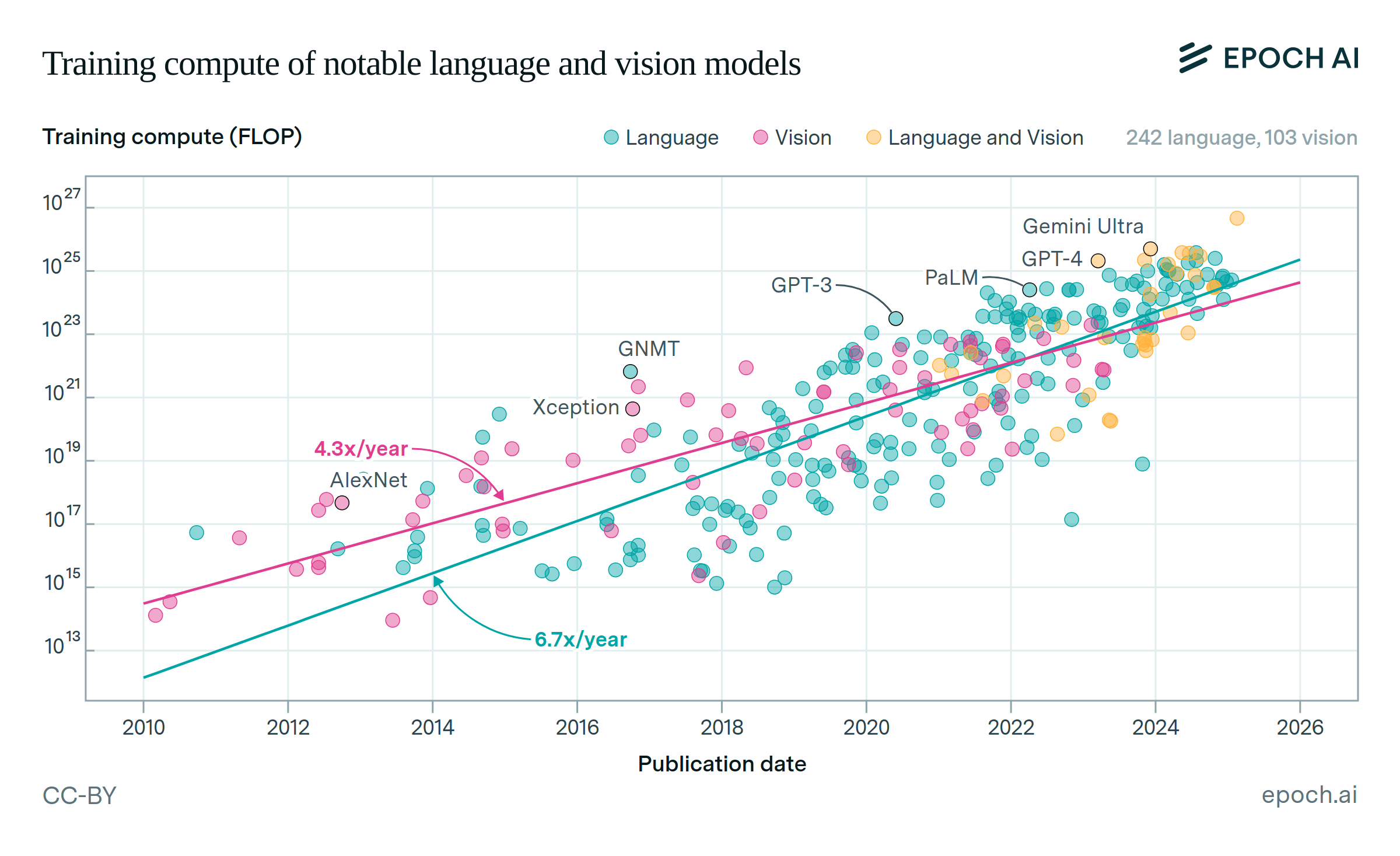
data insight
·
1 min read
Training compute has scaled up faster for language than vision
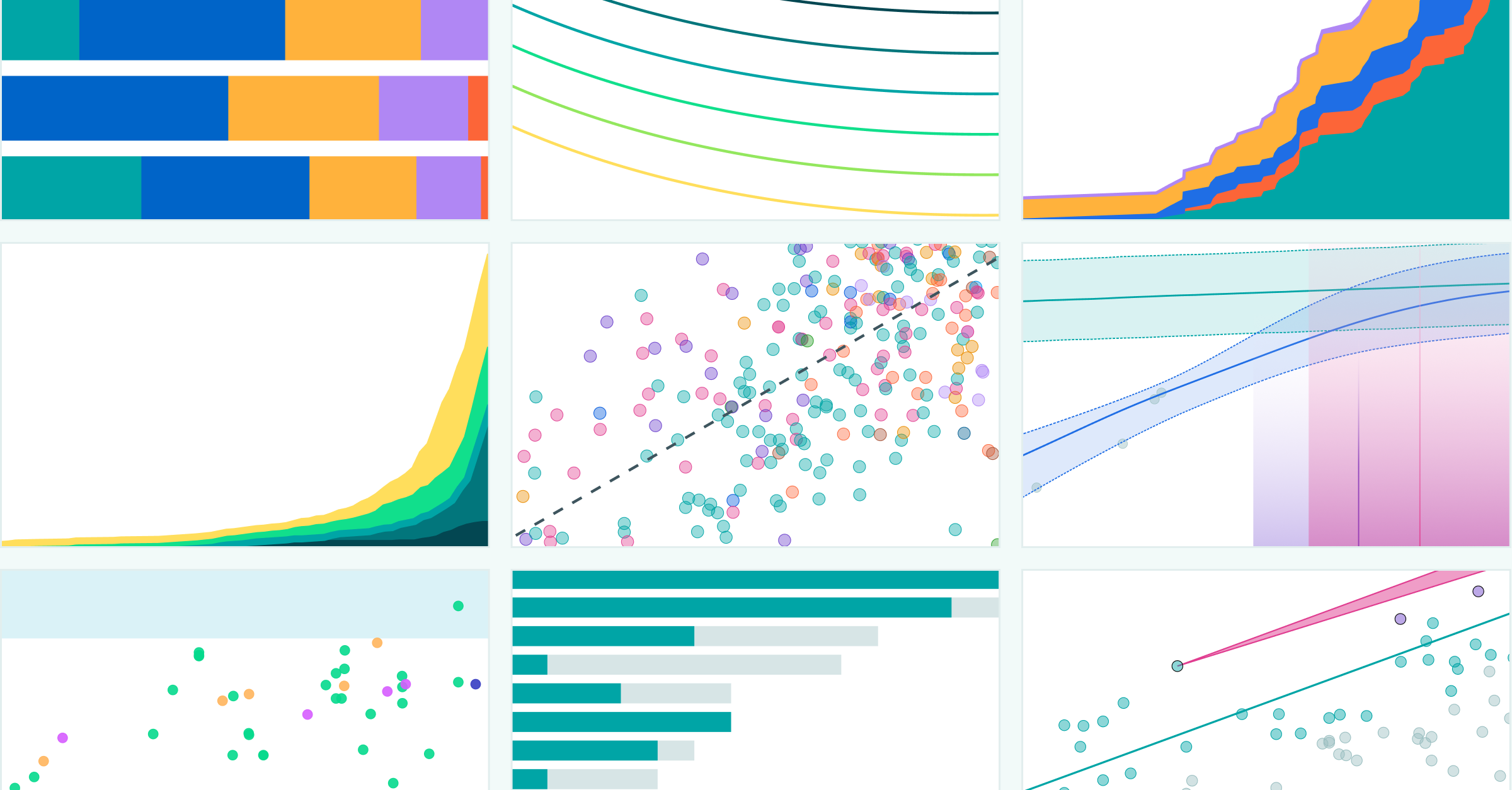
update
·
1 min read
Announcing Epoch AI’s data hub
We're launching a hub for data and visualizations, featuring our databases on notable and large-scale AI models for users and researchers.
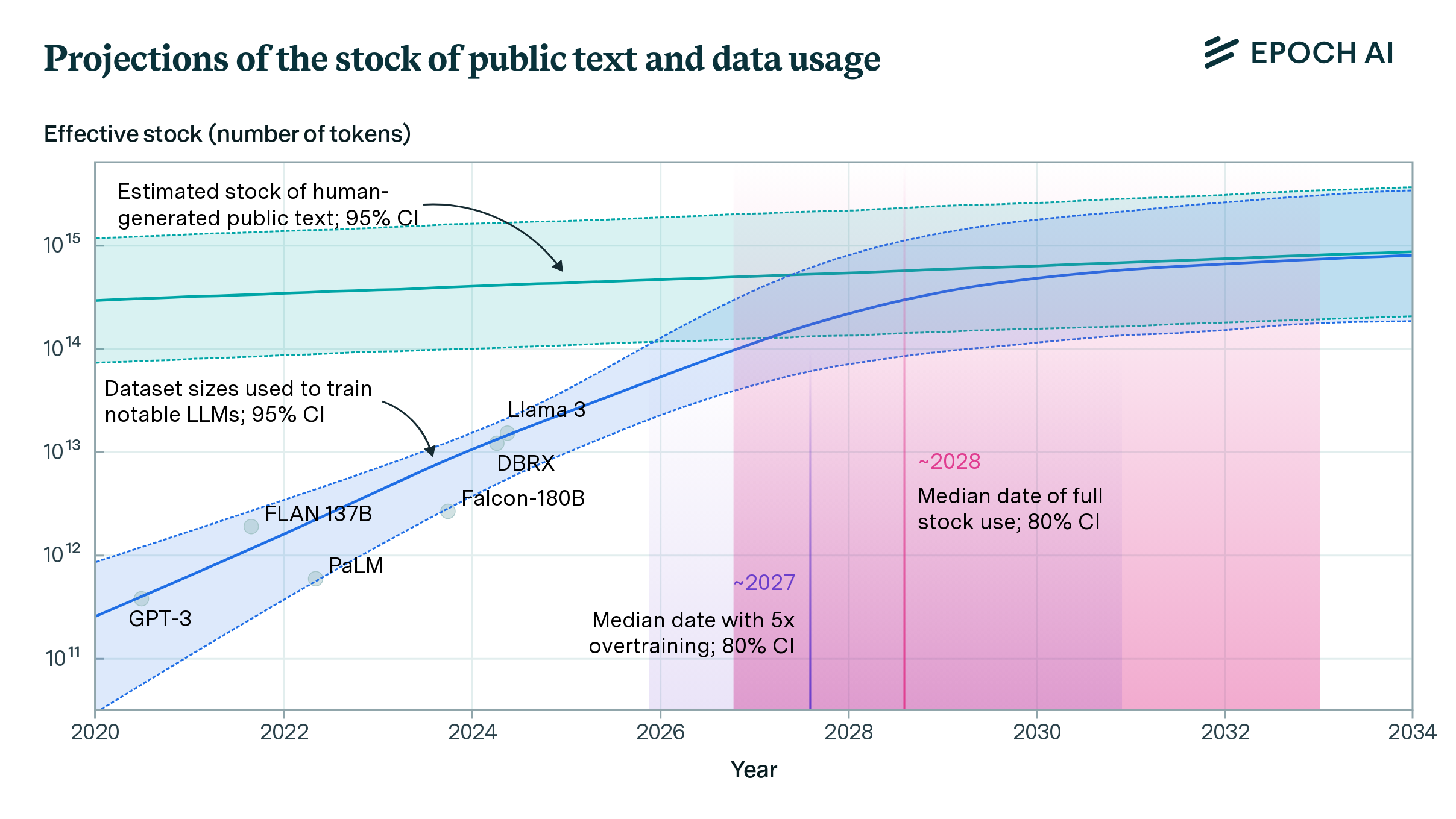
paper
·
6 min read
Will we run out of data? Limits of LLM scaling based on human-generated data
If trends continue, language models will fully utilize the stock of human-generated public text between 2026 and 2032.
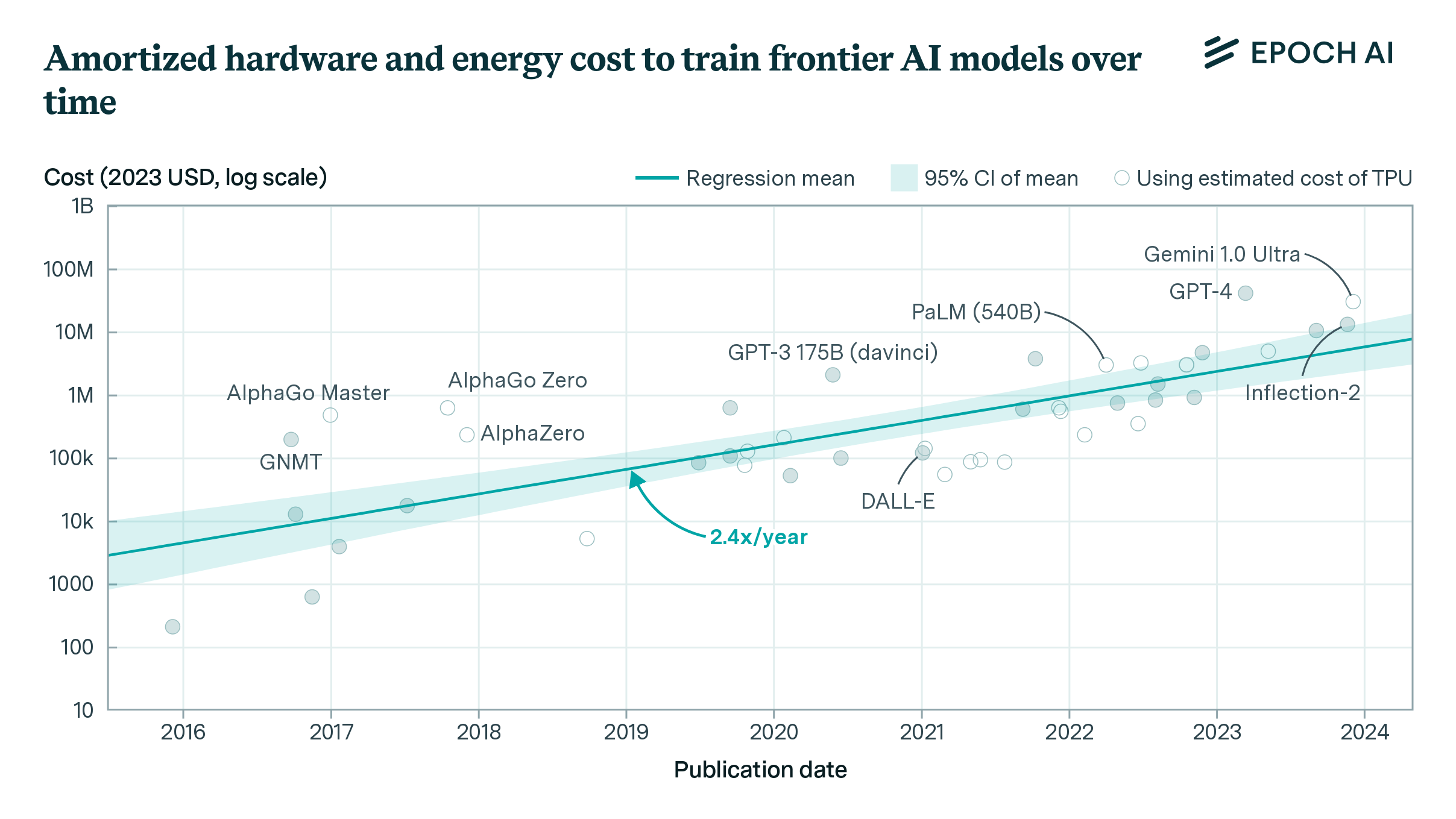
paper
·
4 min read
How much does it cost to train frontier AI models?
The cost of training top AI models has grown 2-3x annually for the past eight years. By 2027, the largest models could cost over a billion dollars.
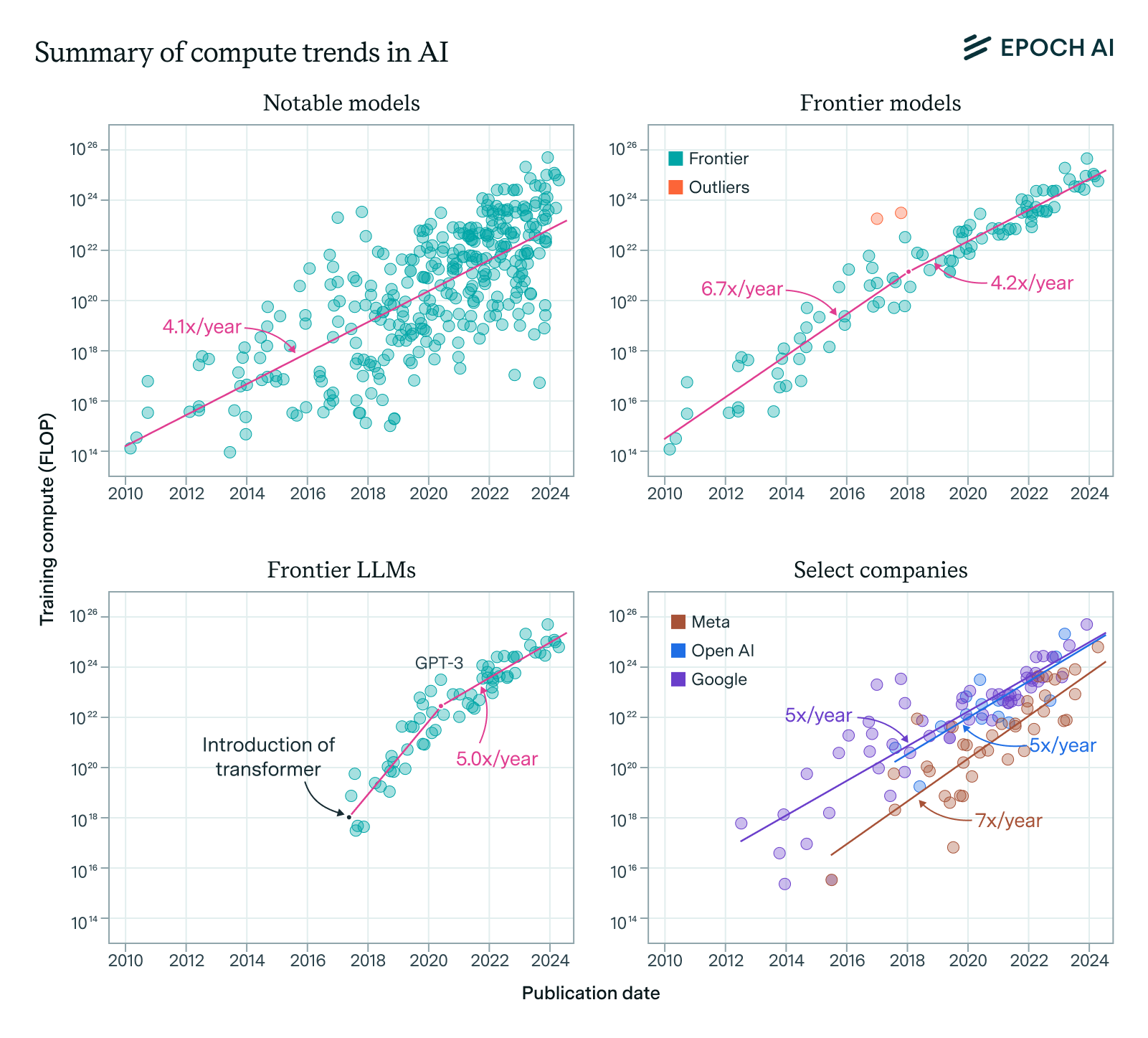
report
·
20 min read
Training compute of frontier AI models grows by 4-5x per year
Our expanded AI model database shows that training compute grew 4-5x/year from 2010 to 2024, with similar trends in frontier and large language models.
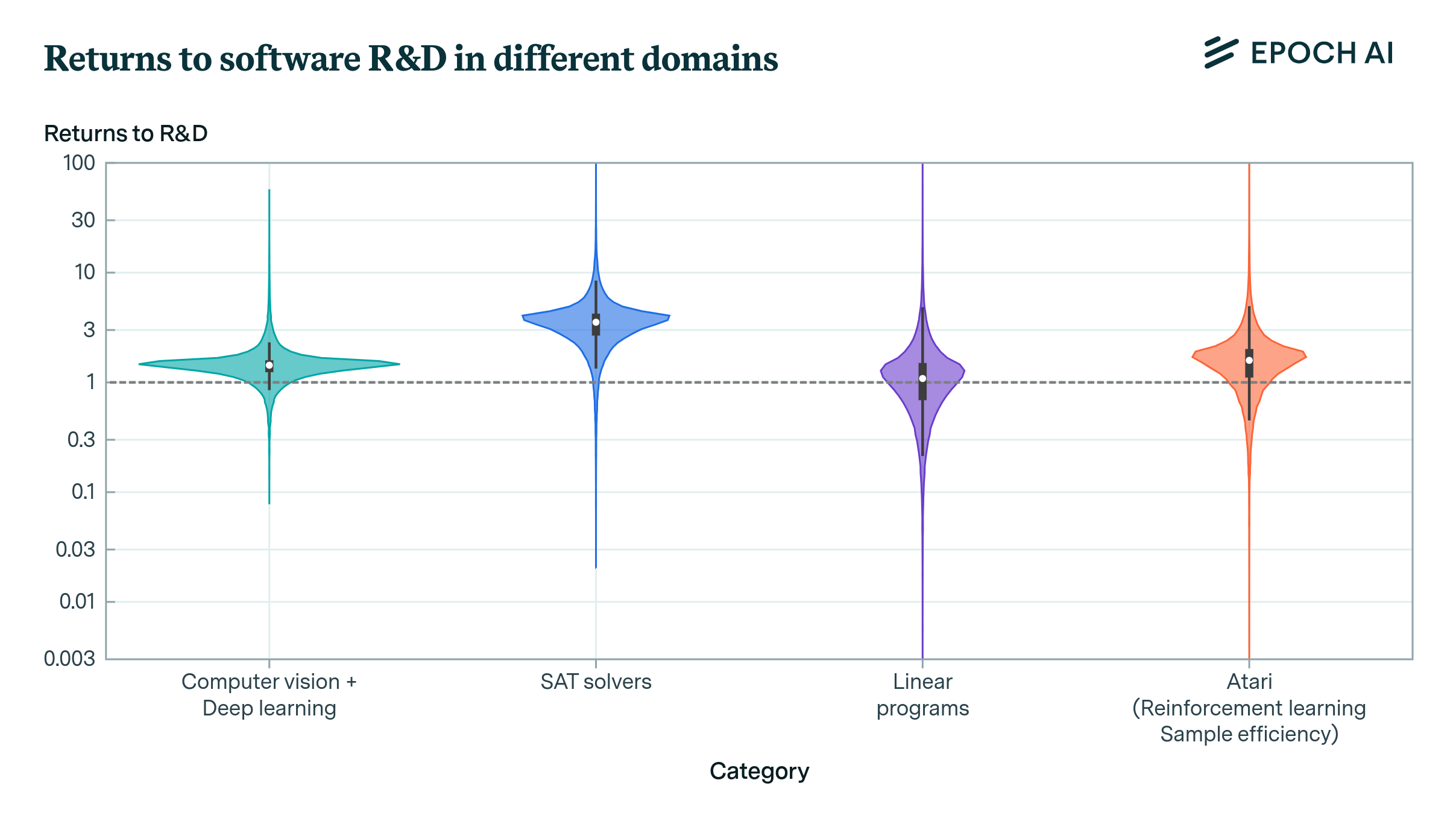
paper
·
10 min read
Do the returns to software R&D point towards a singularity?
Returns to R&D are key in growth dynamics and AI development. Our paper introduces new empirical techniques to estimate this vital parameter.

paper
·
4 min read
Chinchilla scaling: A replication attempt
We replicate Hoffmann et al.’s parametric scaling law estimates, finding issues and providing better-fitting estimates that align with their other methods.
report
·
16 min read
Tracking large-scale AI models
We present a dataset of 81 large-scale models, from AlphaGo to Gemini, developed across 18 countries, at the leading edge of scale and capabilities.
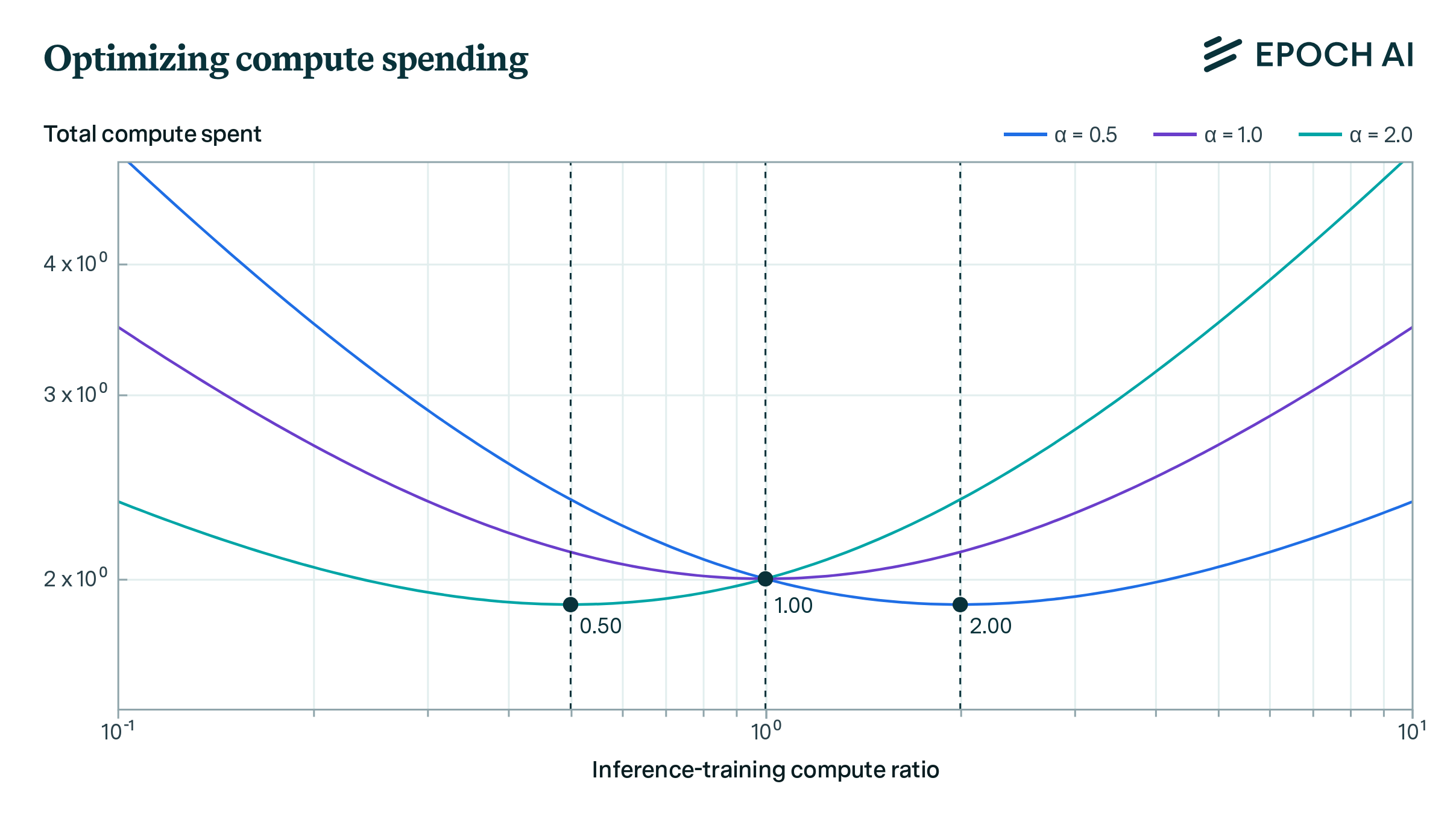
report
·
9 min read
Optimally allocating compute between inference and training
AI labs should spend comparable resources on training and inference, assuming they can flexibly balance compute between the two to maintain performance.

paper
·
3 min read
Algorithmic progress in language models
Progress in pretrained language model performance outpaces expectations, occurring at a pace equivalent to doubling computational power every 5 to 14 months.

update
·
10 min read
2023 impact report
In 2023, Epoch published nearly 20 reports on AI, added hundreds of models to our database, helped with government policies, and raised over $7 million.
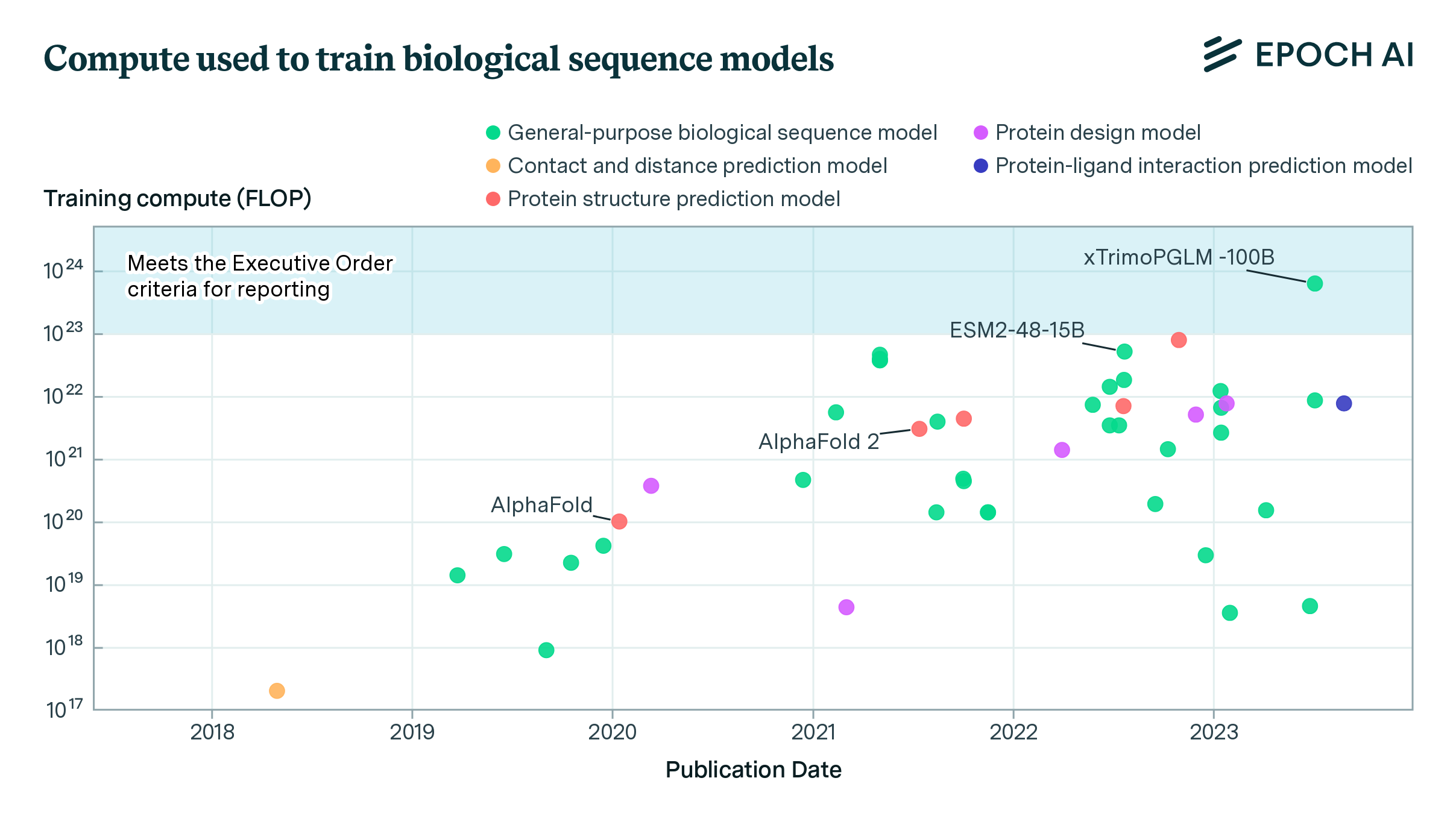
report
·
23 min read
Biological sequence models in the context of the AI directives
Our expanded database now includes biological sequence models, highlighting potential regulatory gaps and the growth of training compute in these models.

paper
·
3 min read
How predictable is language model benchmark performance?
We investigate large language model performance, finding that compute-focused extrapolations are a promising way to forecast AI capabilities.

paper
·
4 min read
Limits to the energy efficiency of CMOS microprocessors
How far can the energy efficiency of CMOS microprocessors be pushed before hitting physical limits? We find room for a further 50 to 1000x improvement.
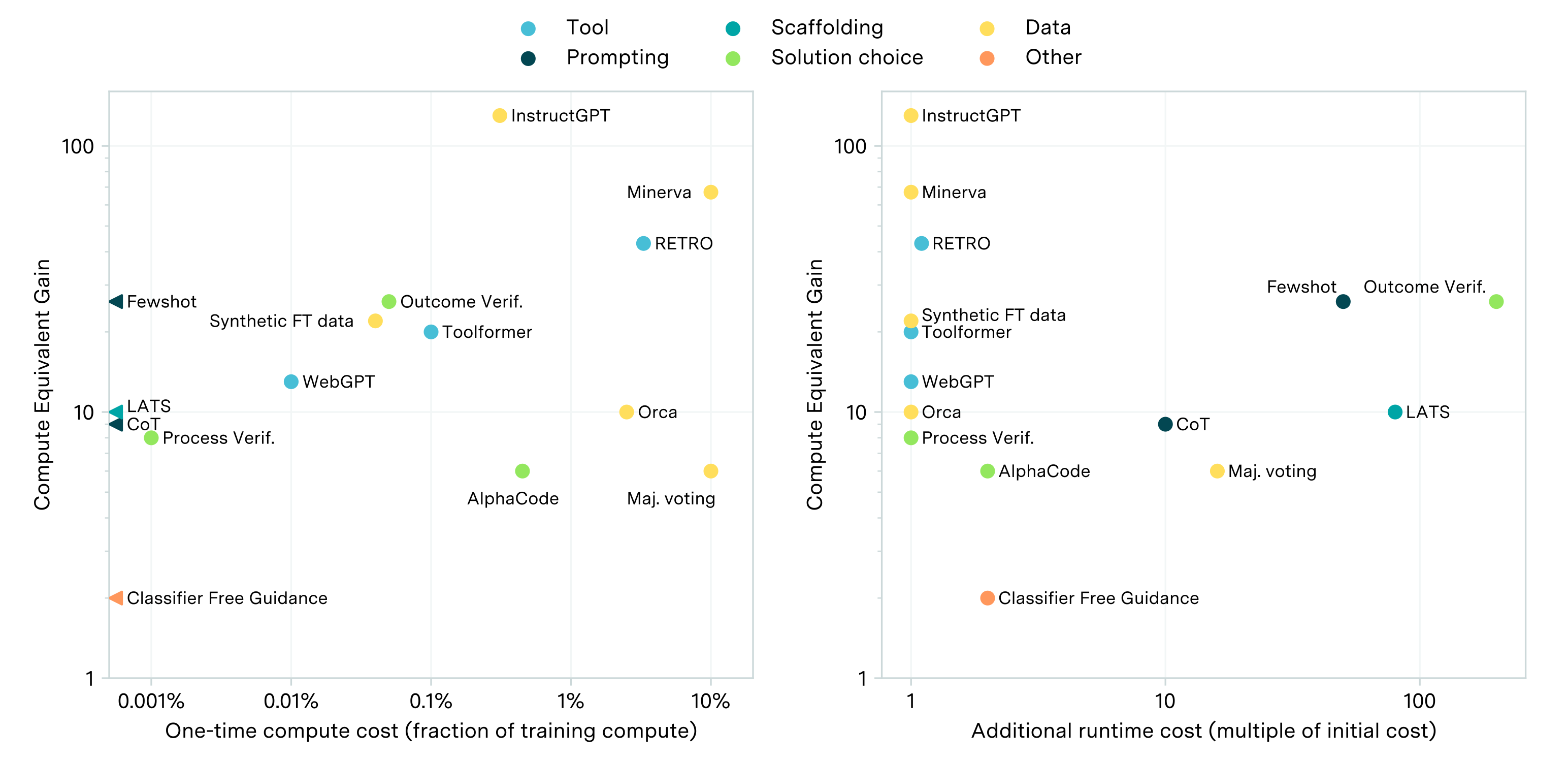
paper
·
2 min read
AI capabilities can be significantly improved without expensive retraining
While scaling compute is key to improving LLMs, post-training enhancements can offer gains equivalent to 5-20x more compute at less than 1% of the cost.

paper
·
3 min read
Who is leading in AI? An analysis of industry AI research
Industry has emerged as a driving force in AI. We compare top companies on research impact, training runs, and contributions to algorithmic innovations.
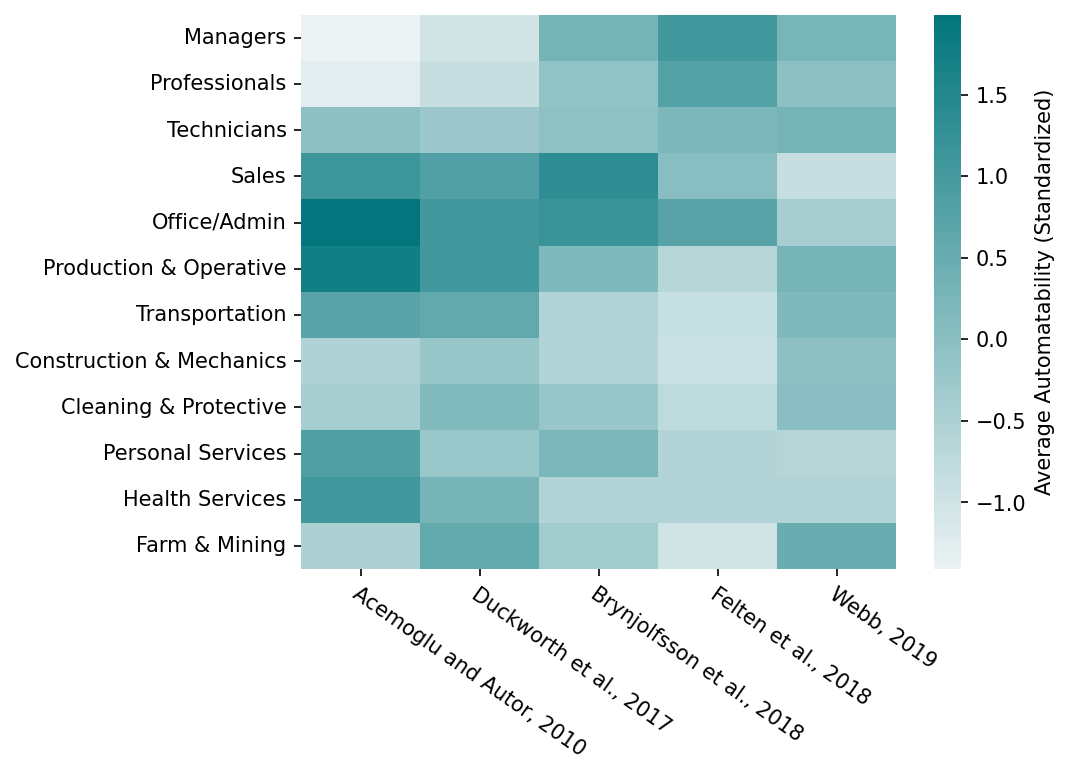
report
·
31 min read
Challenges in predicting AI automation
Economists propose various approaches to predicting AI's automation of valuable tasks, but disagreements persist, with no consensus on the best method.

report
·
27 min read
Trends in machine learning hardware
FLOP/s performance in 47 ML hardware accelerators doubled every 2.3 years. Switching from FP32 to tensor-FP16 led to a further 10x performance increase.

update
·
1 min read
Announcing Epoch AI's updated parameter, compute and data trends database
Our database now spans over 700 ML systems, tracking parameters, datasets, and training compute details for notable machine learning models.
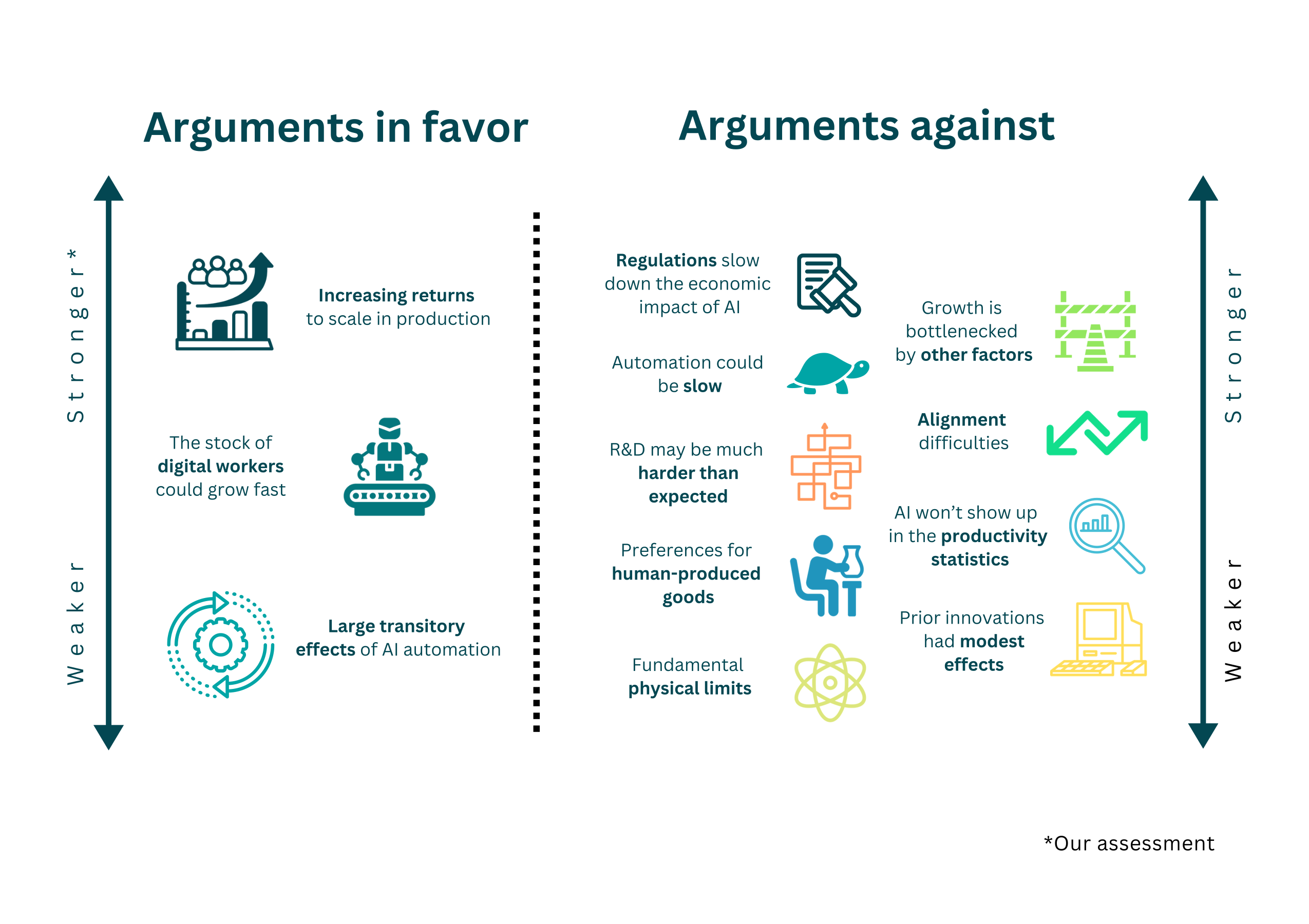
paper
·
11 min read
Explosive growth from AI: A review of the arguments
Our new article explores whether deployment of advanced AI systems could lead to growth rates ten times higher than those of today’s frontier economies.
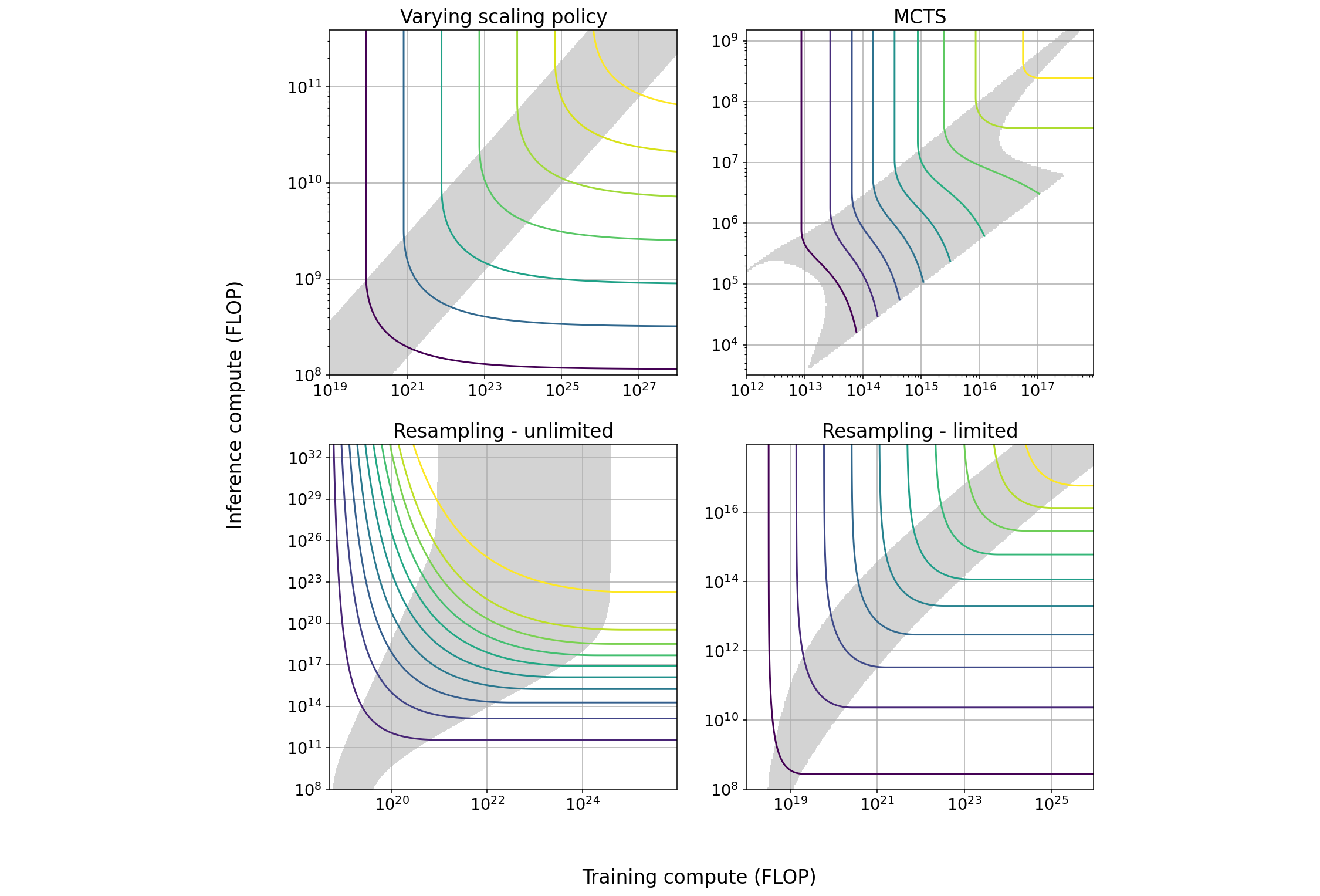
report
·
27 min read
Trading off compute in training and inference
We characterize techniques that induce a tradeoff between spending resources on training and inference, outlining their implications for AI governance.
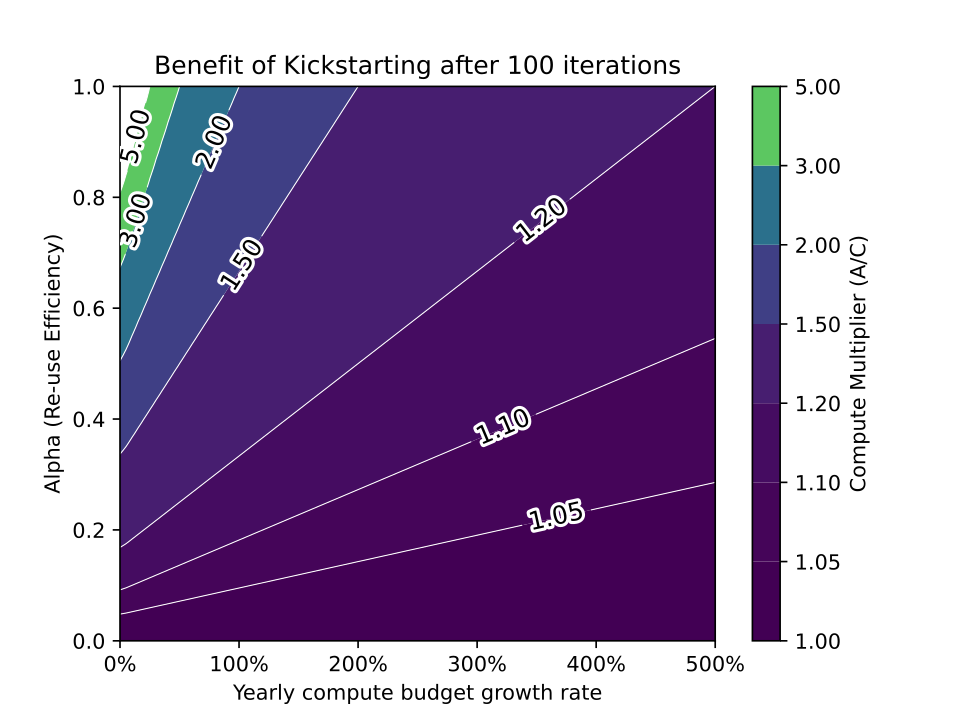
report
·
10 min read
The limited benefit of recycling foundation models
Reusing pretrained models can save on training costs, but it's unlikely to significantly boost AI capabilities beyond modest improvements.

update
·
3 min read
Epoch AI and FRI mentorship program summer 2023
We’re launching the Epoch and FRI mentorship program for women, non-binary, and transgender people interested in AI forecasting.
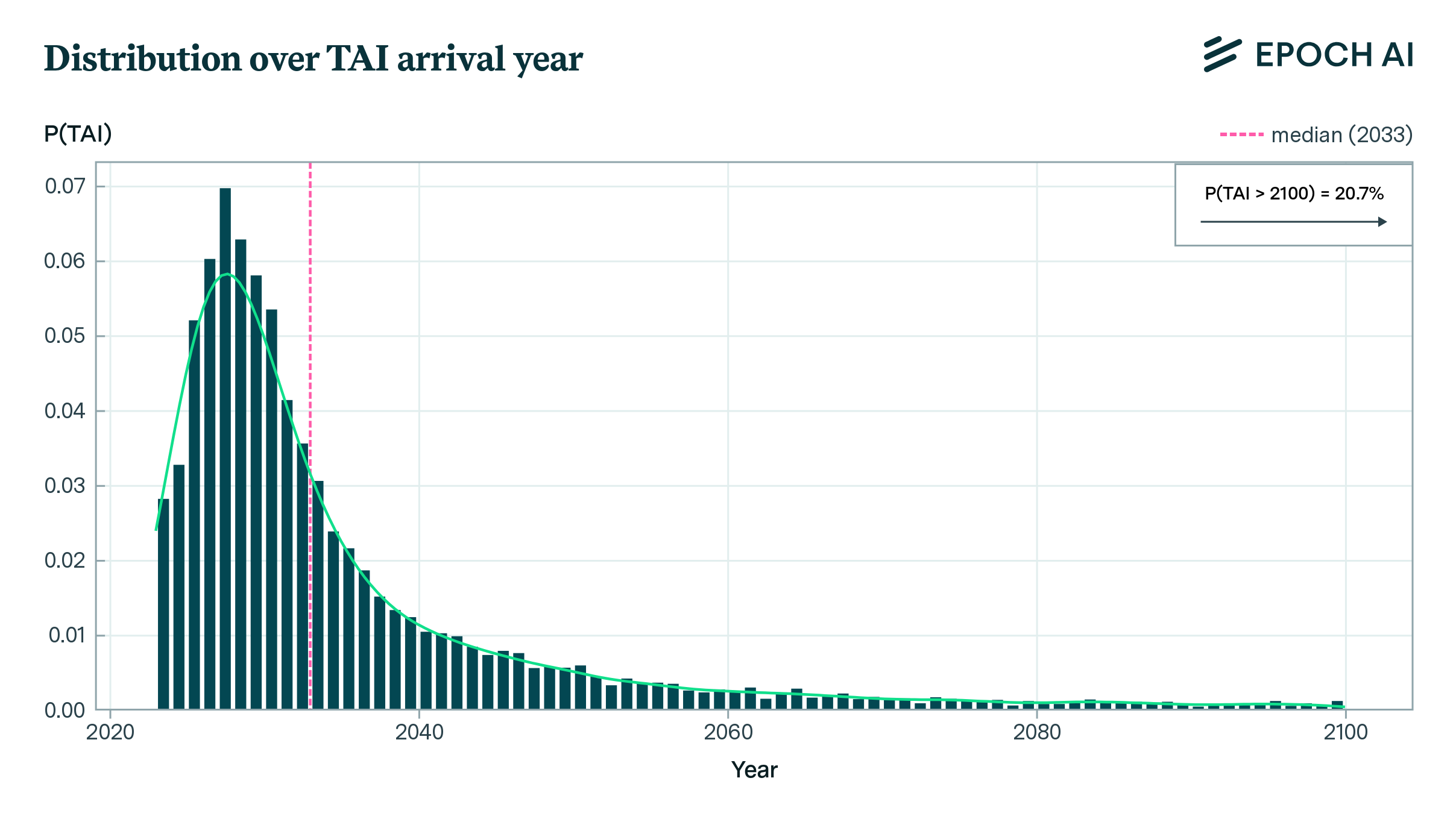
report
·
14 min read
Direct Approach interactive model
When could transformative AI be achieved? We present a simple, user-adjustable model of key inputs that forecasts the date TAI could be deployed.
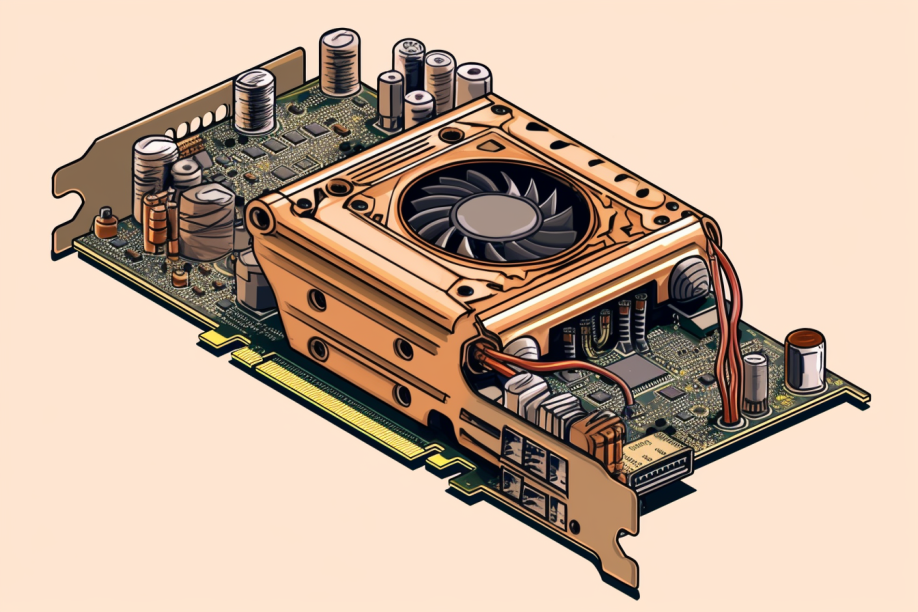
viewpoint
·
26 min read
A compute-based framework for thinking about the future of AI
AI’s potential to automate labor could alter the course of human history. The availability of compute is the most important factor driving progress in AI.

viewpoint
·
1 min read
Please report your compute
Compute is essential for AI performance, yet often underreported. Adopting reporting norms would improve research, forecasts, and policy decisions.
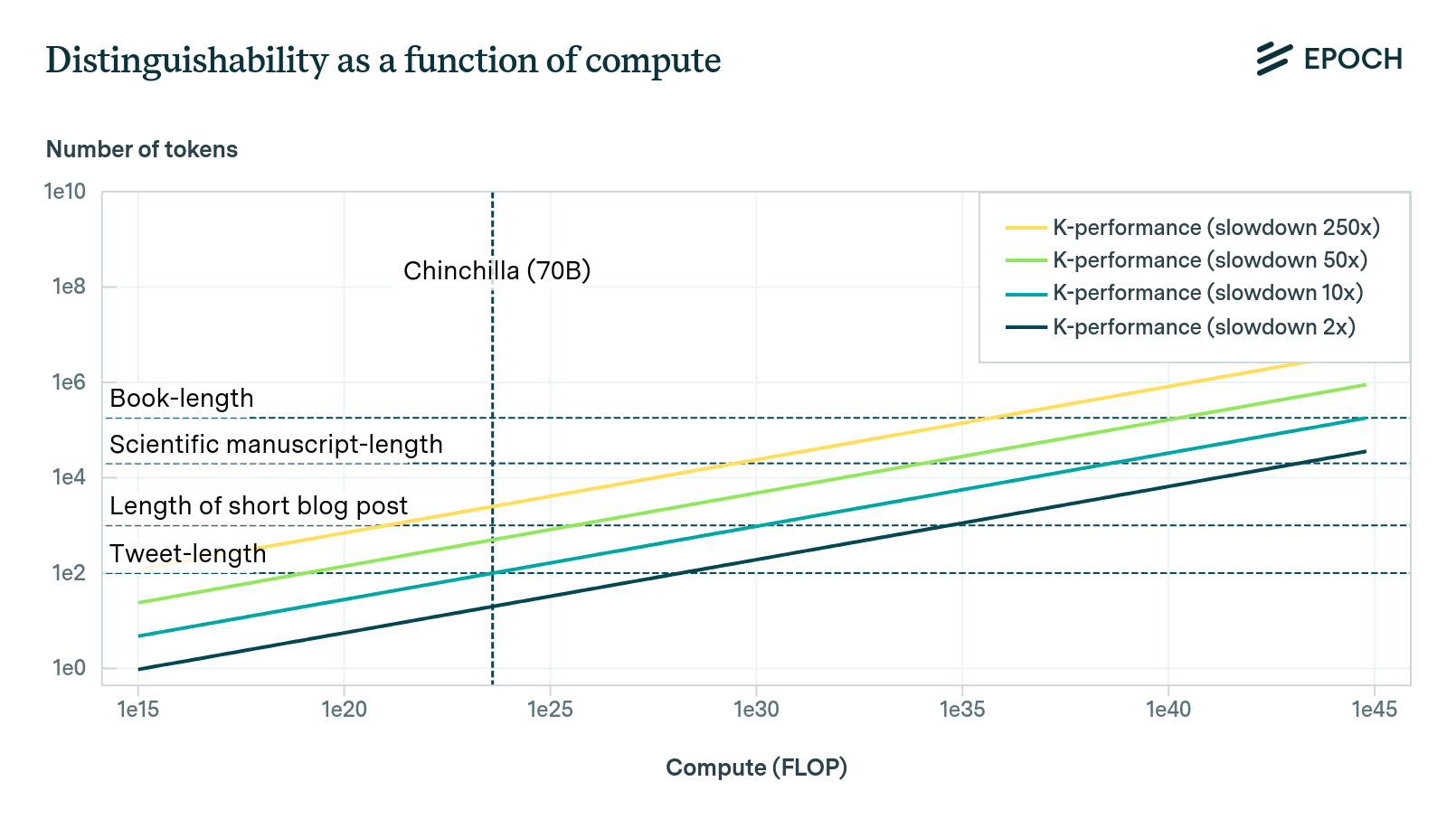
report
·
10 min read
The Direct Approach
We propose a method using neural scaling laws to estimate the compute needed to train AI models to reach human-level performance on various tasks.
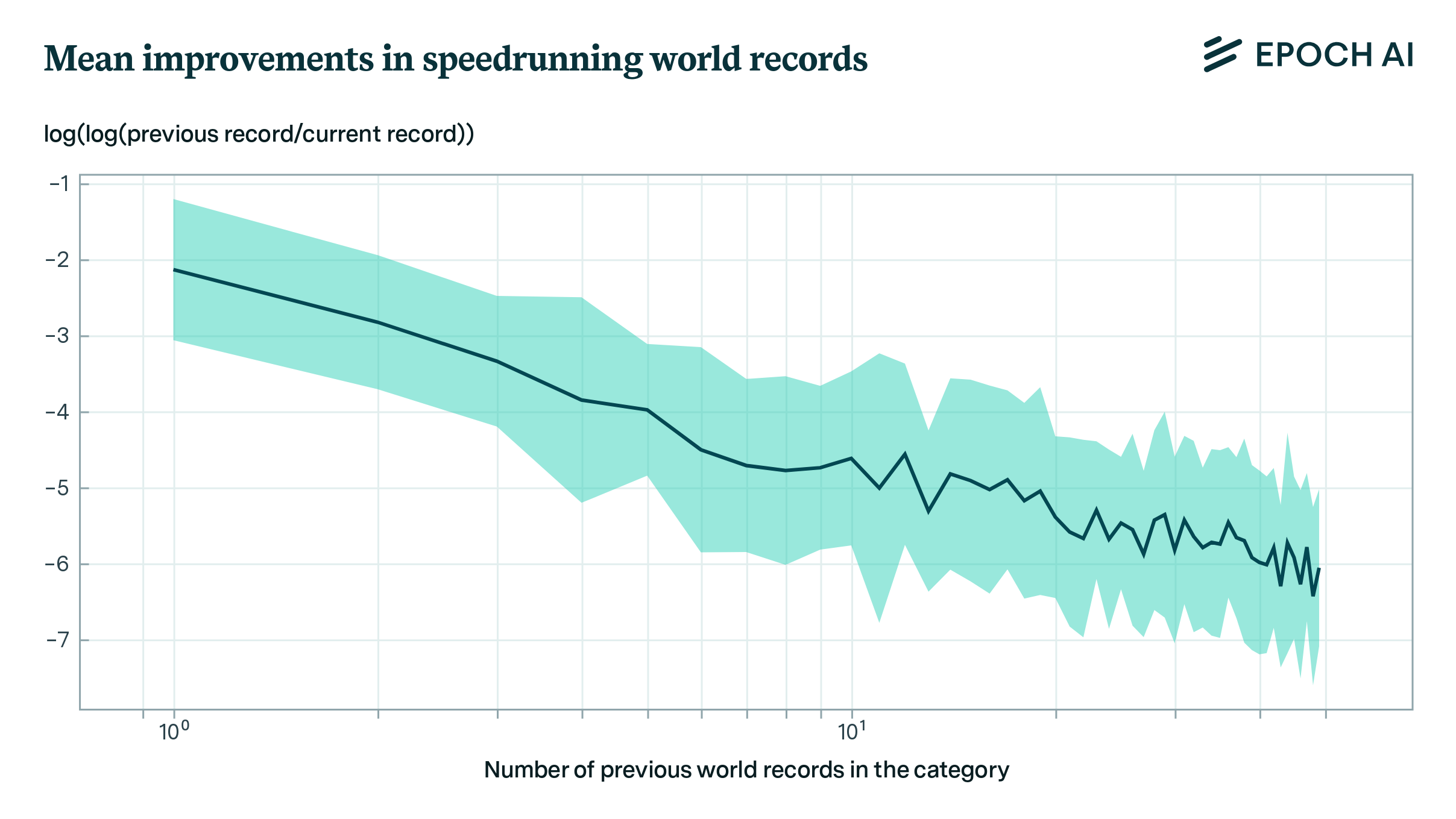
paper
·
2 min read
Power laws in speedrunning and machine learning
Our model suggests ML benchmarks aren’t near saturation. While large improvements are rare, we find 1OOM gains happen roughly once in every 50 instances.

update
·
1 min read
Announcing Epoch AI’s dashboard of key trends and figures in machine learning
Our dashboard provides key data from our research on machine learning and is a valuable resource for understanding the present and future of the field.

update
·
1 min read
2022 impact report
Our impact report for 2022.
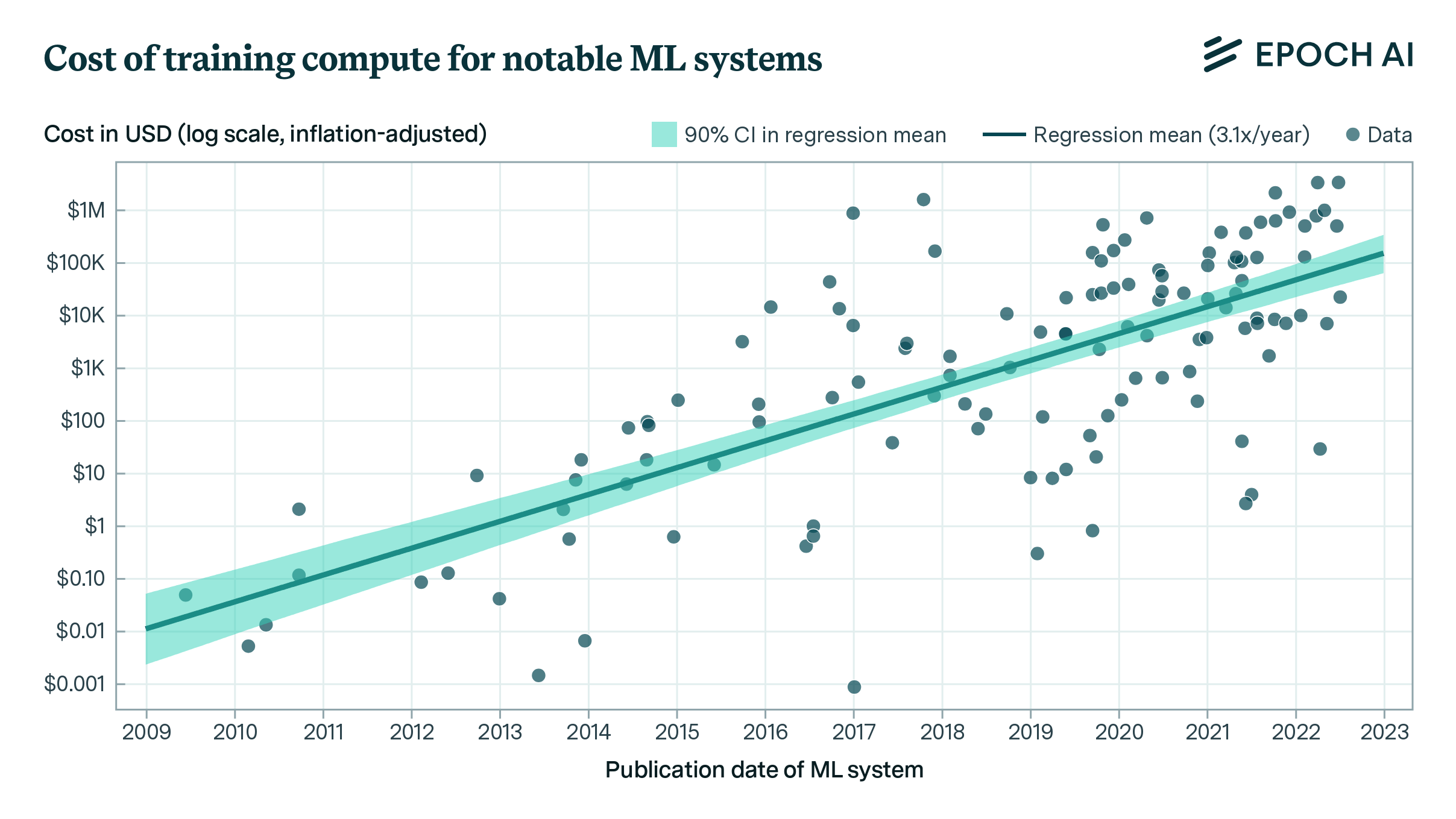
report
·
66 min read
Trends in the dollar training cost of machine learning systems
How much does it cost to train AI models? Looking at 124 ML systems from between 2009 and 2022, we find the cost has grown by approximately 0.5OOM/year.
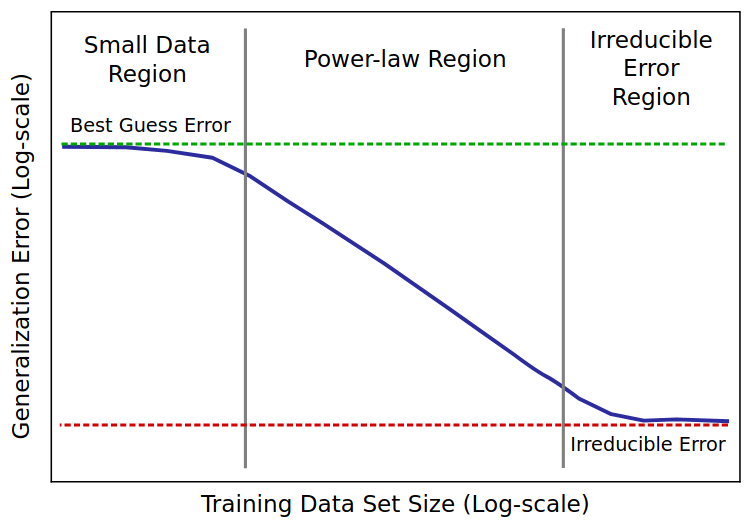
report
·
6 min read
Scaling laws literature review
I have collected a database of scaling laws for different tasks and architectures, and reviewed dozens of papers in the scaling law literature.
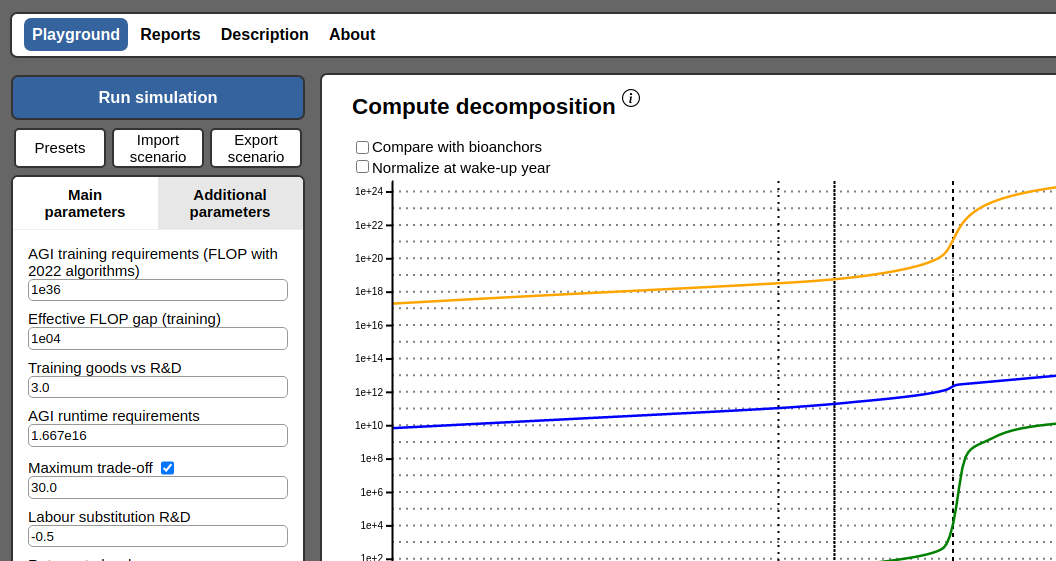
update
·
1 min read
An interactive model of AI takeoff speeds
We have developed an interactive website showcasing a new model of AI takeoff speeds.
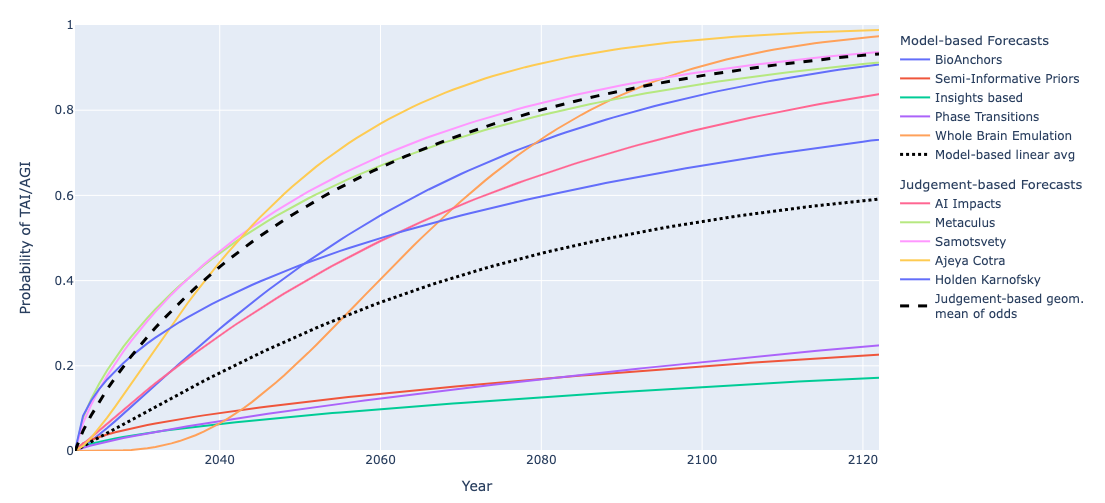
report
·
16 min read
Literature review of transformative artificial intelligence timelines
We summarize and compare several models and forecasts predicting when transformative AI will be developed.
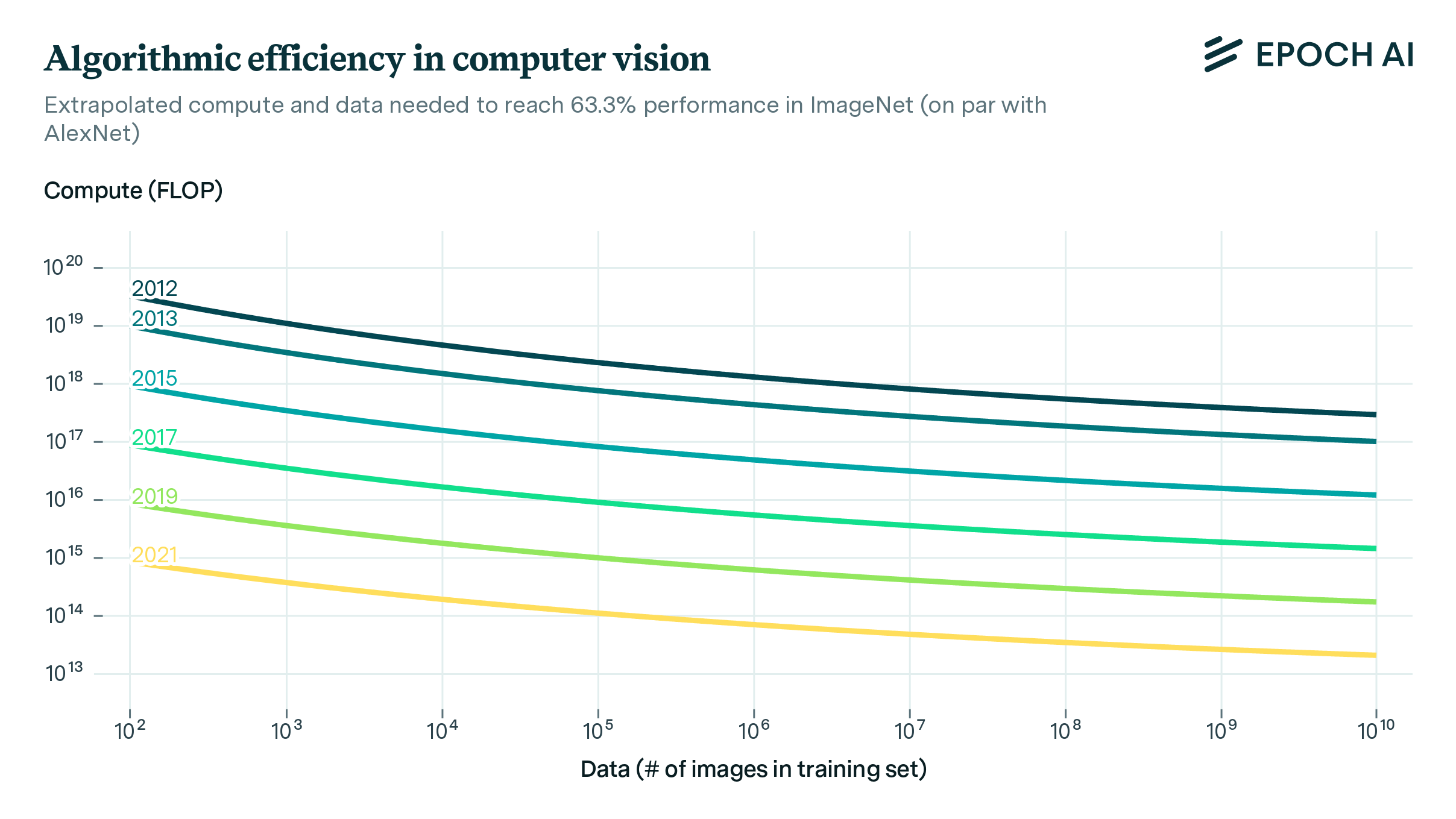
paper
·
2 min read
Revisiting algorithmic progress
Examining over 100 computer vision models, we find that every 9 months, better algorithms contribute the equivalent of a doubling of compute budgets.
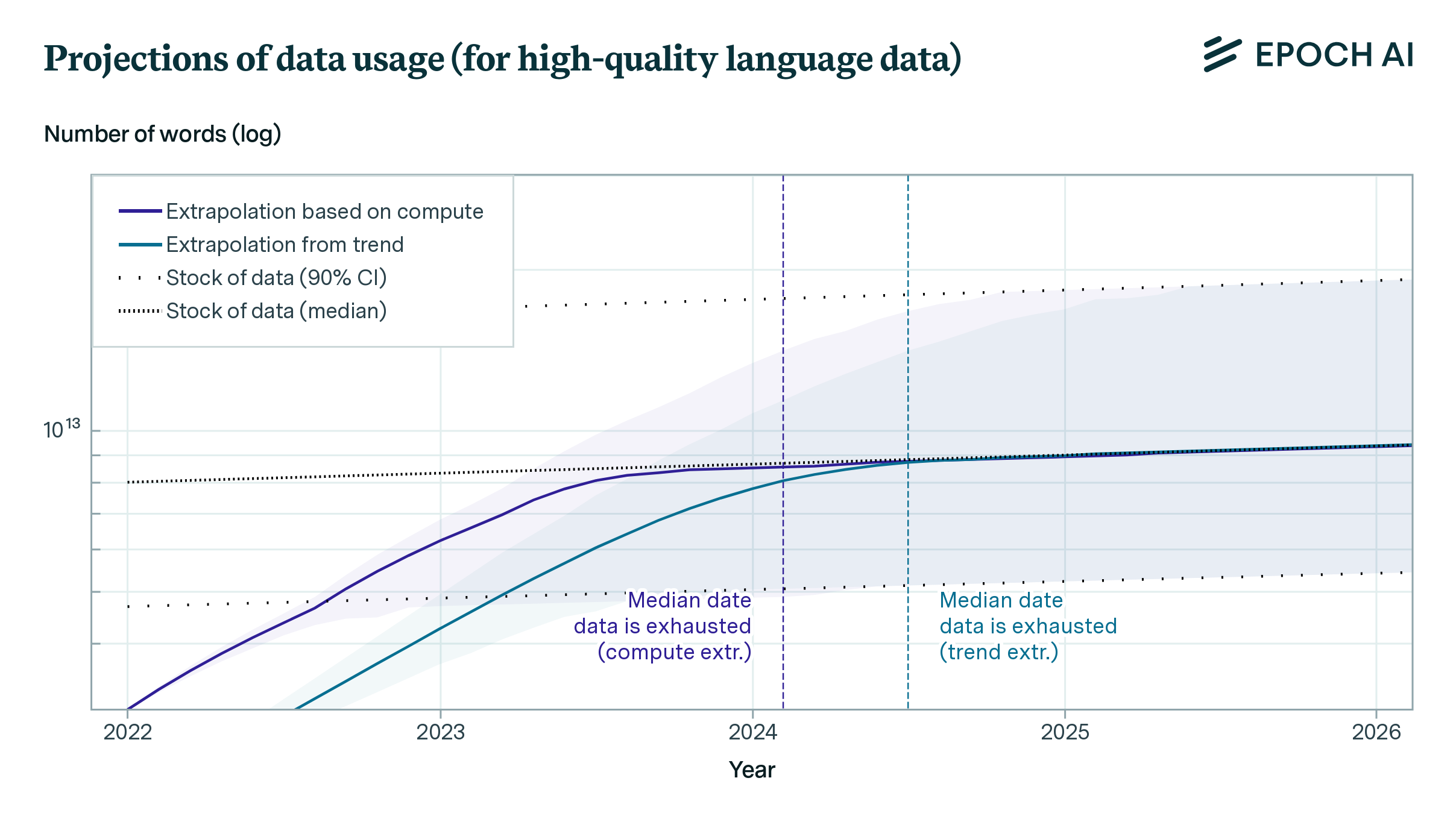
paper
·
3 min read
Will we run out of ML data? Evidence from projecting dataset size trends
We project dataset growth in language and vision domains, estimating future limits to training by evaluating the availability of unlabeled data over time.
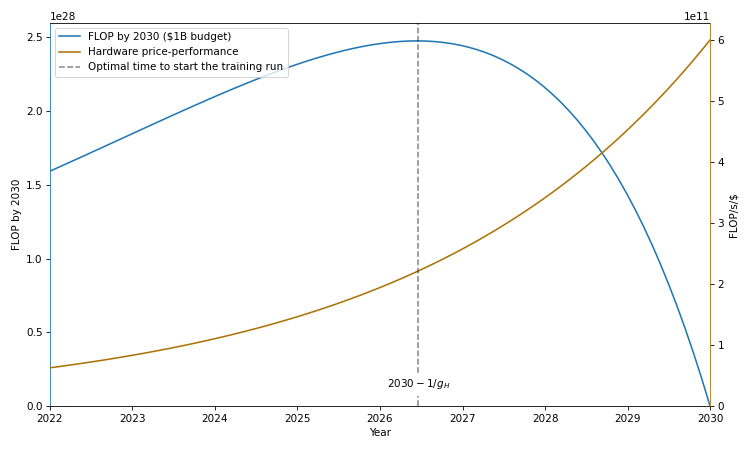
report
·
12 min read
The longest training run
Training runs of large ML systems will likely last less than 14-15 months, as shorter runs starting later use better hardware and algorithms.
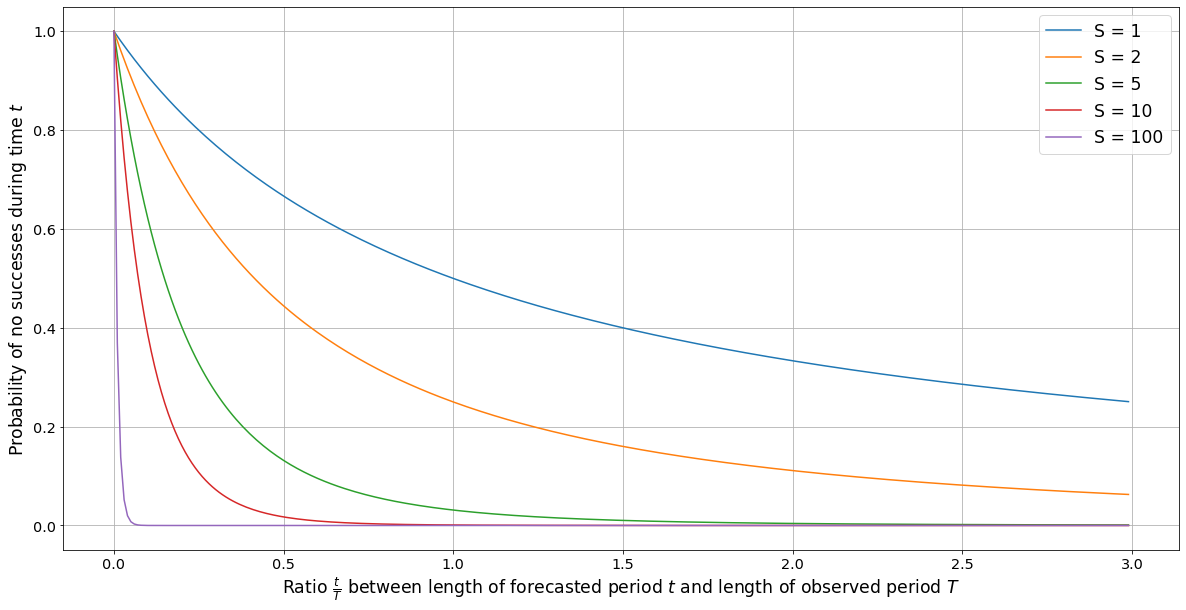
report
·
22 min read
A time-invariant version of Laplace’s rule
We discuss estimating event probabilities with past data, addressing issues with Laplace’s rule and proposing a modification to improve accuracy.
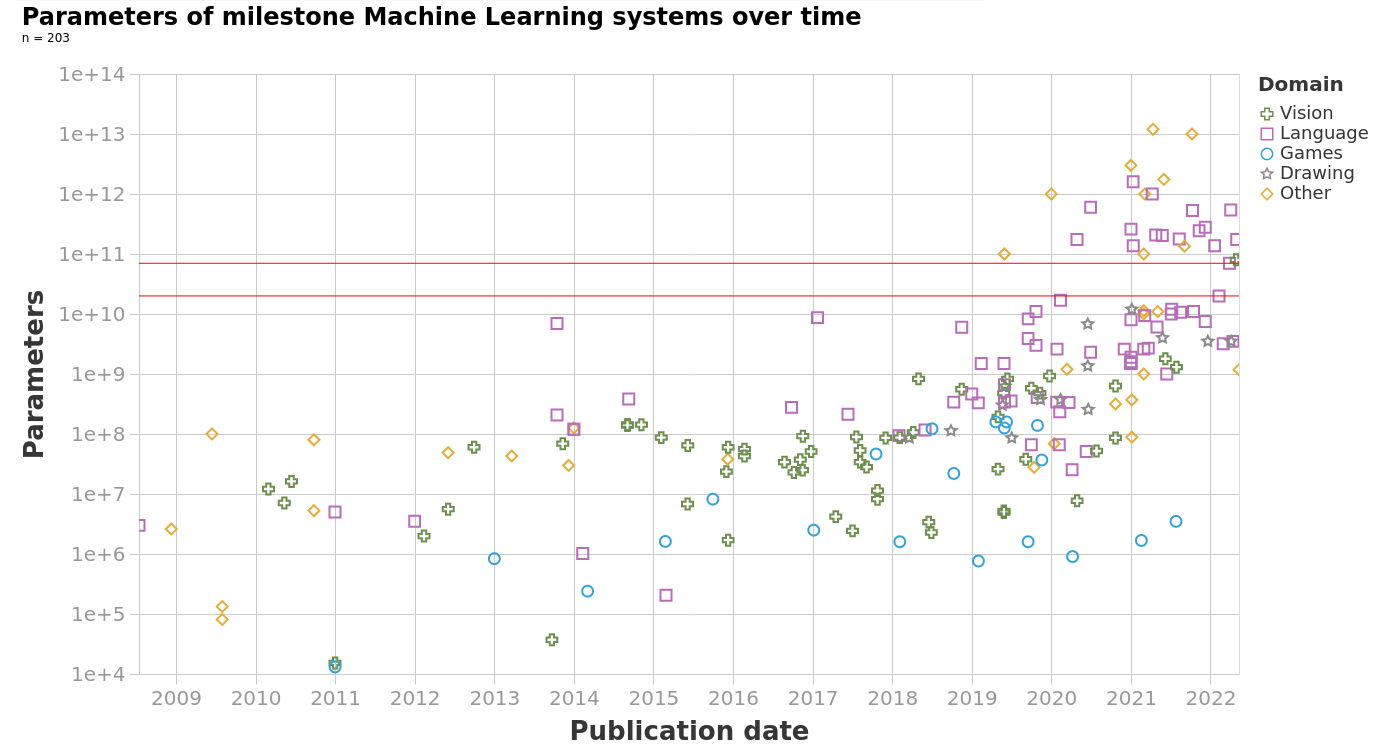
paper
·
2 min read
Machine learning model sizes and the parameter gap
Since 2018, the size of ML models has been growing 10 times faster than before. Around 2020, model sizes saw a significant jump, increasing by 1OOM.
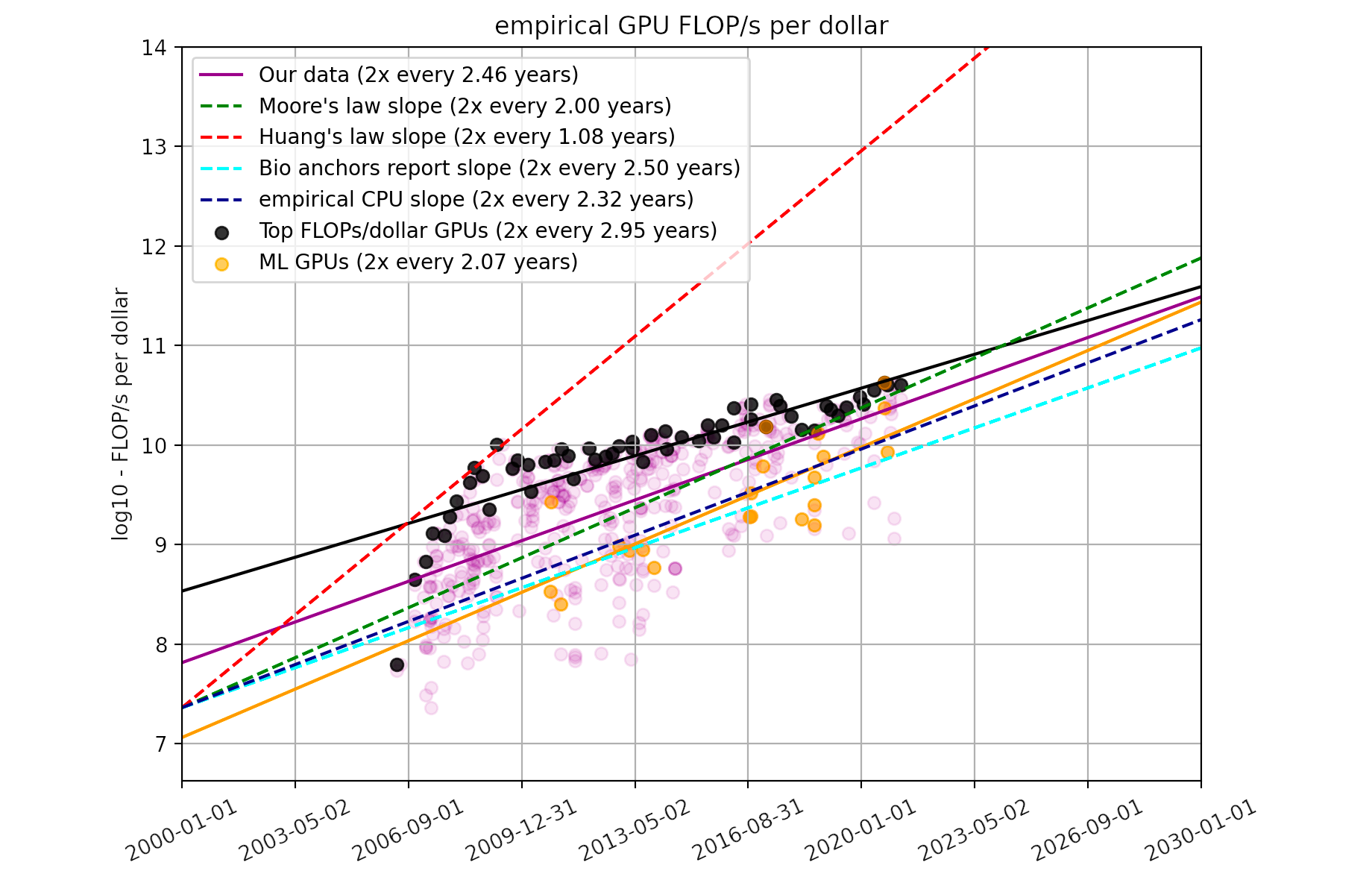
report
·
14 min read
Trends in GPU price-performance
Improvements in hardware are central to AI progress. Using data on 470 GPUs from 2006 to 2021, we find that FLOP/s per dollar doubles every ~2.5 years.

update
·
4 min read
Announcing Epoch AI: A research initiative investigating the road to transformative AI
We are a new research initiative forecasting developments in AI. Come join us!
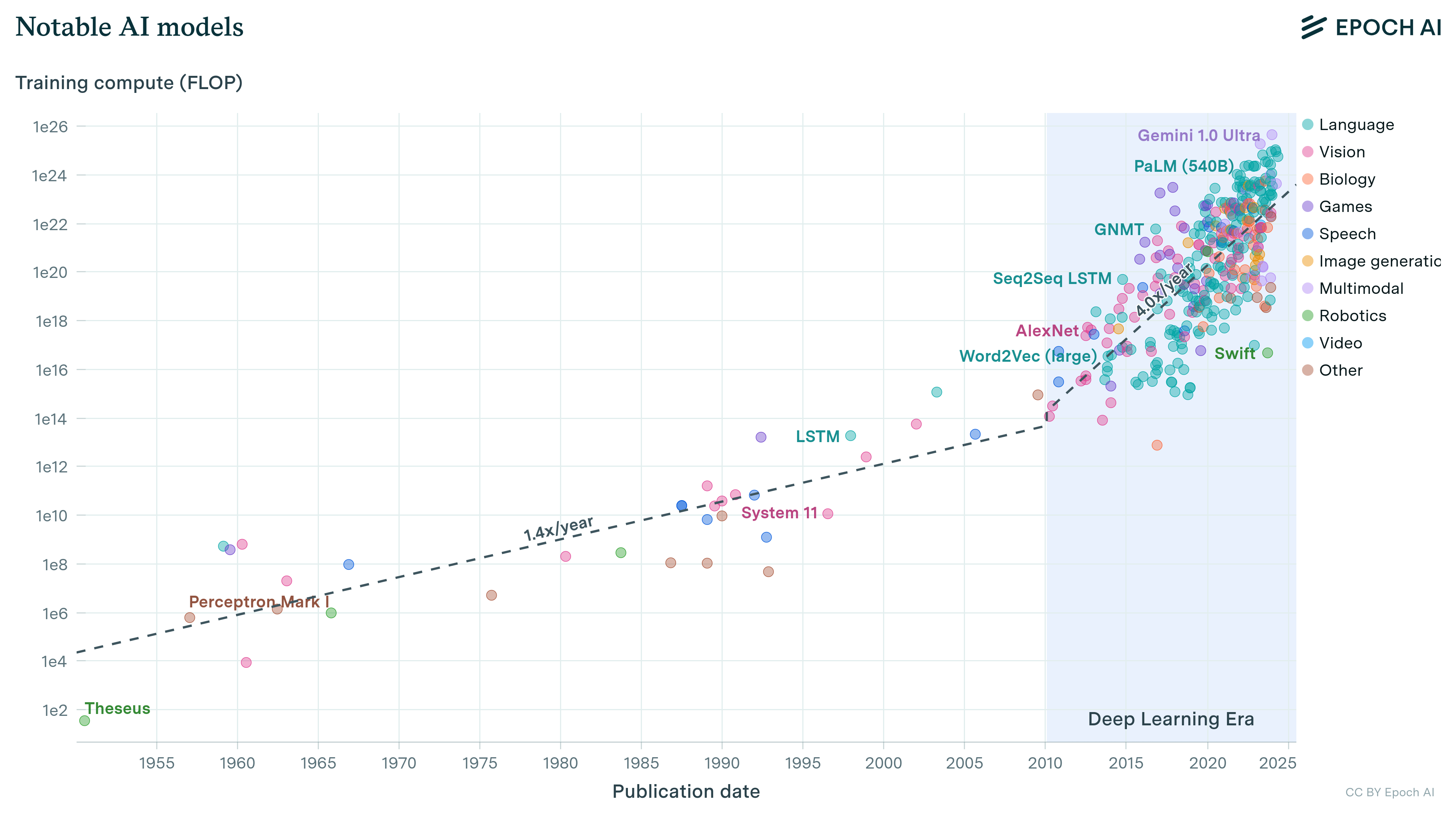
paper
·
7 min read
Compute trends across three eras of machine learning
We’ve compiled a comprehensive dataset of the training compute of AI models, providing key insights into AI development.
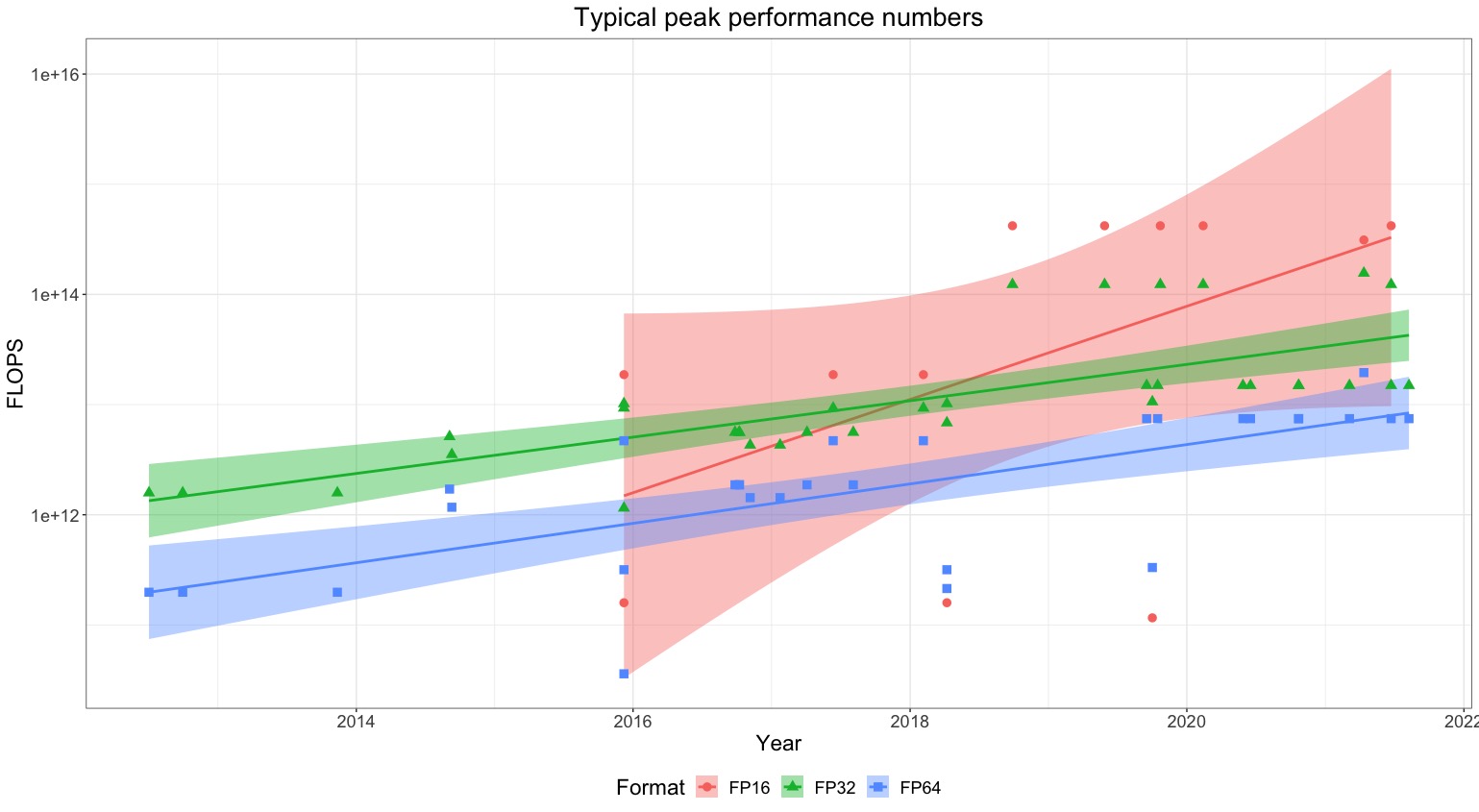
report
·
24 min read
Estimating training compute of deep learning models
We describe two approaches for estimating the training compute of Deep Learning systems, by counting operations and looking at GPU time.

report
·
8 min read
What’s the backward-forward FLOP ratio for neural networks?
Determining the backward-forward FLOP ratio for neural networks, to help calculate their total training compute.
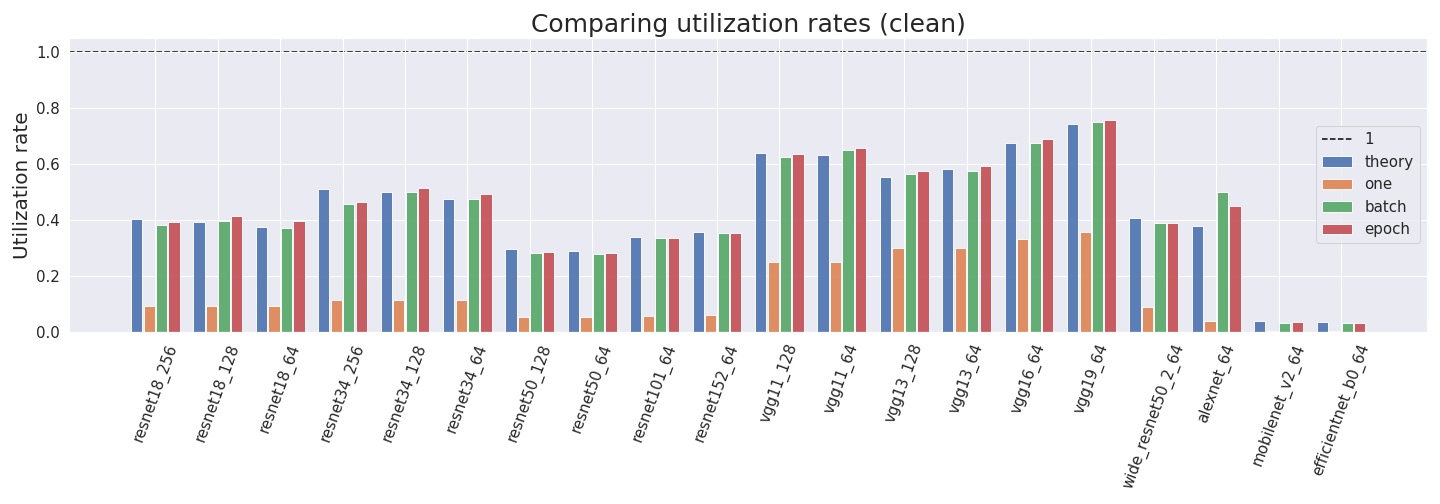
report
·
9 min read
How to measure FLOP for neural networks empirically?
Computing the utilization rate for multiple Neural Network architectures.

